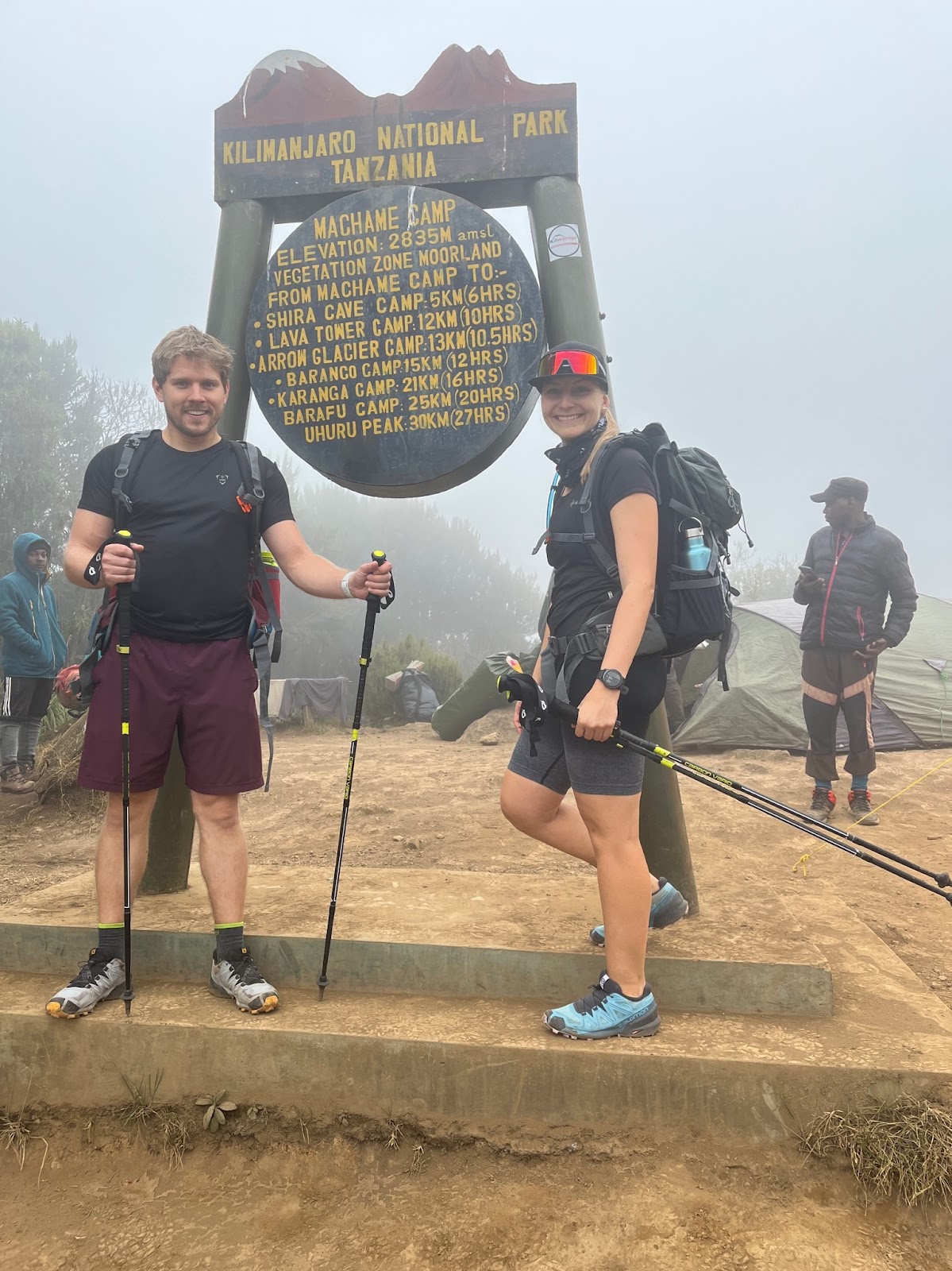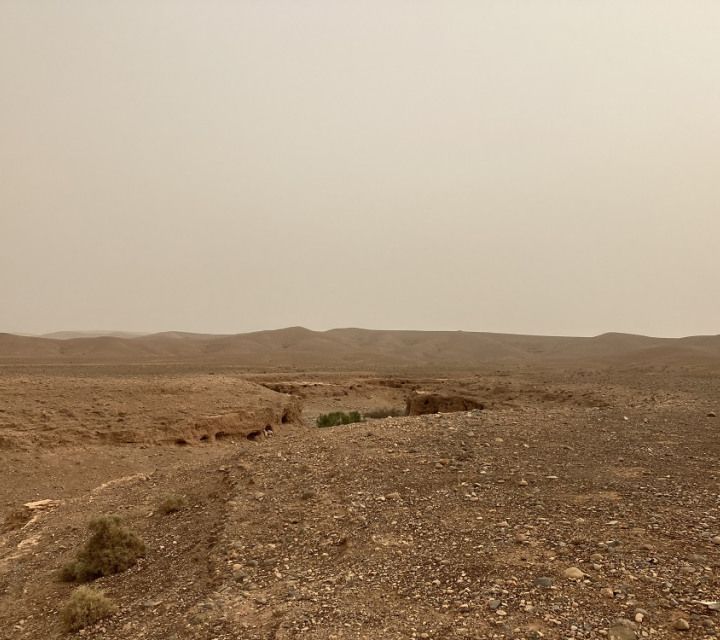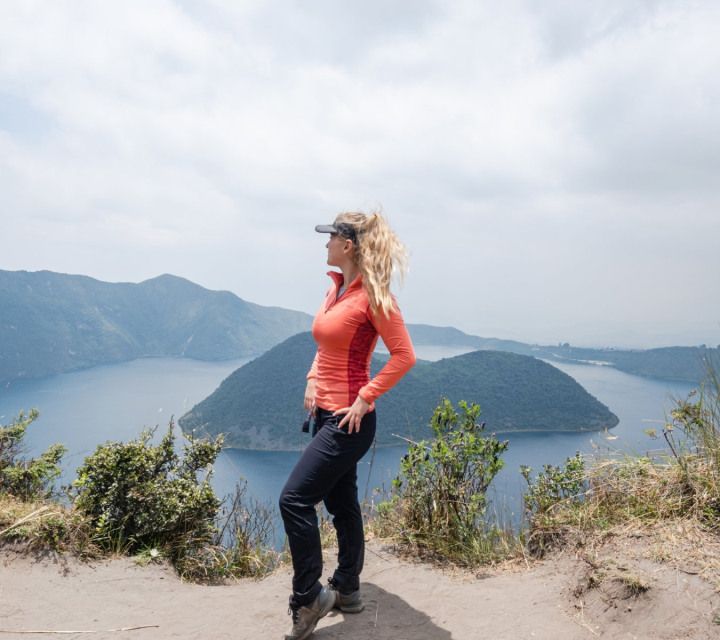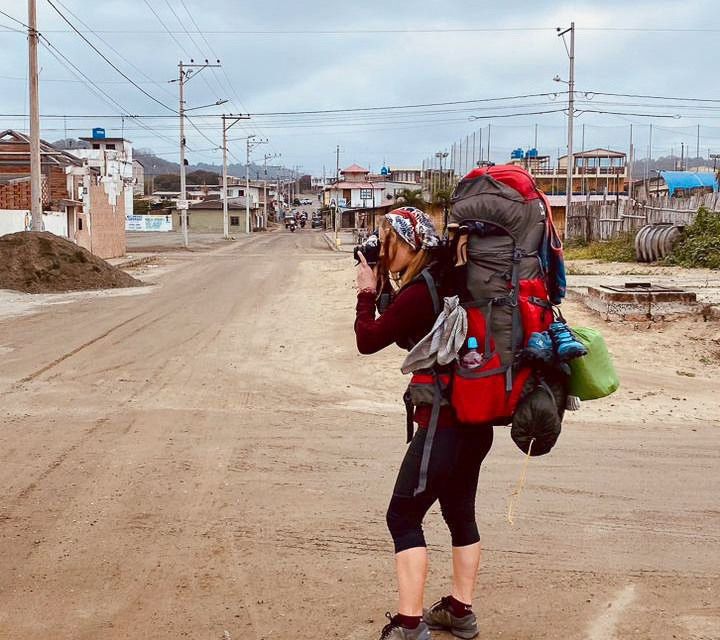The trip to Kilimanjaro started of course by packing. The list of what to take was really long, but space in my backpack was limited. Moreover, I thought I would carry everything on my own and that makes you think about what you really need and what is excess :)

Kilimanjaro Day 1.
MACHAME GATE 1,800M ABOVE SEA LEVEL -> MACHAME CAMP 2,835M ABOVE SEA LEVEL
We chose the Machame route, or Whiskey route as it is also called (unfortunately not because of the fact that they serve chilled Whiskey on the way, but it is the name given for a moderately demanding route :)). The start of this route starts at 1800m above sea level and you are often stuck at the gate for quite some time, as there is a document and baggage check (like at the airport) for all team members. There are ten of us in total, only two of us are "tourists" and the rest of the team are guides, porters and a cook.
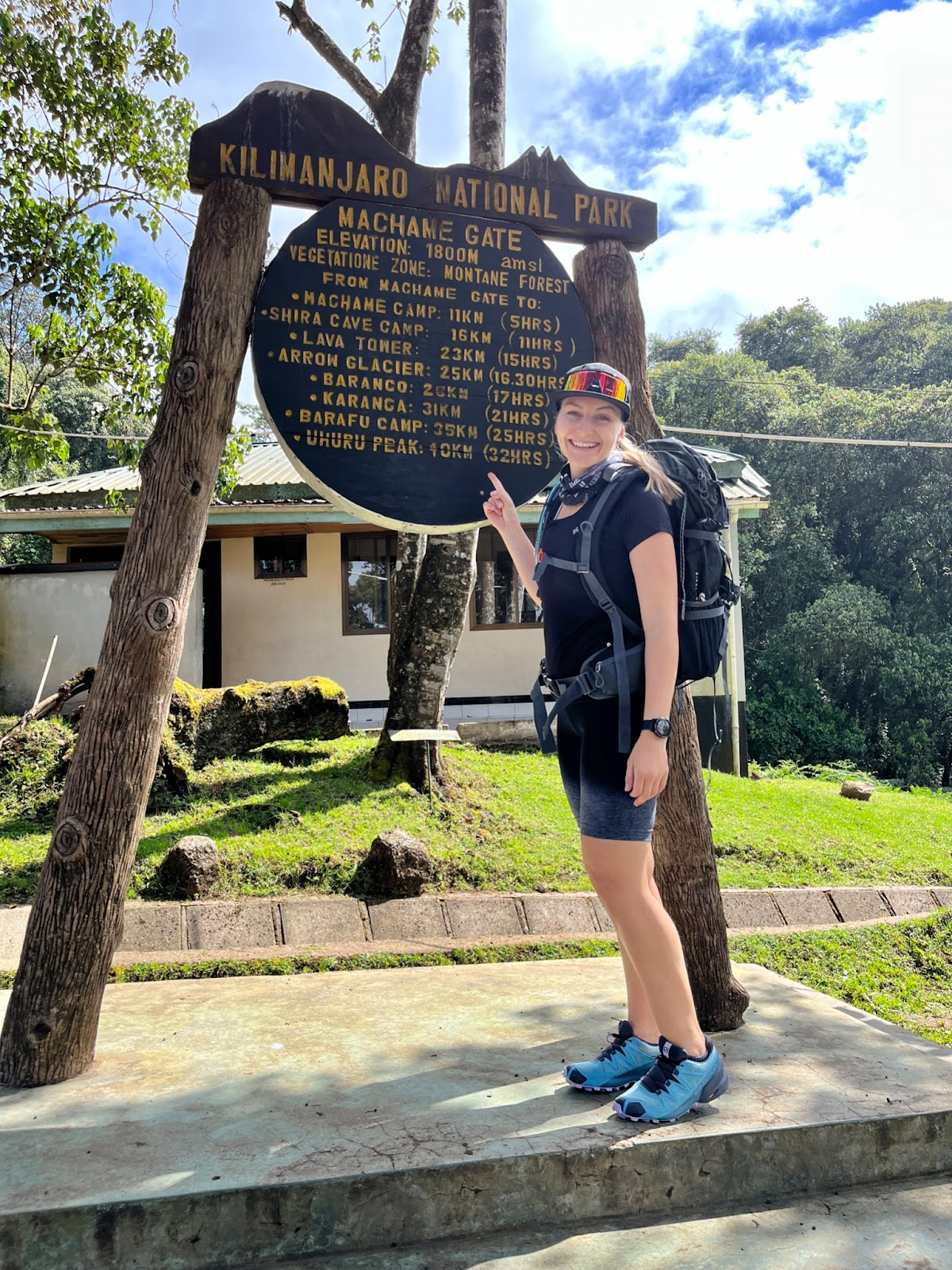
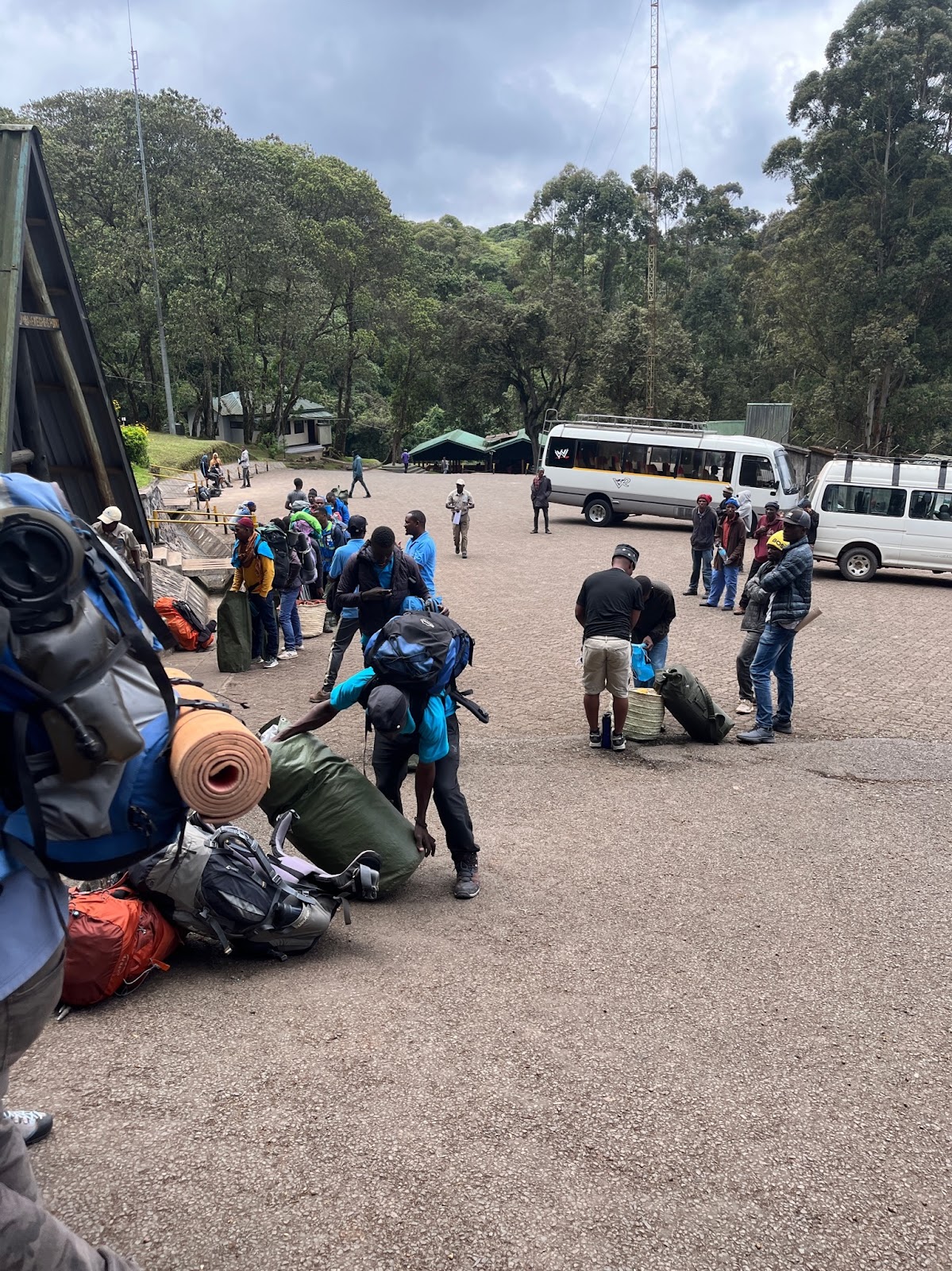
From the Machame gate to the first campsite it is eleven kilometres with a steady climb, taking us some four and a half hours. The first day takes us through a rainforest which is full of animals, especially various species of monkeys and parrots. The main difference on Kilimanjaro compared to normal hiking is that you have a several-day climb ahead of you, which has a massive altitude and you don't know how your body will react and so the guides make you take it very slowly - which we are not used to at all and it was rather unusual. On the way up you are overtaken by load-carriers carrying gear on their backs and on their heads, without any alpine equipment, often in jeans and boots full of holes. Gradually, the rainforest is turning into moorland, or heathland, and now the green is just starting to diminish.
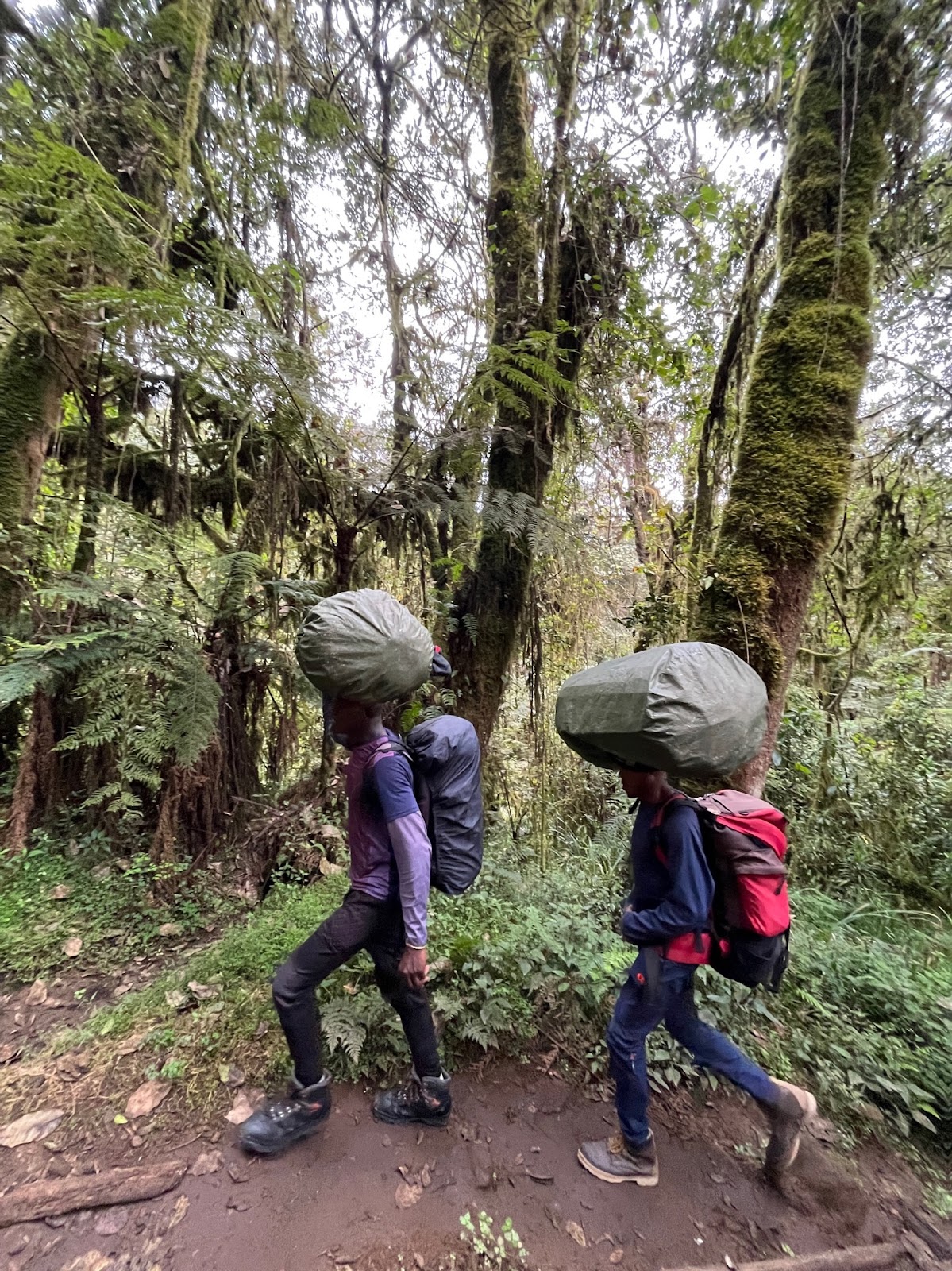
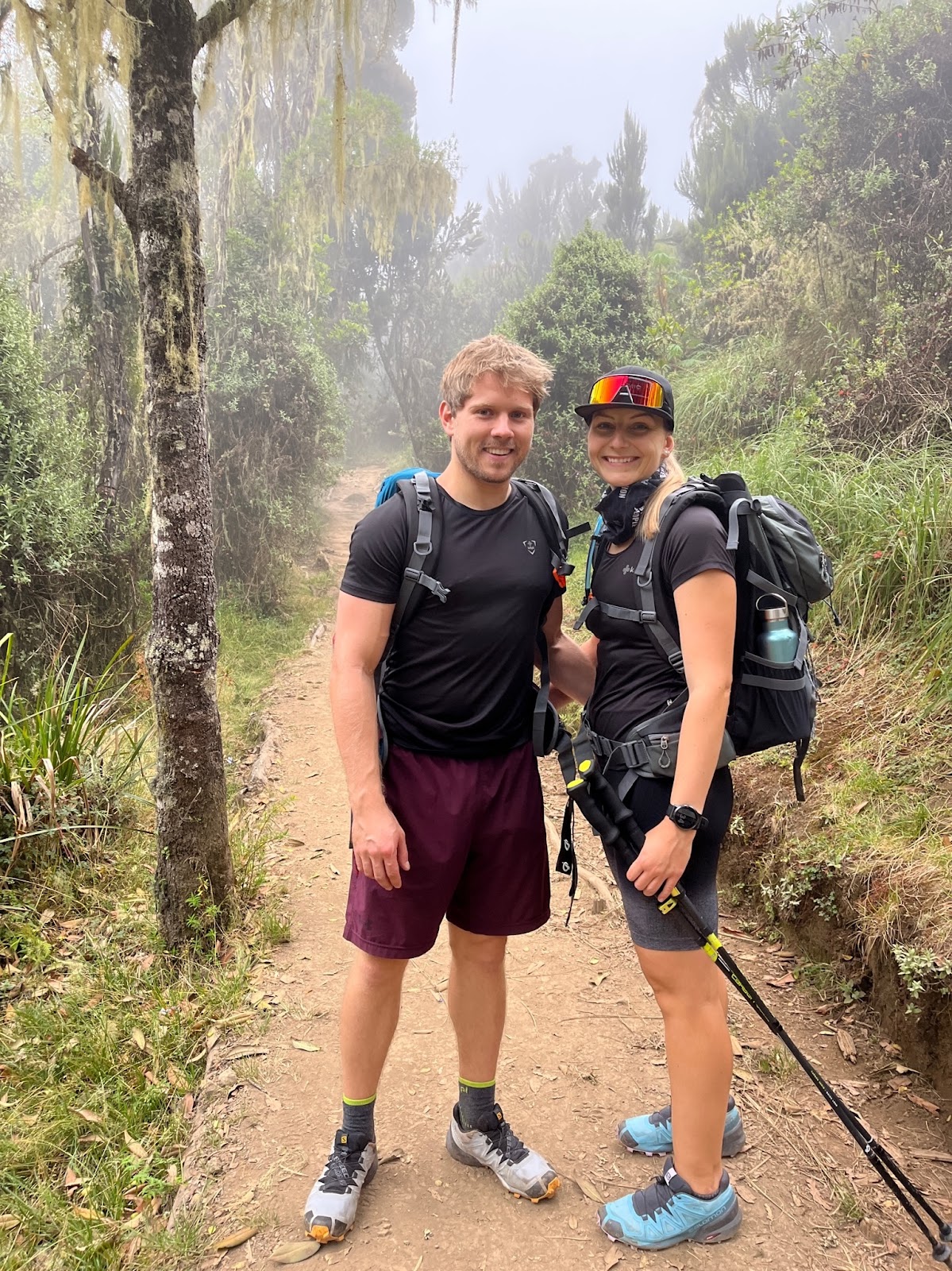
When we arrived at the first campsite - the Machame camp (2.835m above sea level) our tents were already set up and we just unpacked our backpacks with our clothing and sleeping bags. We immediately changed from our shorts and short sleeved T-shirt (DIMARO-W) into warmer clothes and we decided to take a walk around the campsite. However, it was foggy so we couldn't even see Kilimanjaro. When we got back to our tent, a popcorn snack was waiting for us, followed by hot soup and a typical African dinner.

Kilimanjaro Day 2.
MACHAME CAMP 2,835M ABOVE SEA LEVEL -> SHIRA CAVE CAMP
A wake-up call at 6:30, a quick breakfast and we are off, because today is beautiful and the sun will be very strong, so the sooner we are at the camp the better. From the Machame campsite to the Shira Cave campsite is only five kilometres, but today's section is rocky and overall a more challenging route than yesterday and as we have to go slowly to acclimatise the body, we will walk for about six hours. Snail pace :D
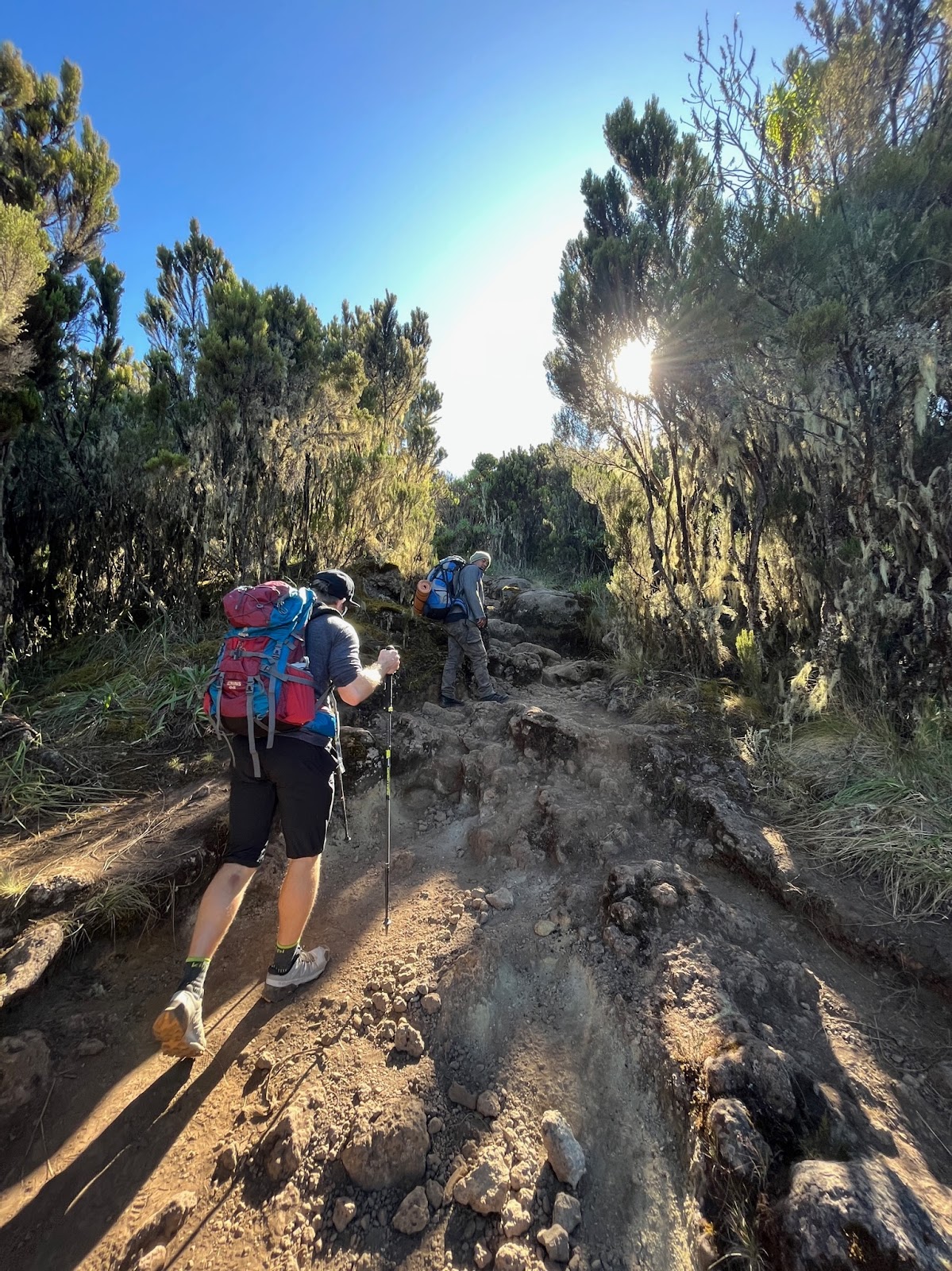
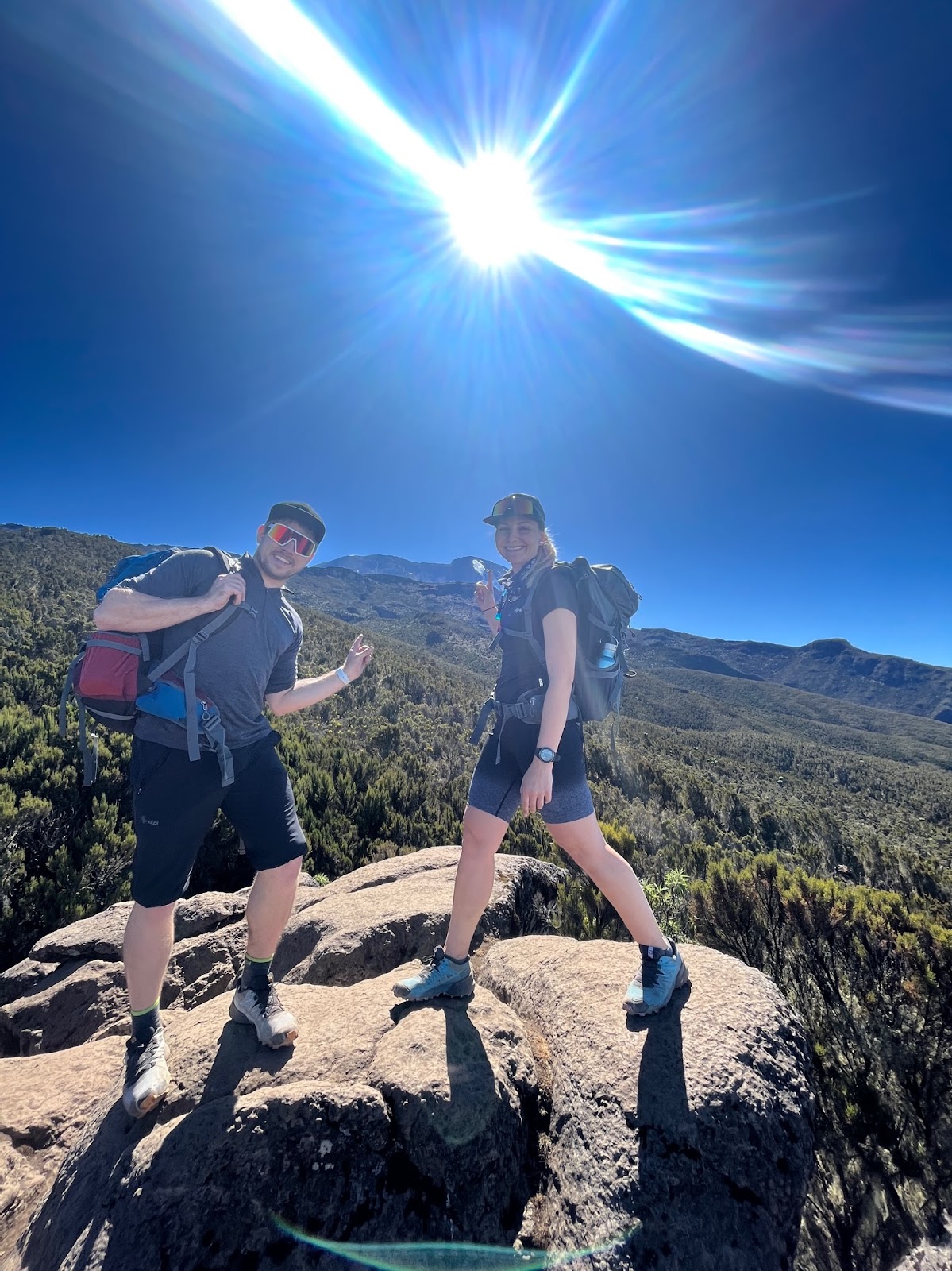
The terrain was rocky and very challenging in places, but when you are overtaken by a load carrier with a twenty-kilogram load on his head without any problem, you realise it's actually fine :) The weather was good for us and that's the reason why we finally saw our destination - the summit of Mount Kilimanjaro. Mount Meru (4,562.13m above sea level) also emerged from the clouds, which is often recommended for acclimatisation before heading to Kilimanjaro (we didn't go to Mt. Meru).
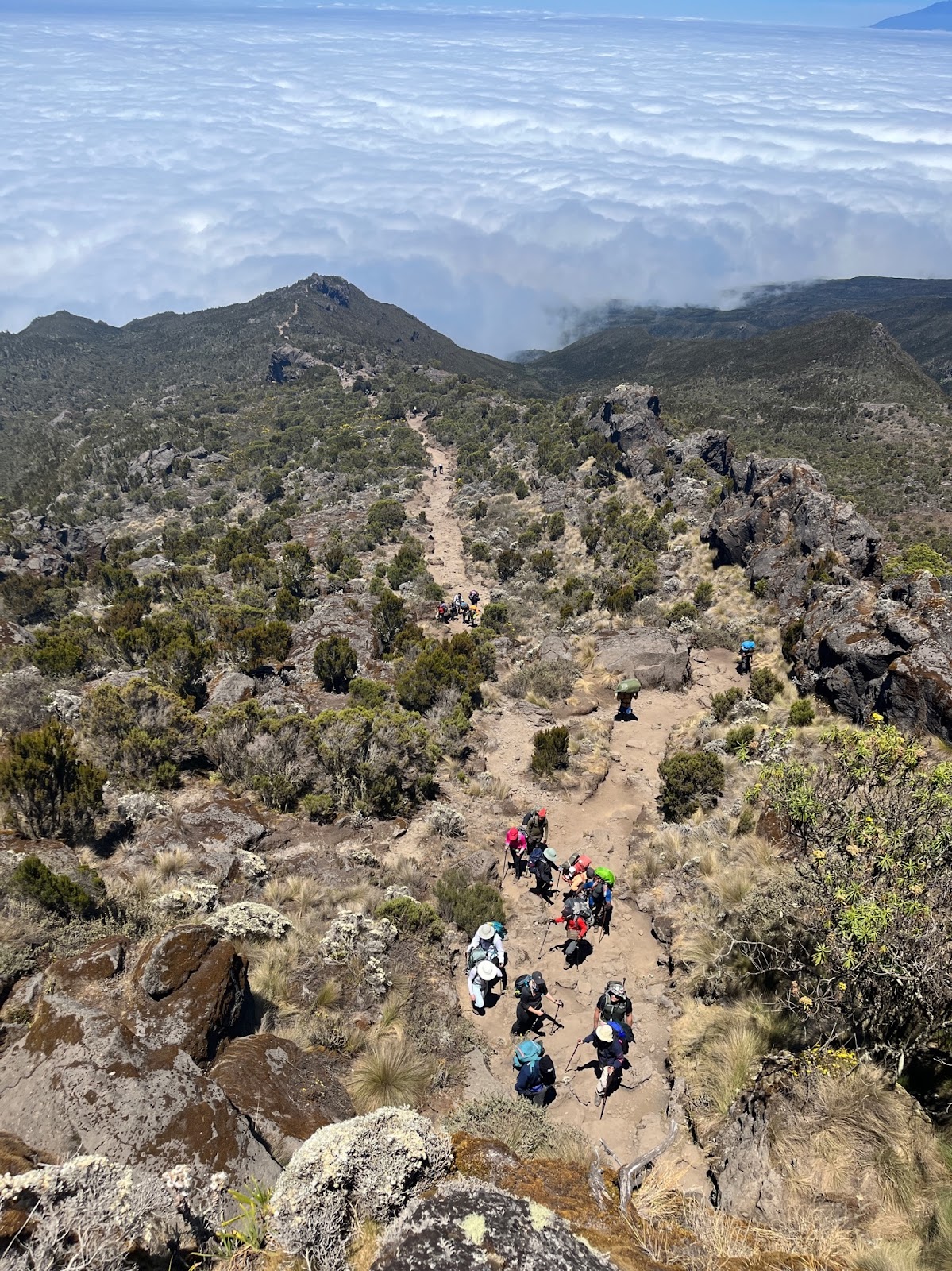
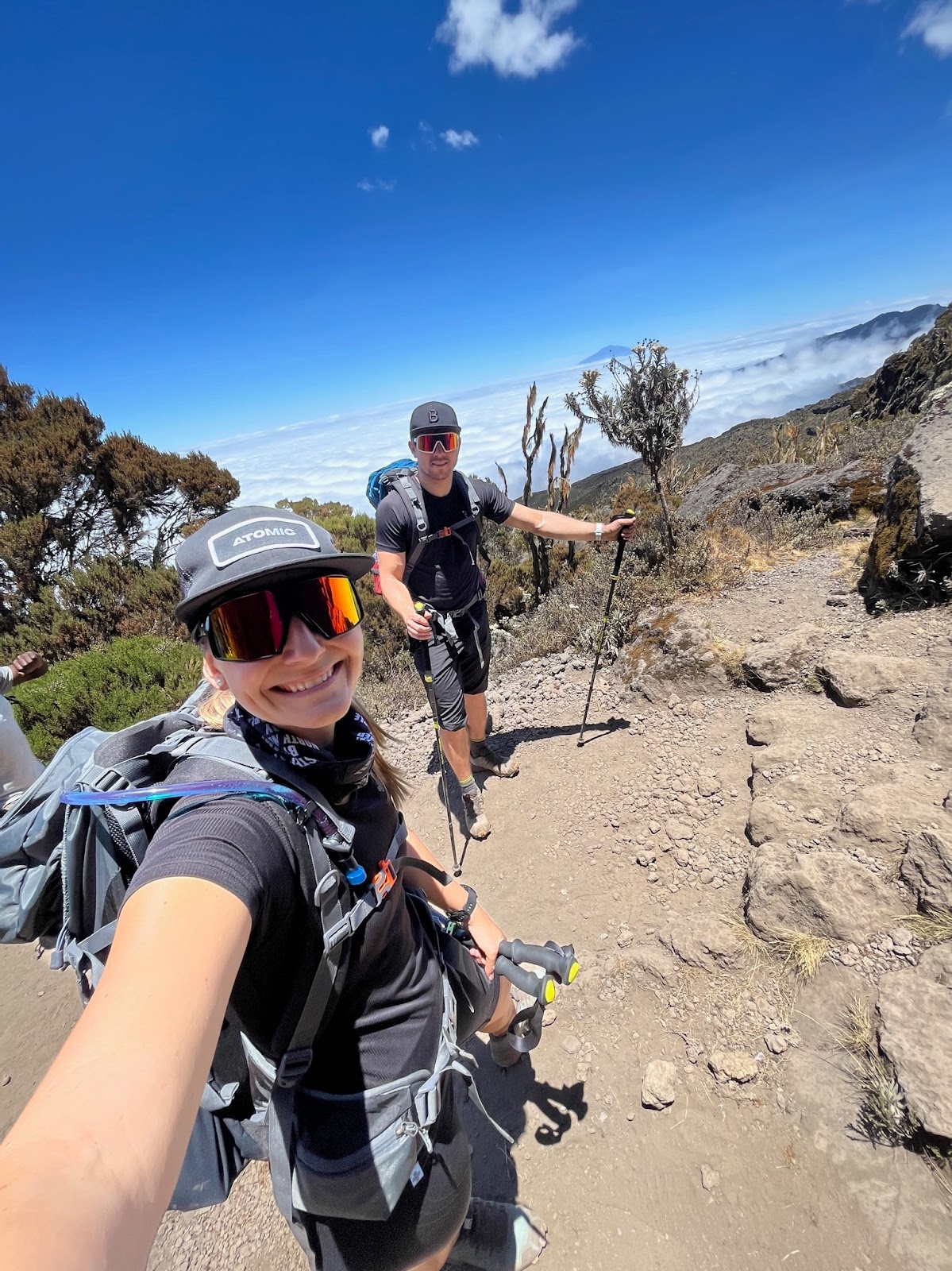
We arrived at the Shira Cave campsite (3,750m above sea level) sometime around noon, and our tents were again set up. The way it usually works is that you wake up in the morning, eat breakfast, pack your clothes, camping mat and sleeping bag and the load carriers take care of the rest. The load carriers, who stay longer at the previous campsite, pack everything up and then they beat you to it and unpack everything at the next campsite so that everything is ready before you arrive. What a luxury!
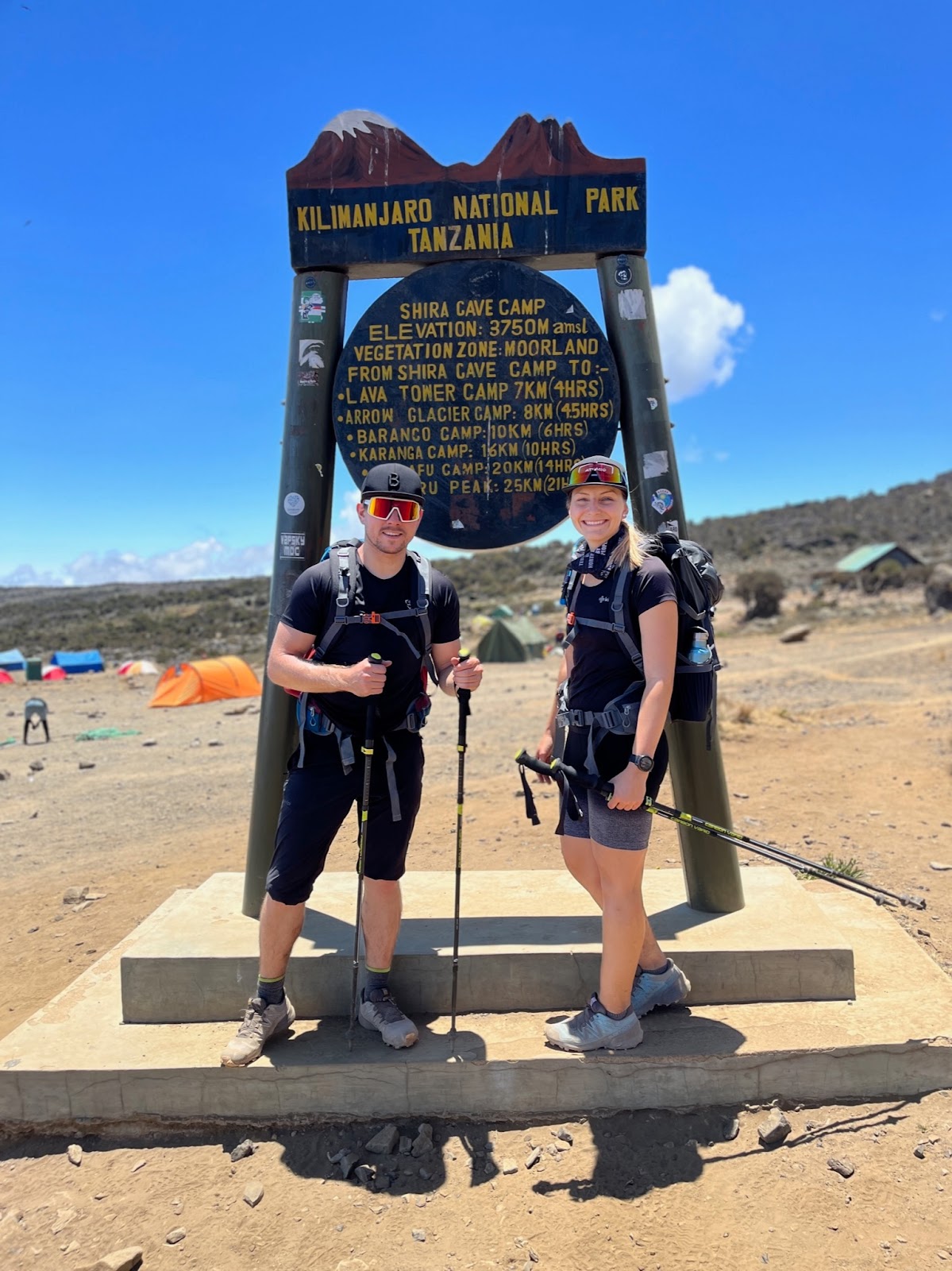
The plan for each day is to go high, but sleep low, to give the body room to acclimatise, and that's why after lunch we go for a short two-hour acclimatisation walk up to 3,950m above sea level. Then back to the camp where a traditional Kilimanjaro ritual awaits us, where the entire team sings a song about Kilimanjaro, and at the same time we get acquainted with our entire team consisting of two guides (James and Mambo), one cook (Emanuel) and seven load carriers (Ringo, Husain, Widi, Saitochi, Emil, Steward, Mudi).
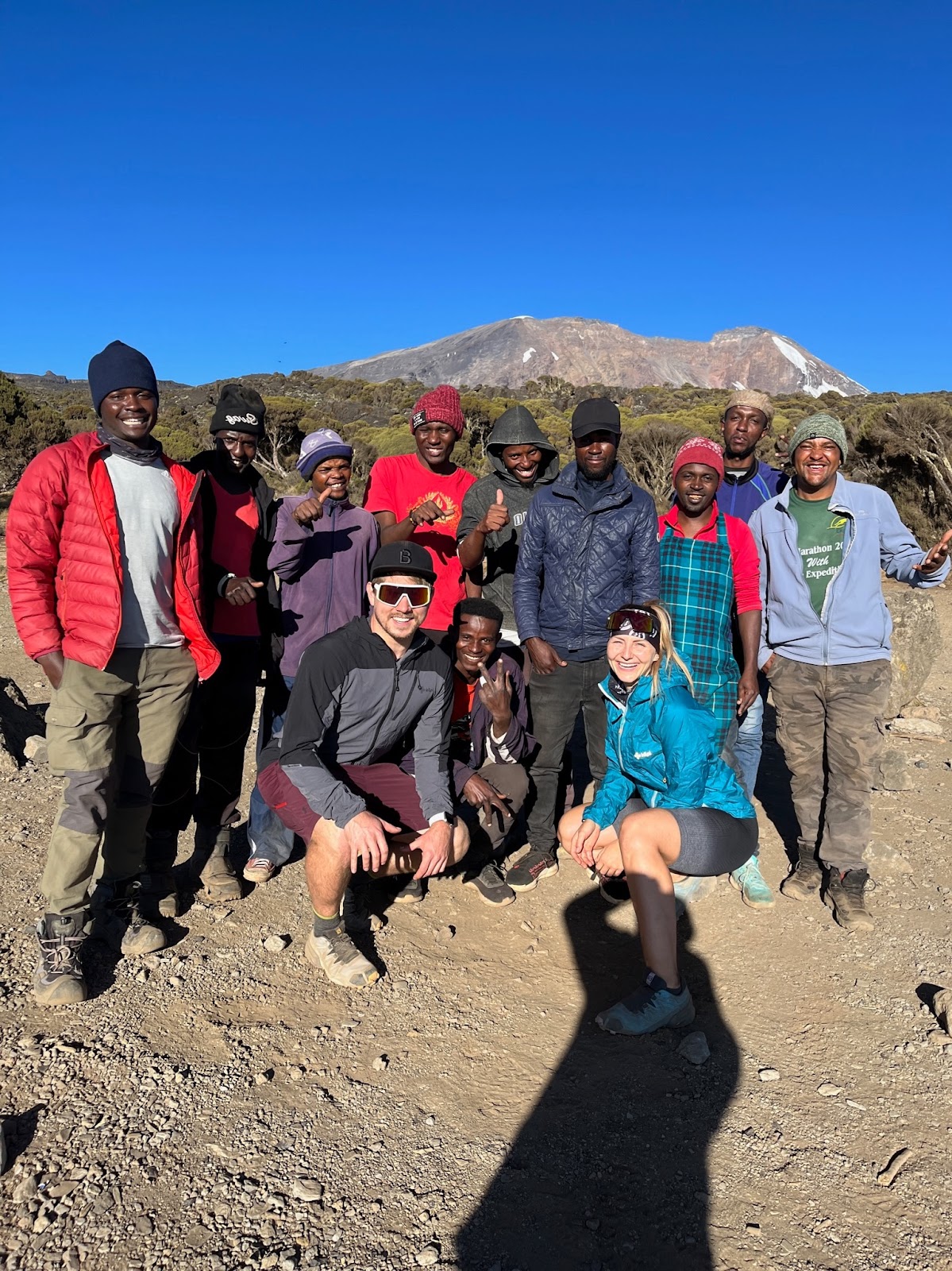
The Shira Cave camp is famous for its beautiful sunsets and that it is for certain - I don't think I have ever seen a more beautiful sunset than here on Kilimanjaro. But as soon as the sun starts to set, it cools down immediately and at night the temperature drops below freezing.
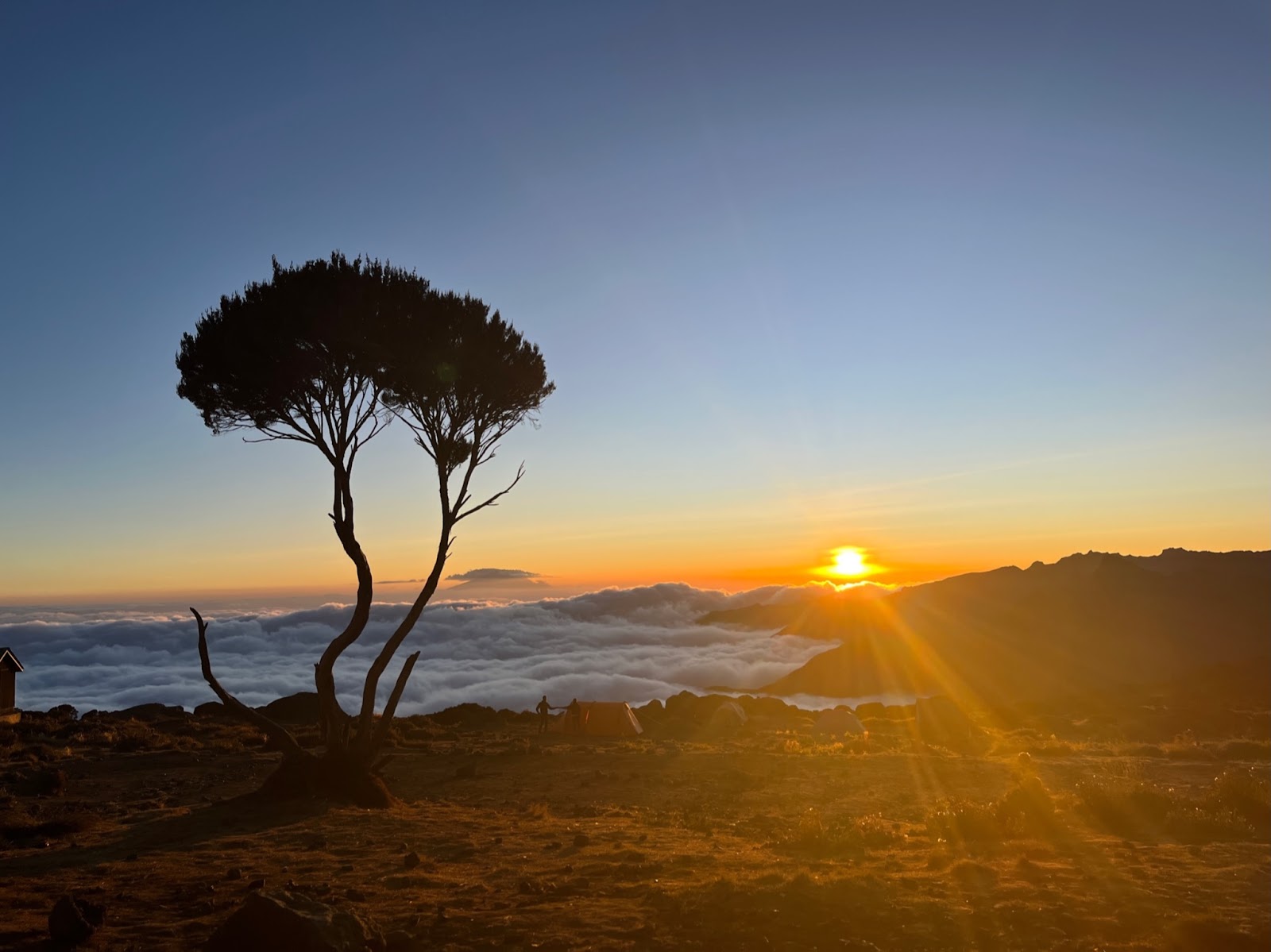
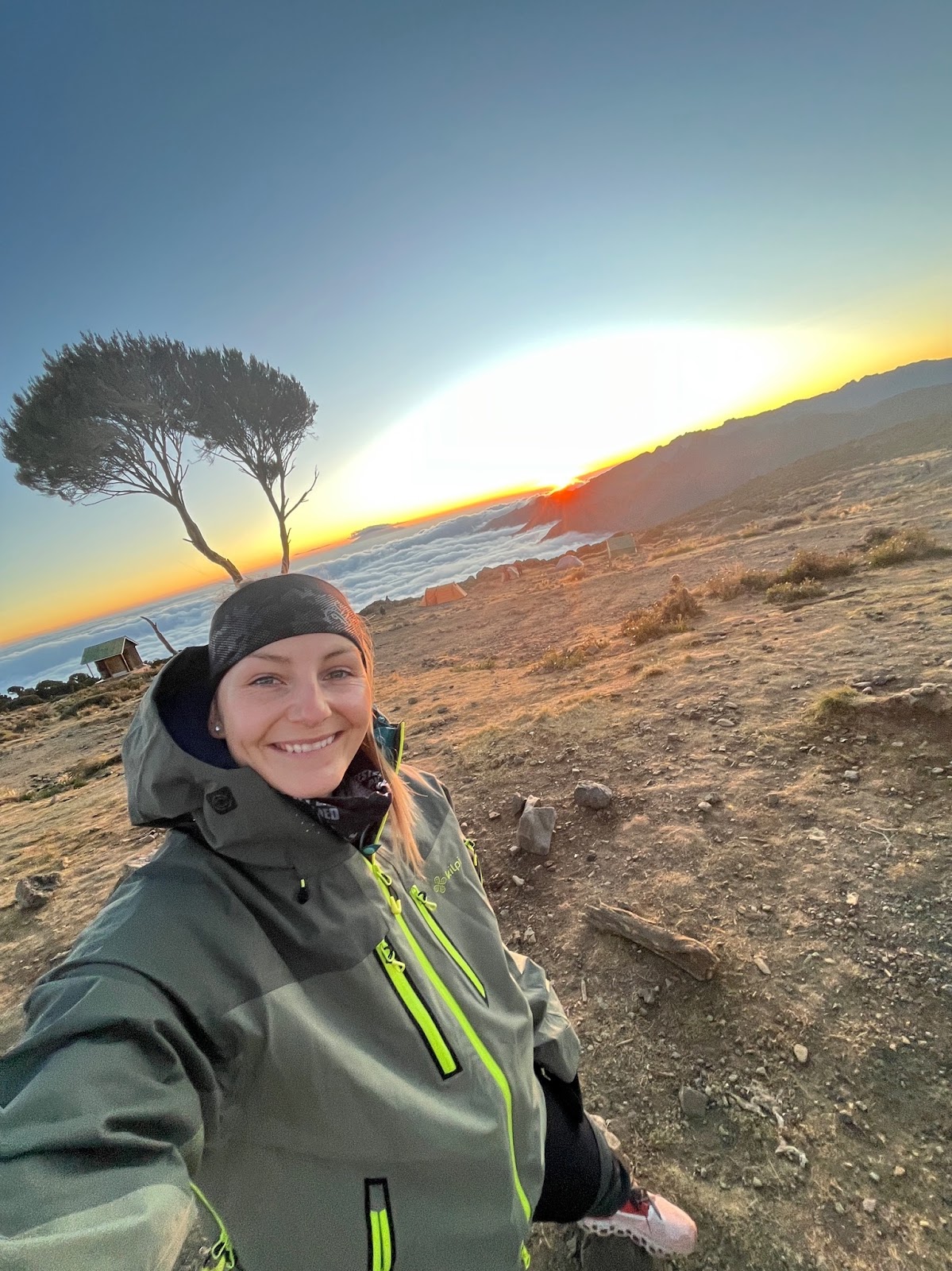
Kilimanjaro Day 3.
SHIRA CAVE CAMP -> LAVA TOWER -> BARRANCO CAMP
Again, the third day starts early in the morning with breakfast, packing and heading out, as we have a longer stretch ahead of us today. Today is a day of acclimatisation as we climb to 4,900m above sea level (Lava Tower) and then descend to the campsite at 3,900m above sea level (Barranco camp) where we will spend the night. It is only six kilometres from the Shira Cave camp to the Lava Tower, but as we climb to higher ground the walking pace is slow and it will take us about four hours to get there and then another two hours to the Barranco camp. The heath is gradually becoming an Alpine desert with only moss-covered rocks around us.
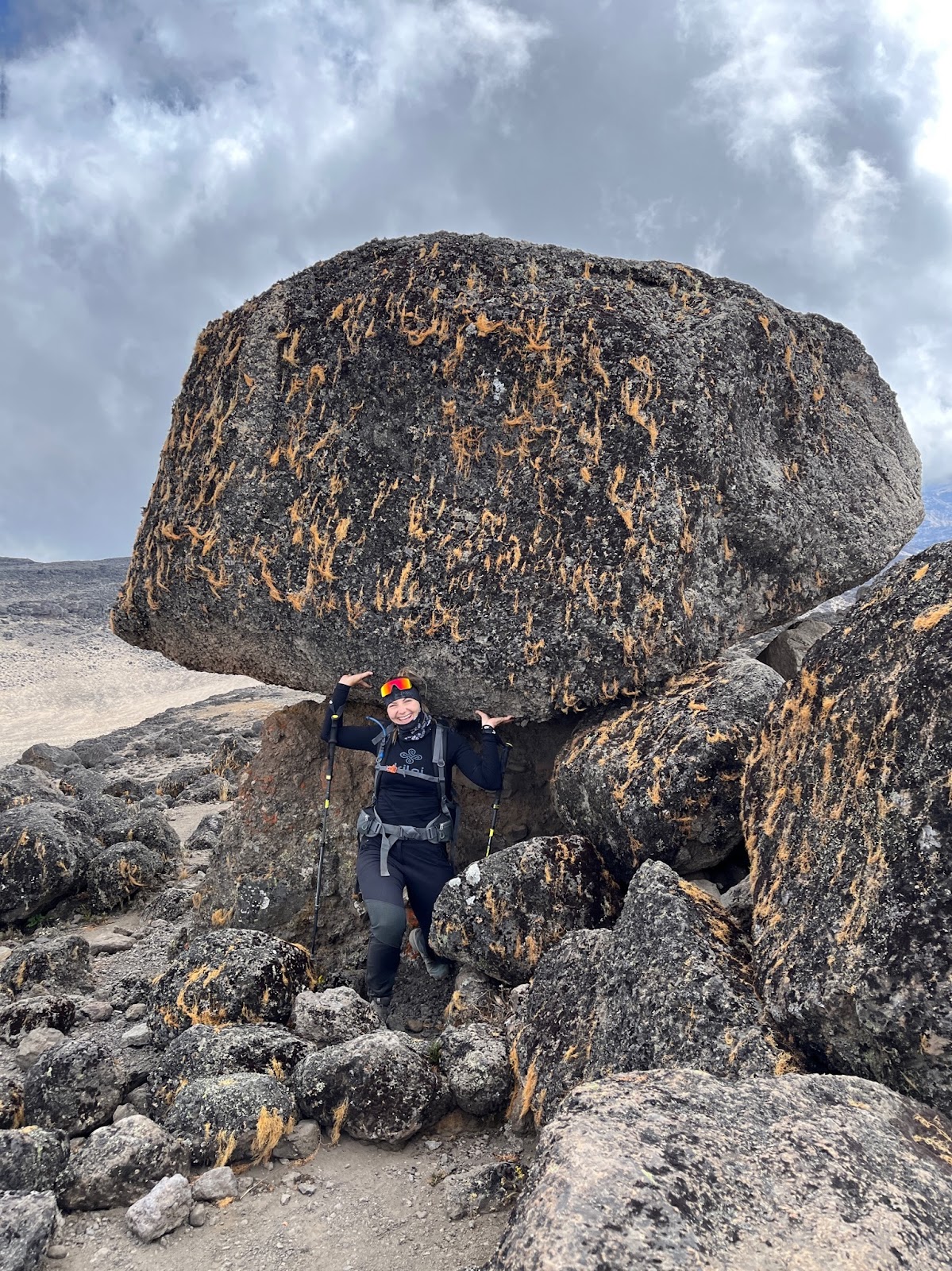
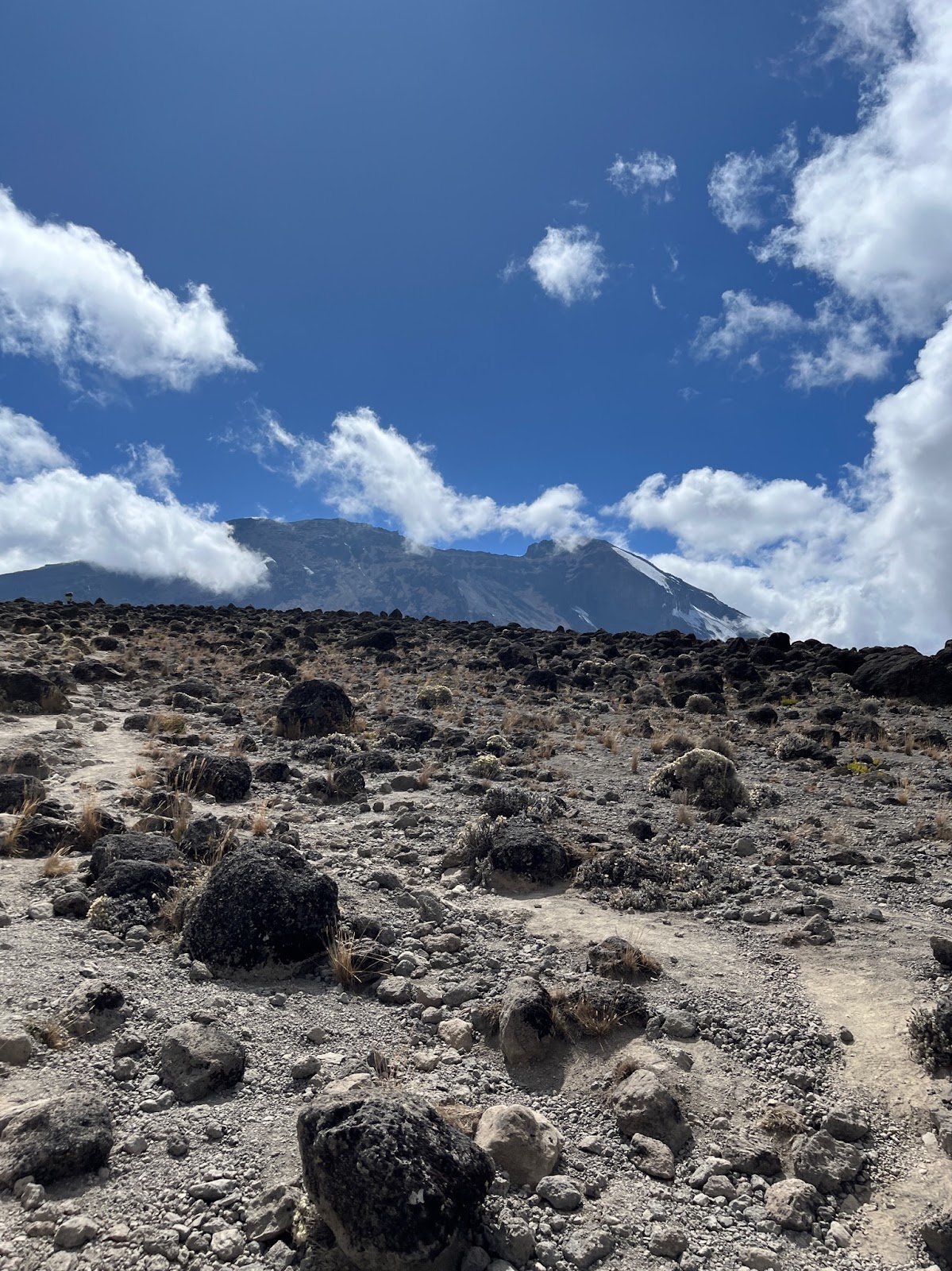
We always get breakfast, lunch and dinner from the cook, and during the day we only have a little something that we have brought ourselves, be it a bar or fruit. The cook made us pancakes for breakfast today, and since we didn't eat them all, we packed them for the road and had a great snack. The guides told us that it is important to eat as much as you can while you still have an appetite as you lose your desire to eat and energy at higher altitudes. We have not suffered from any of these problems yet and hopefully we won't :)
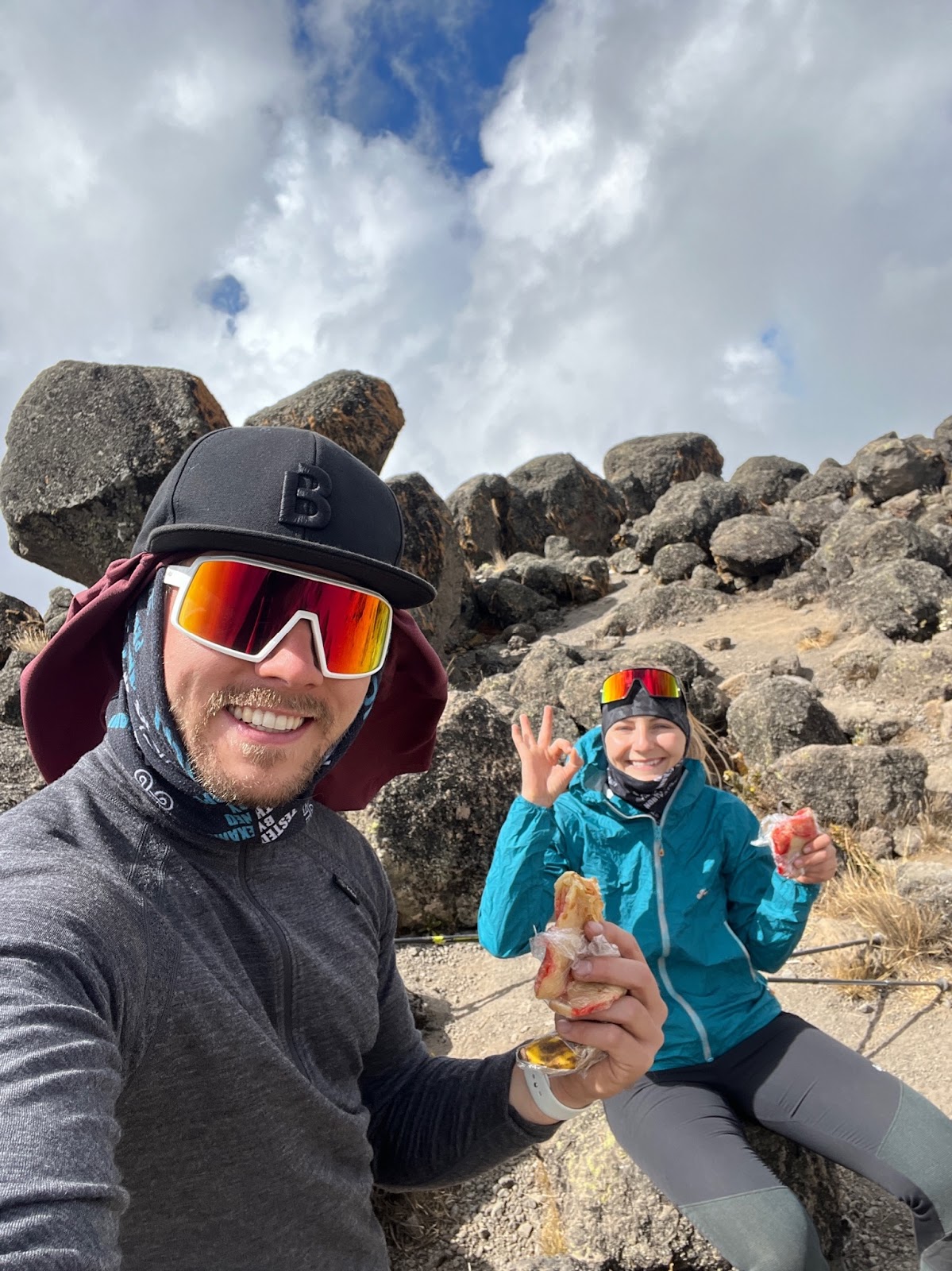
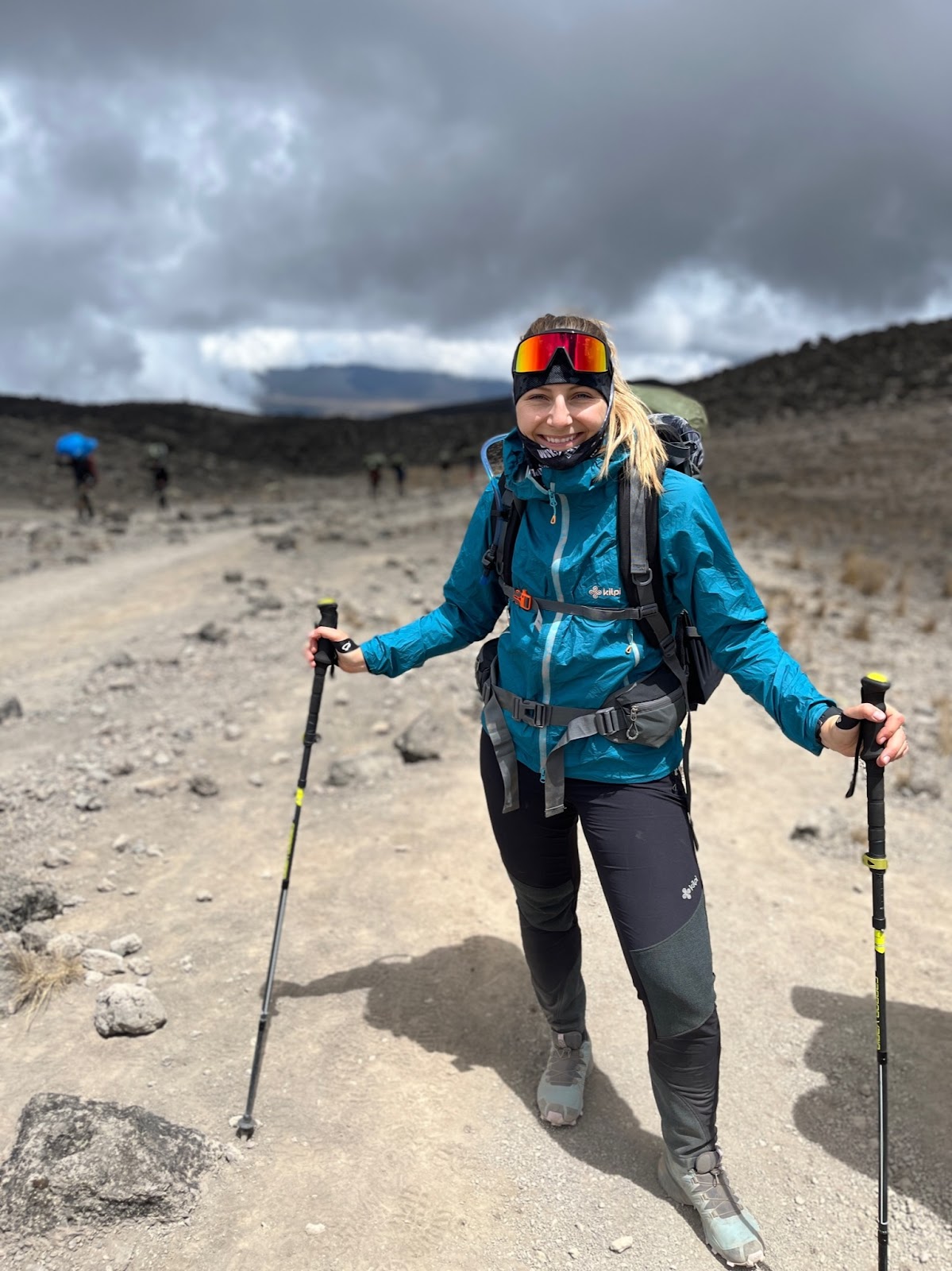
Today two routes are joining up, Machame and Lemosho, with all the tourists and their guides heading to the Lava Tower to acclimatise before descending to the Barranco campsite. The Lava Tower is a campsite that is not usually intended for overnight stays, but is in most cases used as an acclimatisation point, where you ascend to an altitude of 4,600m and then descend to an altitude of 3,900m.

Source: ( https://www.kilimanjaro-experience.com/routes/machame/)
The larger groups have lunch in tents at the Lava Tower camp and then continue on, but since we are a small group, we agreed that there is no need for the rest of the team to go to the Lava Tower camp with us just to prepare lunch, but they can take a shortcut and go straight from the Shira Cave camp to the Barranco camp where we will meet at the end of the day.
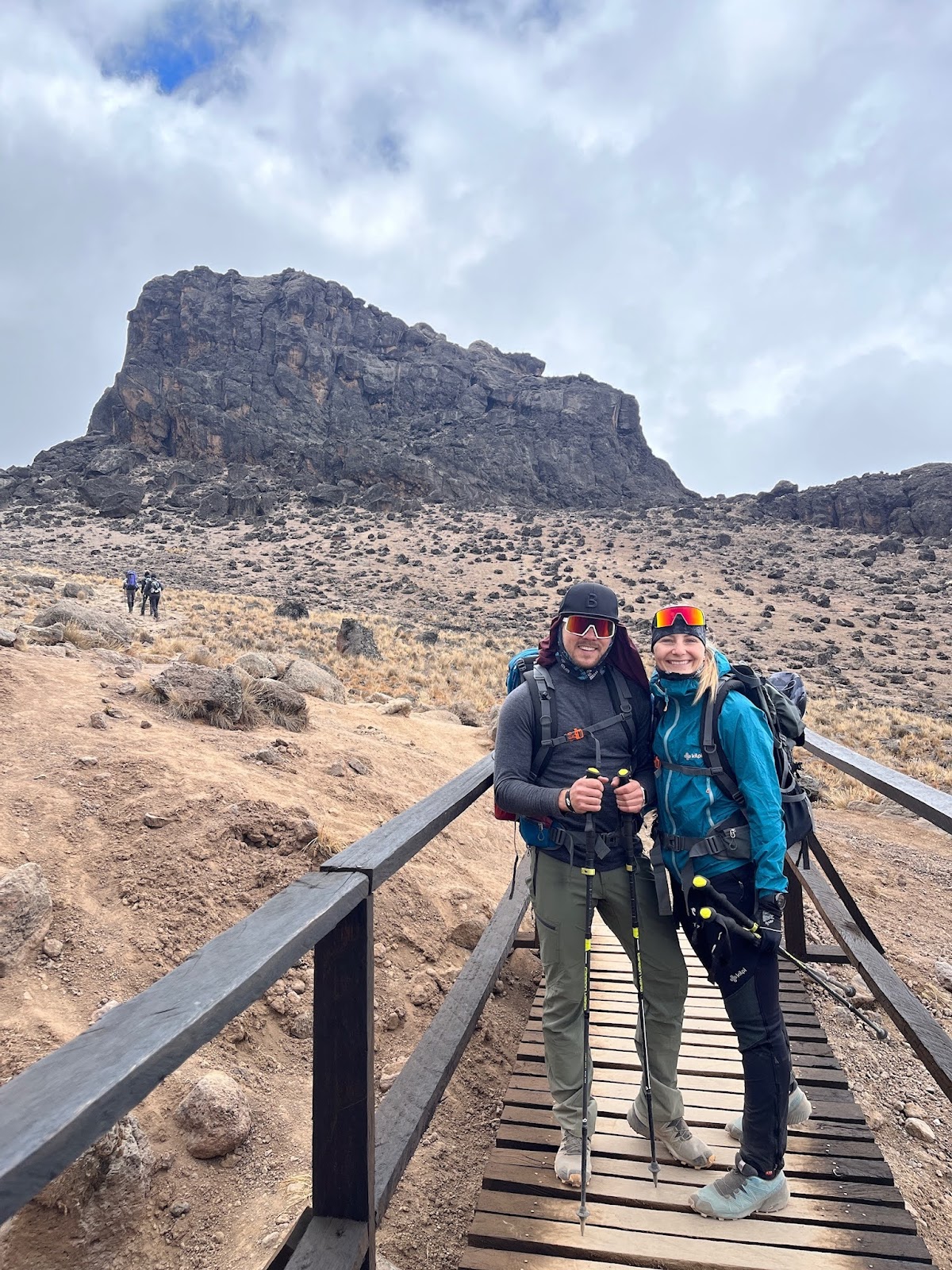
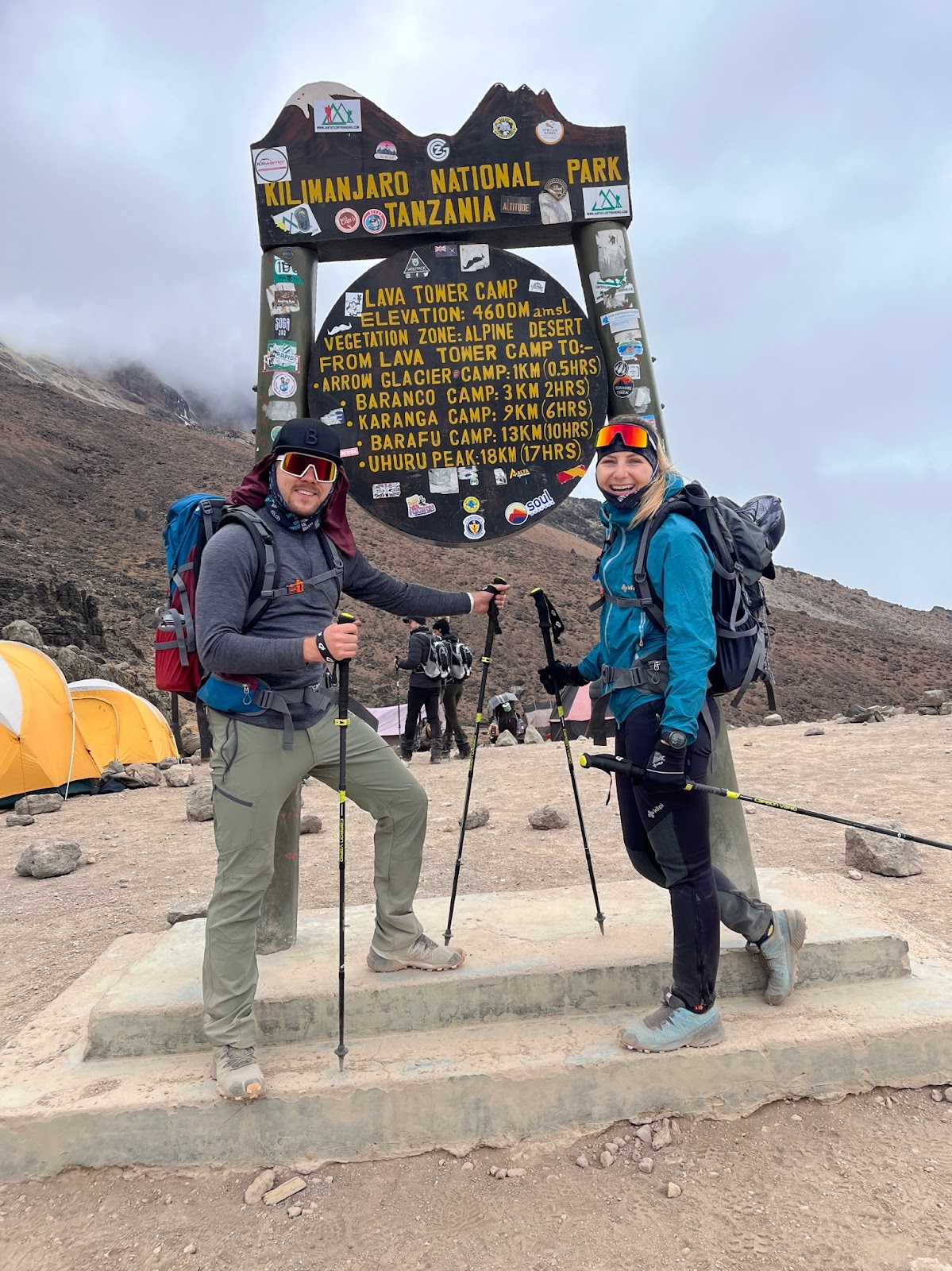
Our guide Mambo kept stopping us, saying we had to go slowly - Pole Pole (Swahili for slow) so we proceeded at a snail's pace, but in high spirits, slowly getting to the Lava Tower campsite where we would have our lunch break. Personally, the highest I have ever been was 4,000m above sea level, and that was in the Chilean Andes, where we went for a month-long ski camp, and where I'd never suffered from high altitude sickness, so I hoped that would be the case here at Kilimanjaro. It was already quite cold at the Lava Tower camp, mainly due to the cold wind, so we decided not to stay too long, eat a quick lunch and continue on to the next camp.
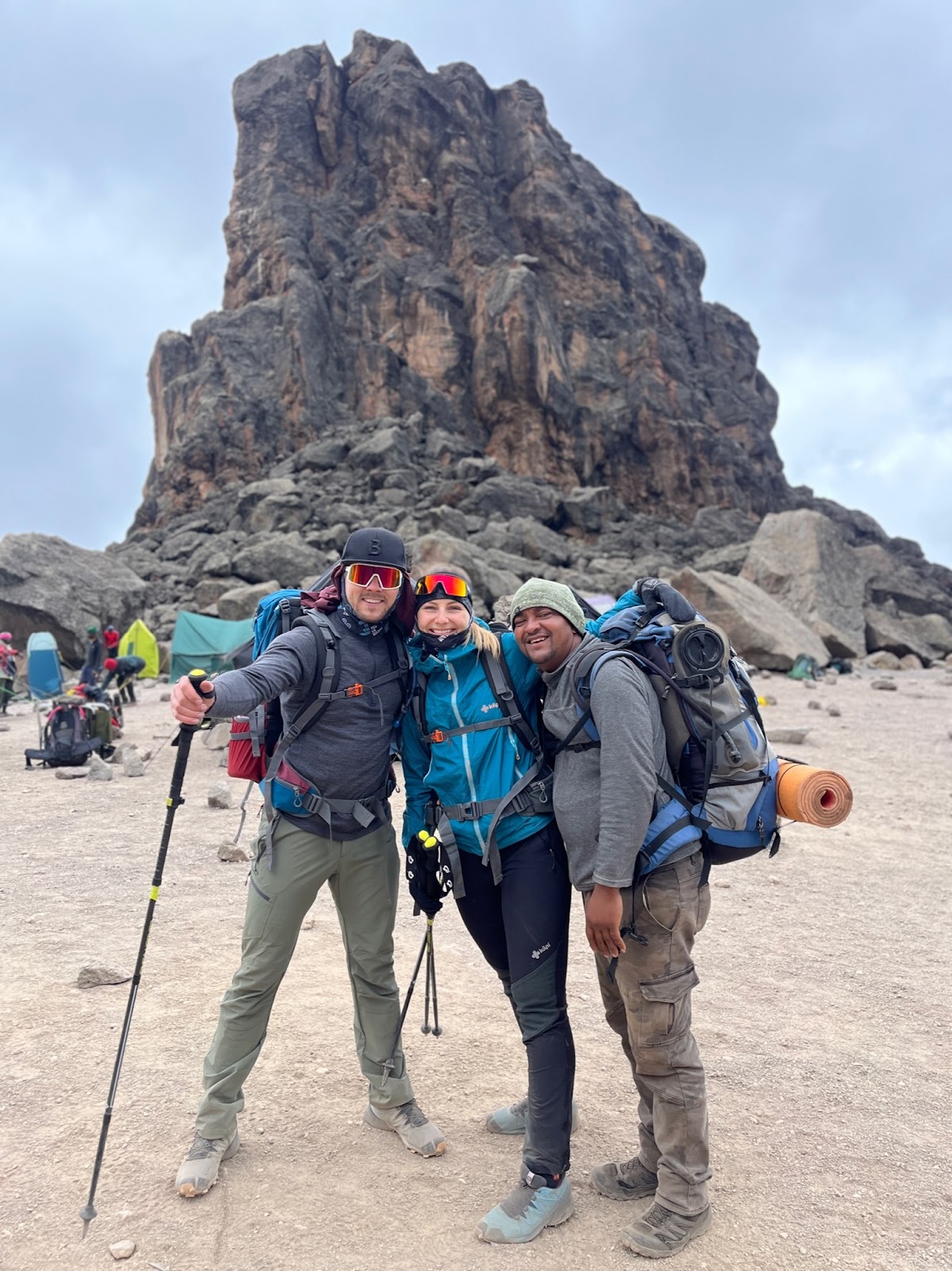
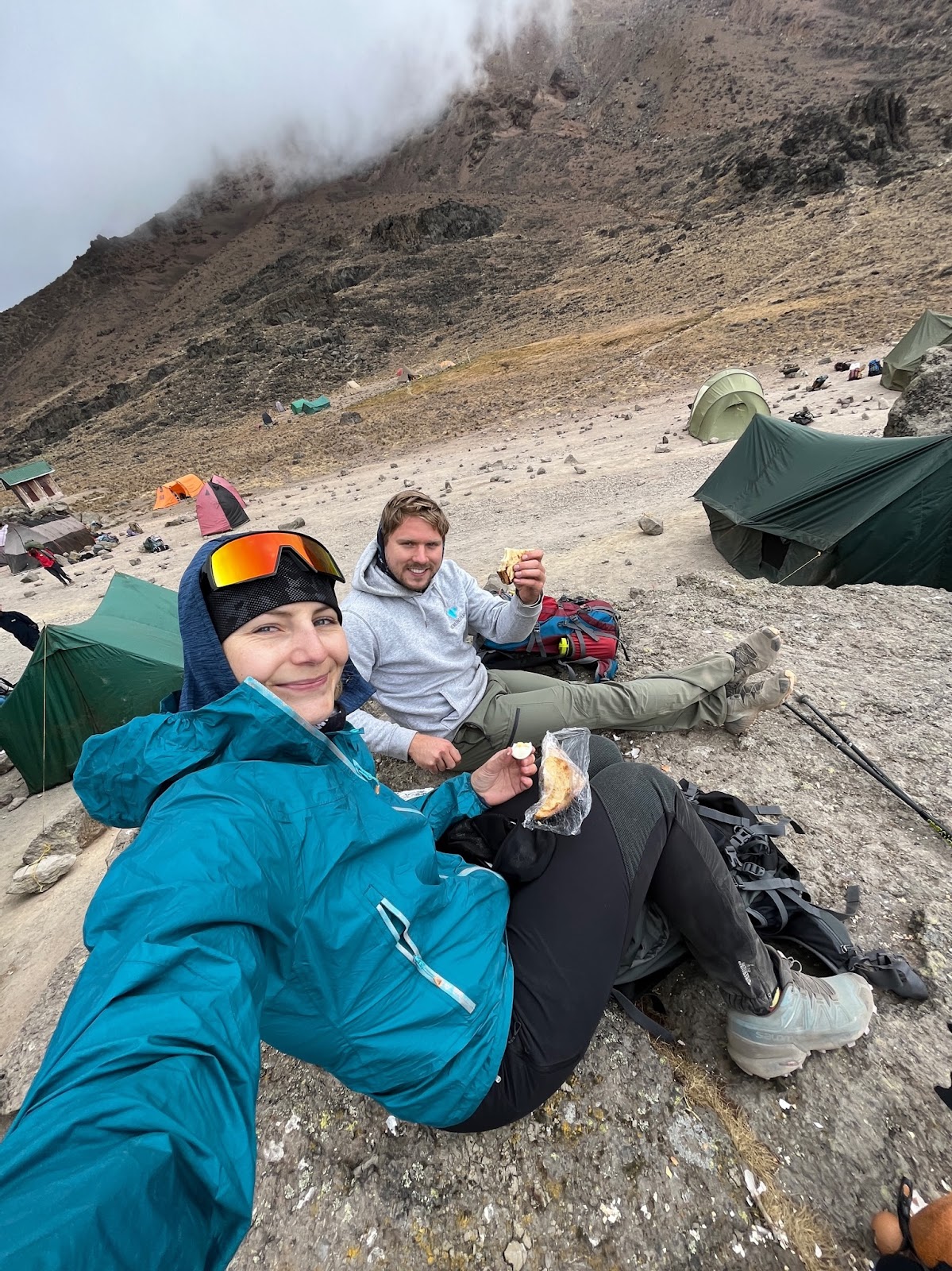
Now we have a three-hour descent to the Barranco campsite, where we will cross from the Alpine desert back to the Moorland. Slowly, strange trees, resembling giant pineapples, began to emerge from the dense and damp fog. This plant is called Giant Groundsel and grows only around Mount Kilimanjaro, is several metres tall and can be up to hundreds of years old.
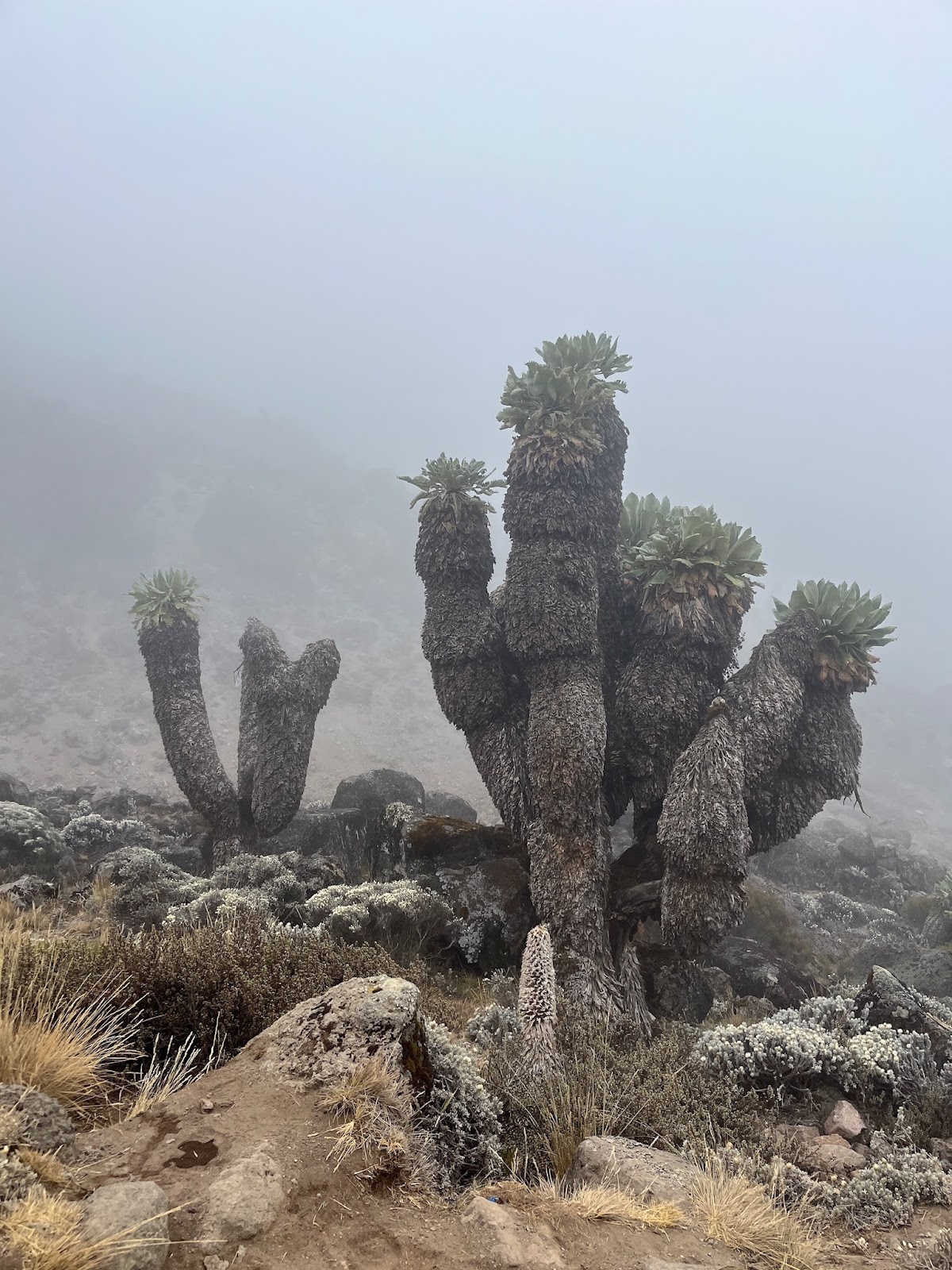
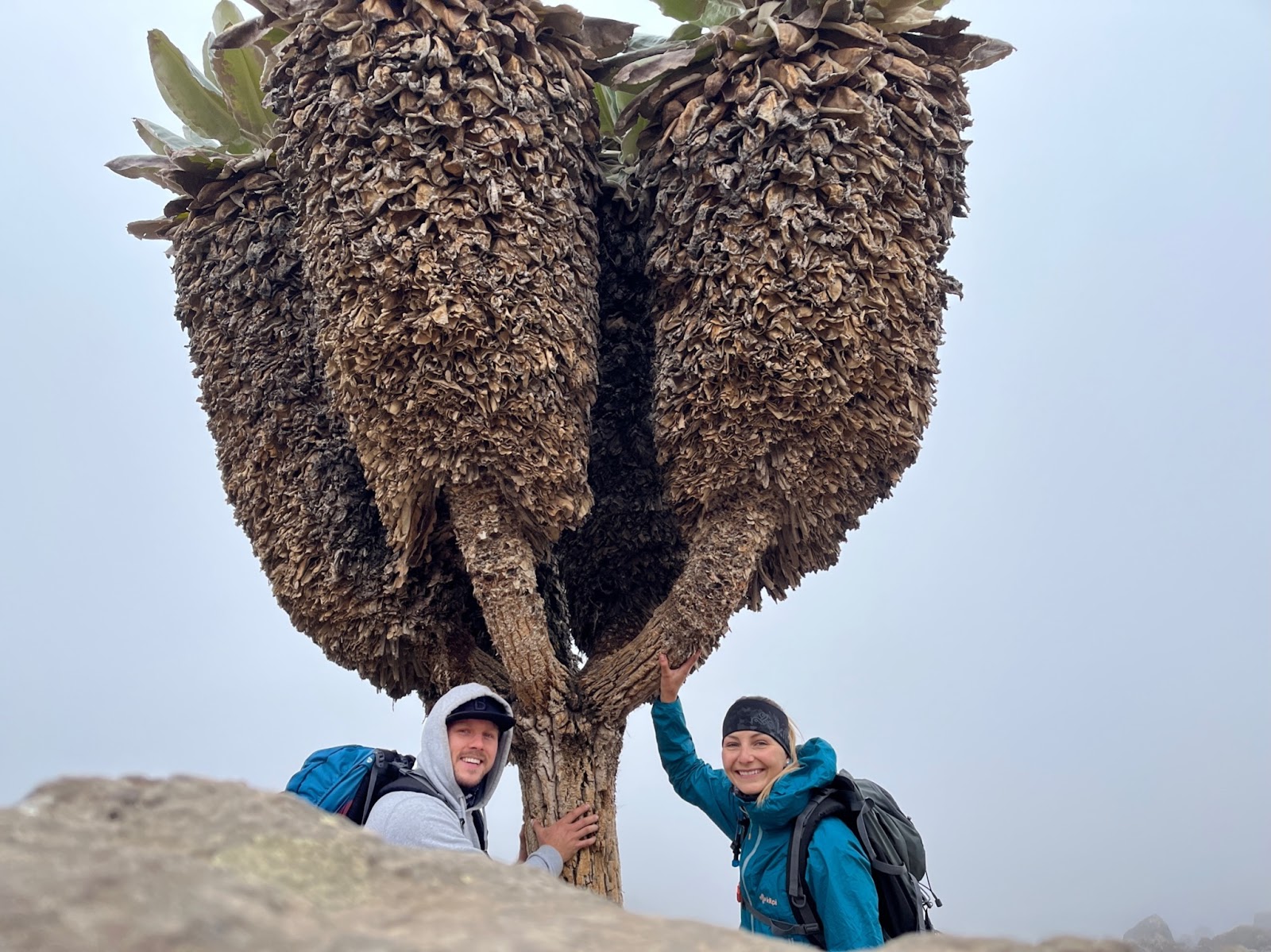
Ironically, the walk from the Lava Tower campsite to the Barranco campsite was probably the most challenging part for me yet, as the descent was relatively steep and, combined with the thick and humid fog, the rocky path was slippery and, even though I was using trekking poles the whole time, I slipped several times.
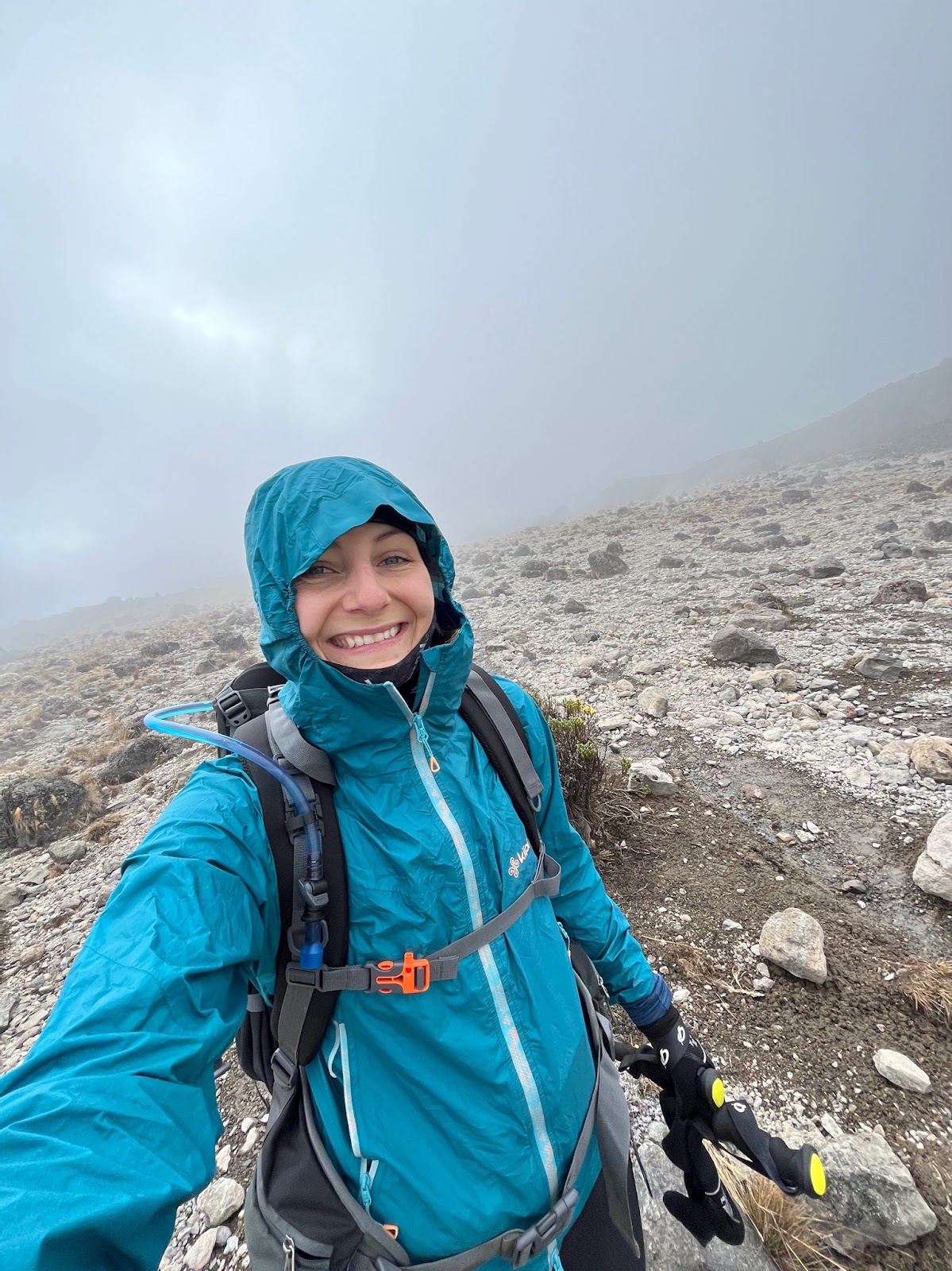
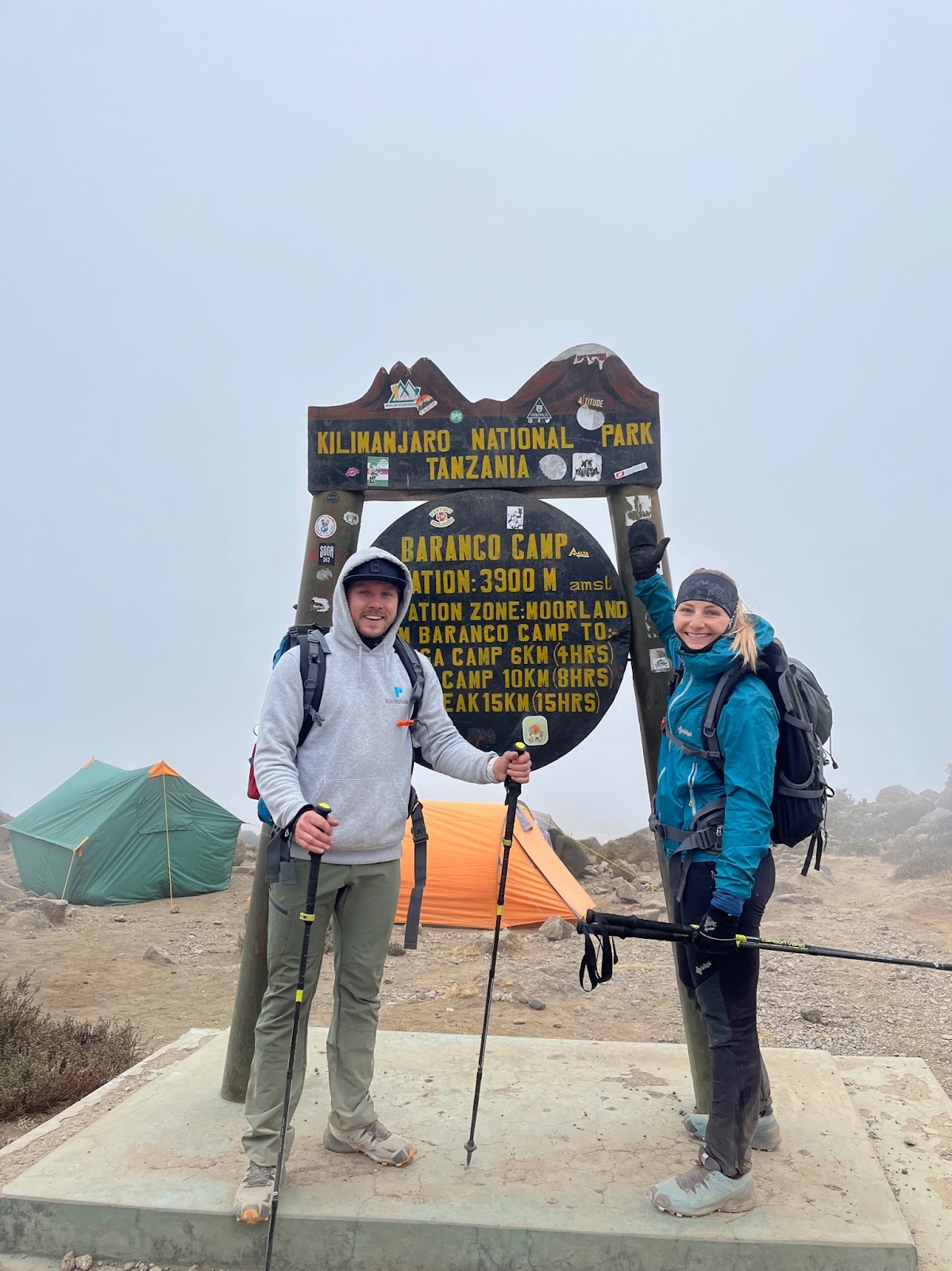
When we arrived at the Barranco campsite, which is one of the biggest campsites we have been to so far, it was immersed in thick fog so it took us quite a while to find our tents along with the rest of our team. The climb up Kilimanjaro is not only a test of physical and mental strength but also of physical discomfort, which we don't encounter that often in our everyday lives, where it is normal for us to shower every day and have clean running water. Here it is different, water is mainly used from natural sources (such as a stream), which is not always available in every campsite, and since we need water mainly for drinking, our water consumption is very restricted. Therefore, a small splash of warm water must suffice for your daily hygiene and "washing".
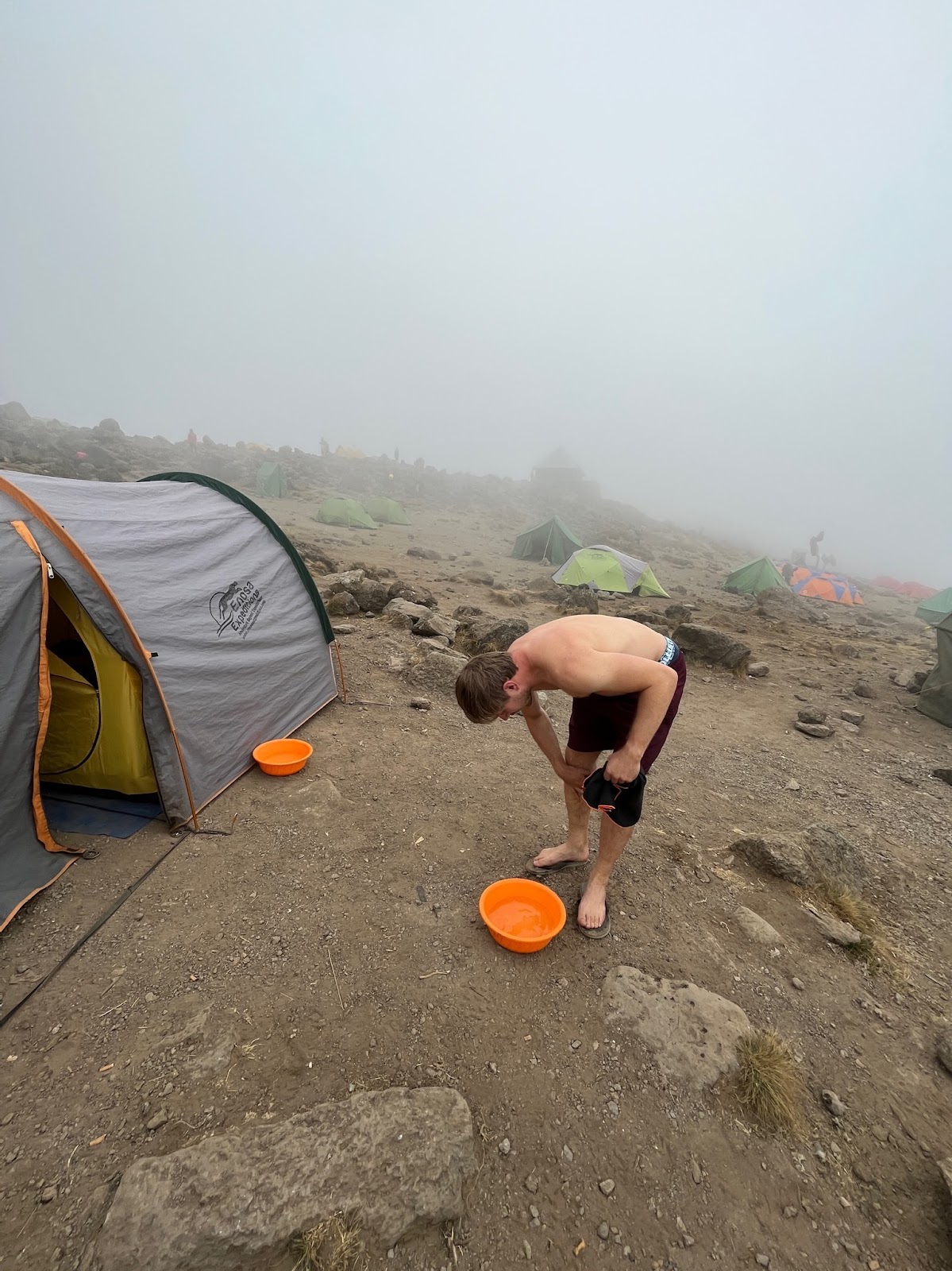
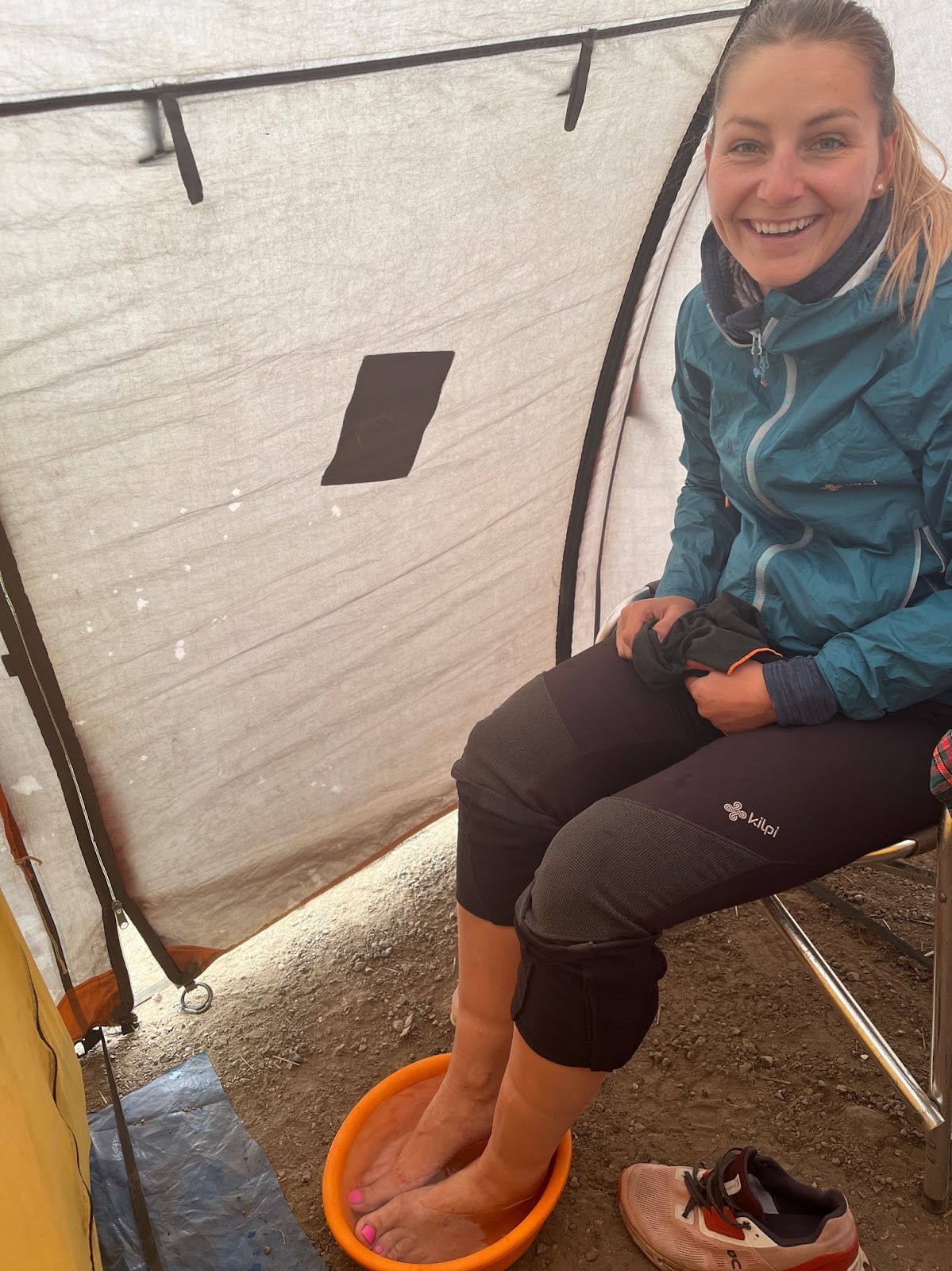
Thanks to a short lunch break at the Lava Tower and a quick descent, we got to the Barranco campsite almost two hours earlier than planned and were able to enjoy a longer rest, which we will really need in the next two days. A great hot dinner (pasta with vegetable sauce), hot tea and then back to the sleeping bag. Lala Salama = Good night!
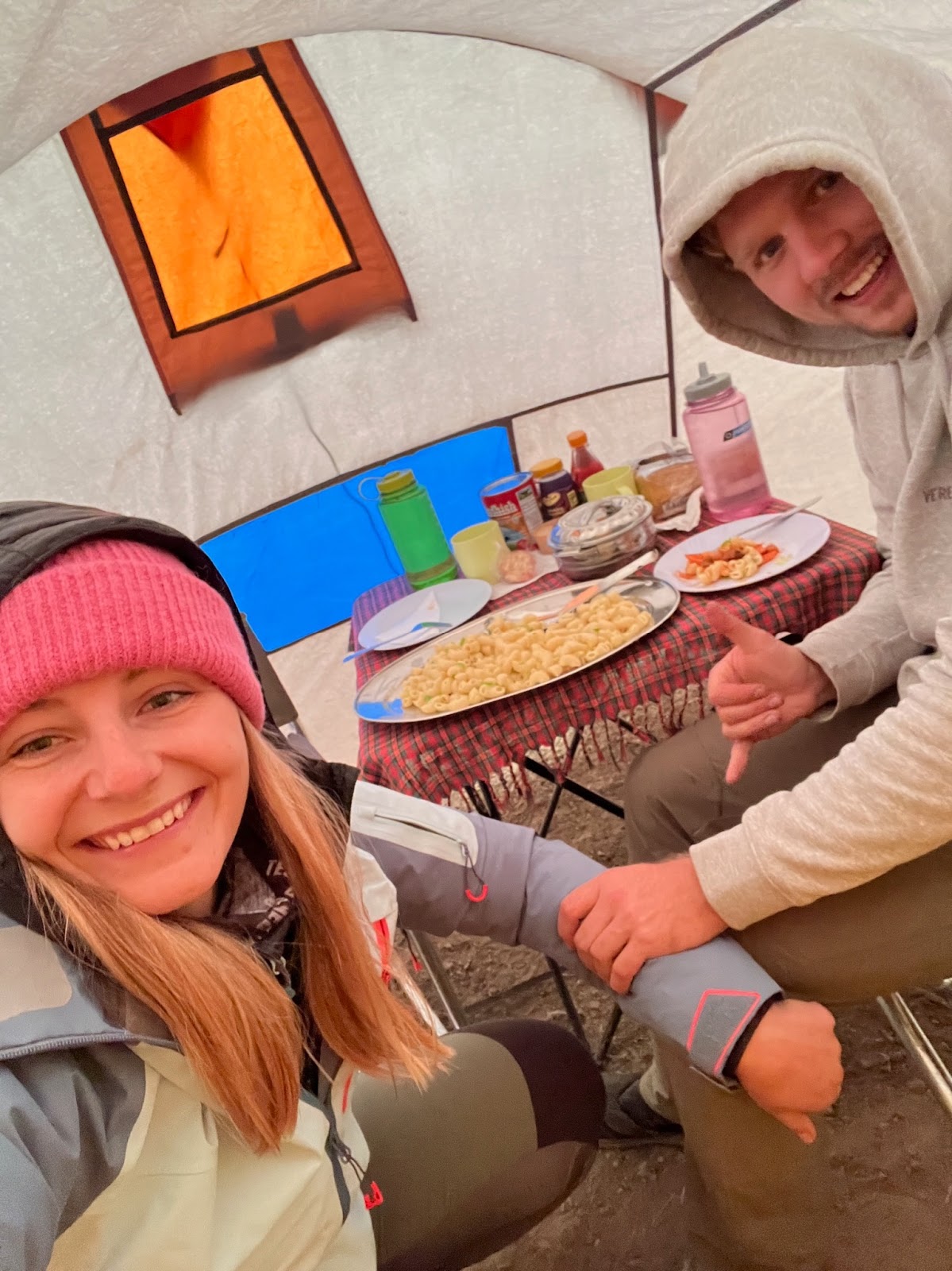
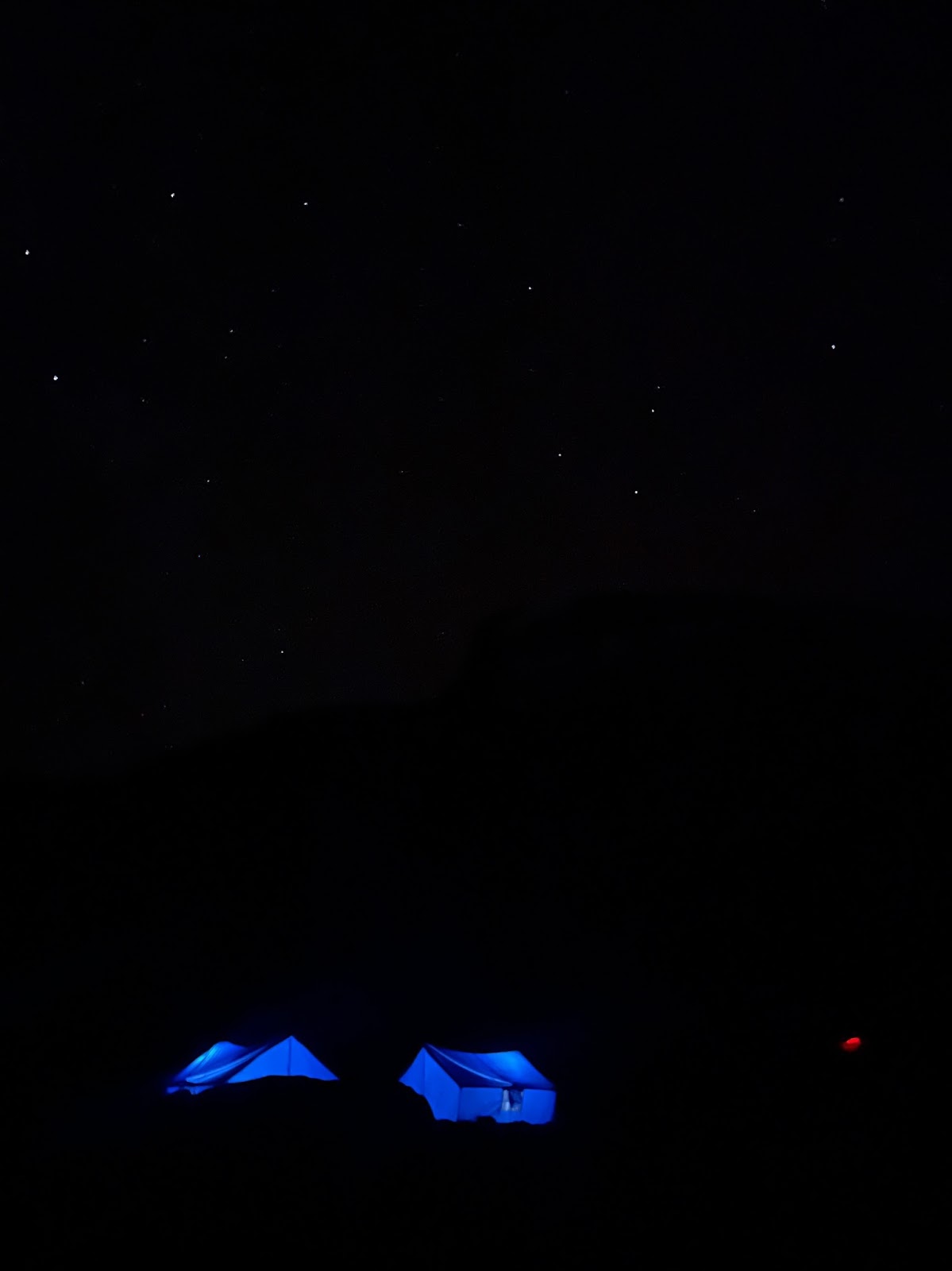
KILIMANJARO DAY 4.
BARRANCO CAMP -> KARANGA CAMP -> BARAFU CAMP (BASE CAMP)
The fourth morning starts again with our morning hygiene with a beautiful view of Kilimanjaro, a quick breakfast and packing. Today, the first part of the hike is very rocky and it will be a smaller via ferrata, so the guides told us to pack our trekking poles in our backpack, because we will need both hands free.
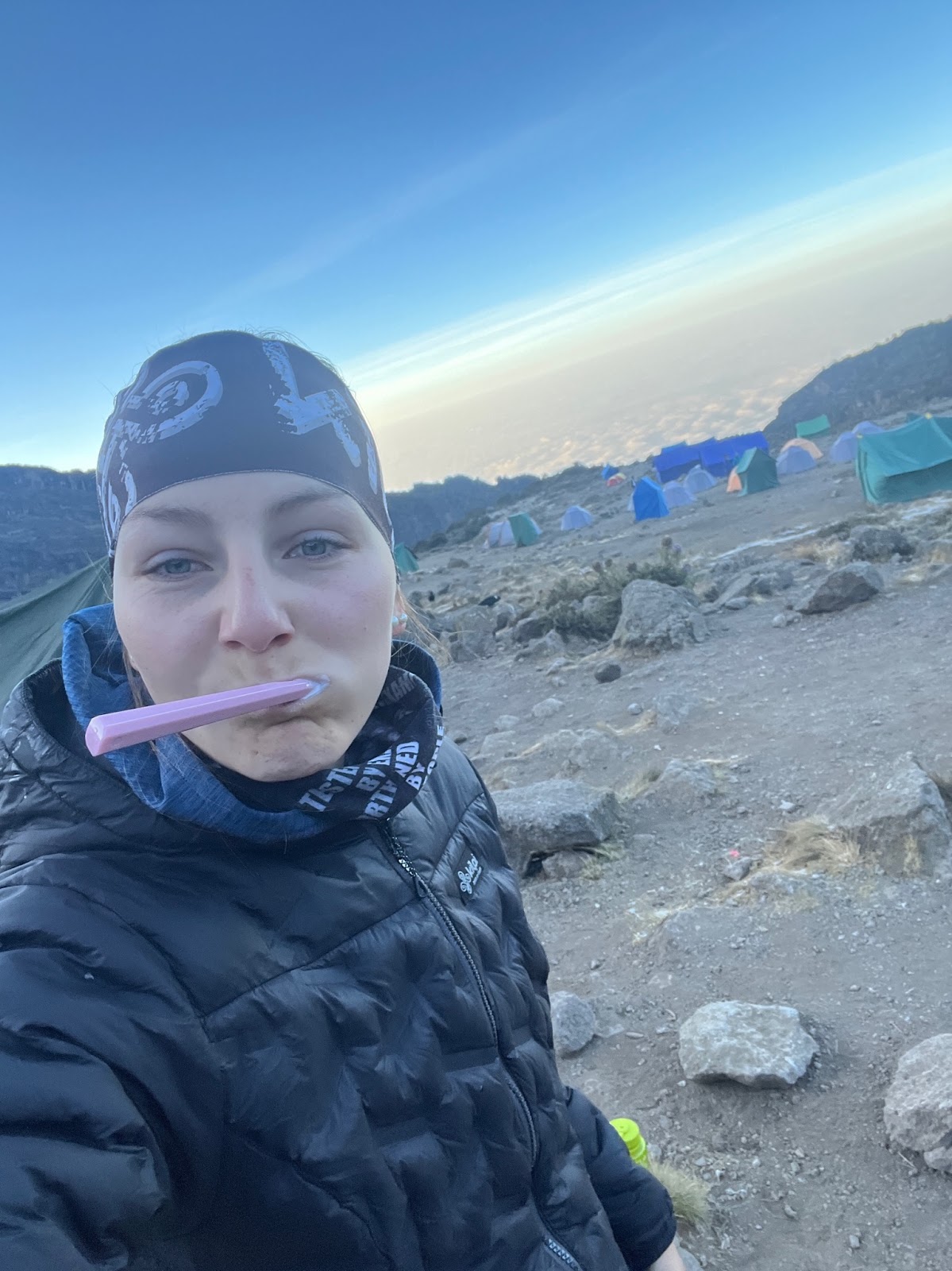
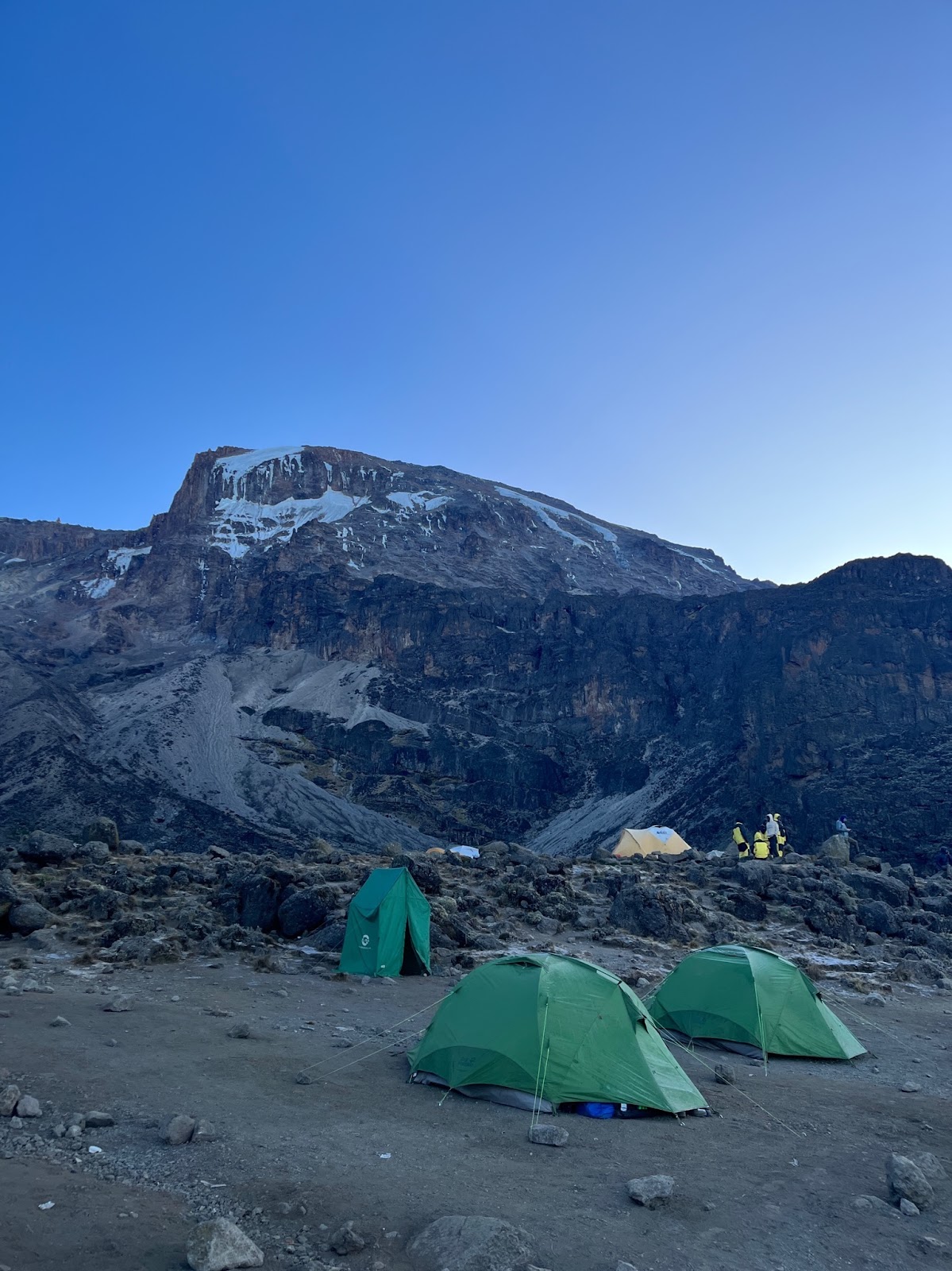
The weather favours us and out of the thick fog of yesterday a large campsite emerges with a spectacular view. But when I focused, I realised that we were really going to climb, in the rocks in the distance I already saw a couple of load carriers who had started earlier and had already completed part of the climb. In the rocky part we often had to dodge and let through the load carriers, who climbed to the next campsite with huge loads on their backs and heads, and I was just fascinated.
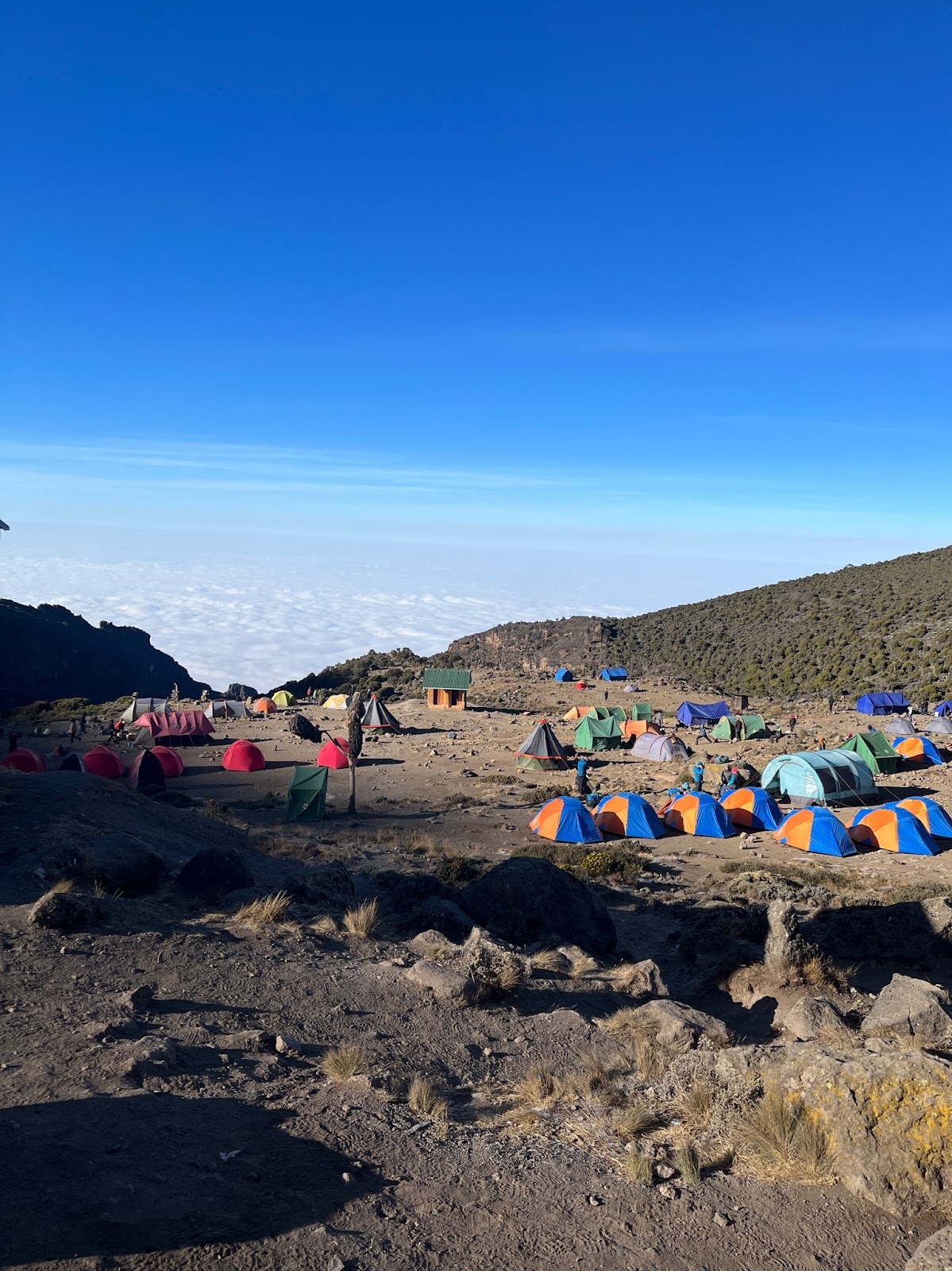
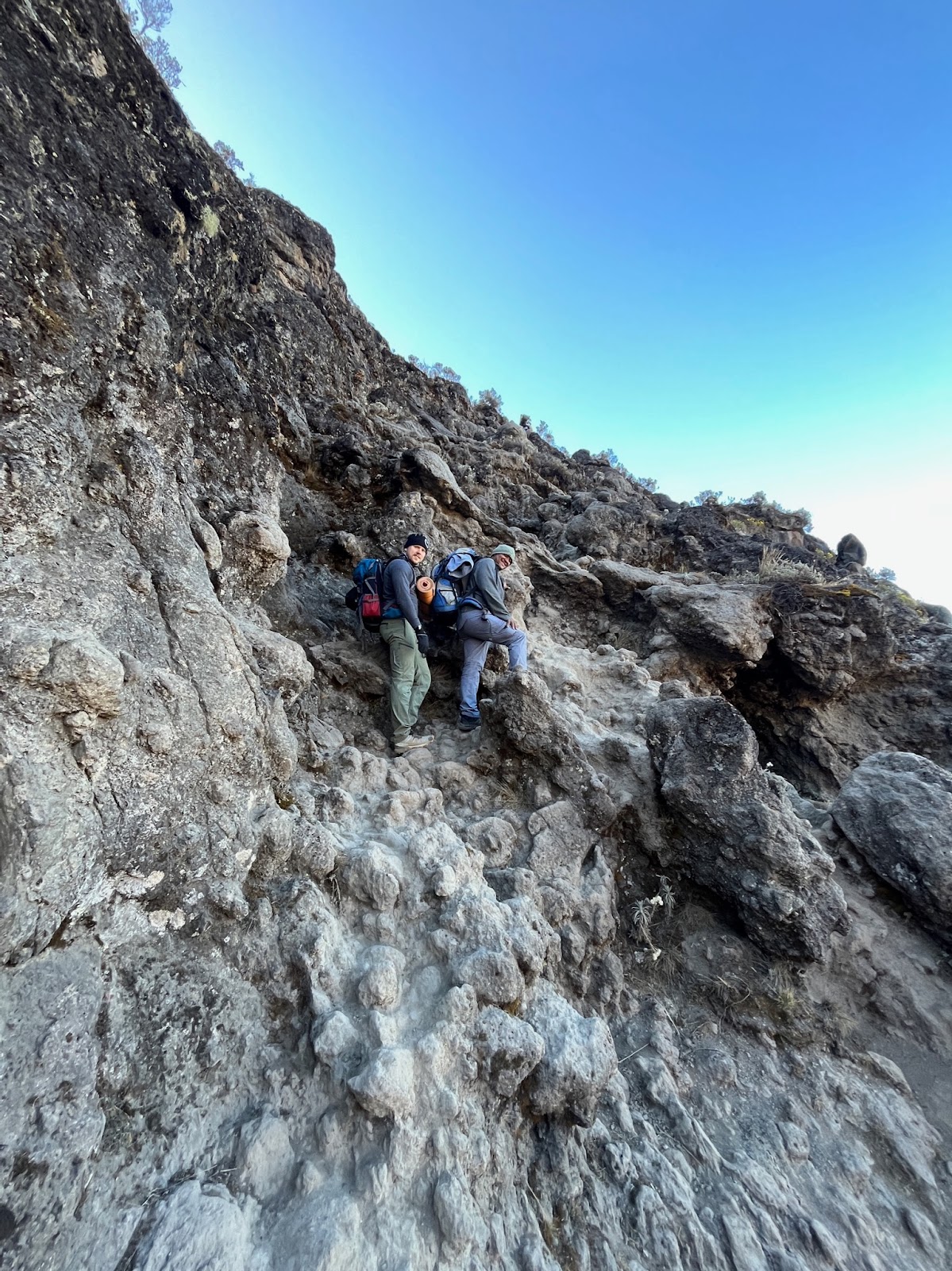
After an hour of climbing, we reached a rocky plateau with a beautiful view of the valley. Our plan for today is clear - first we have to get to the Karanga camp (a journey of about four hours) and then continue to the Barafu camp (another four hours), which is the base camp and therefore the last camp before the climb to the highest point of Mount Kilimanjaro - Uhuru peak.
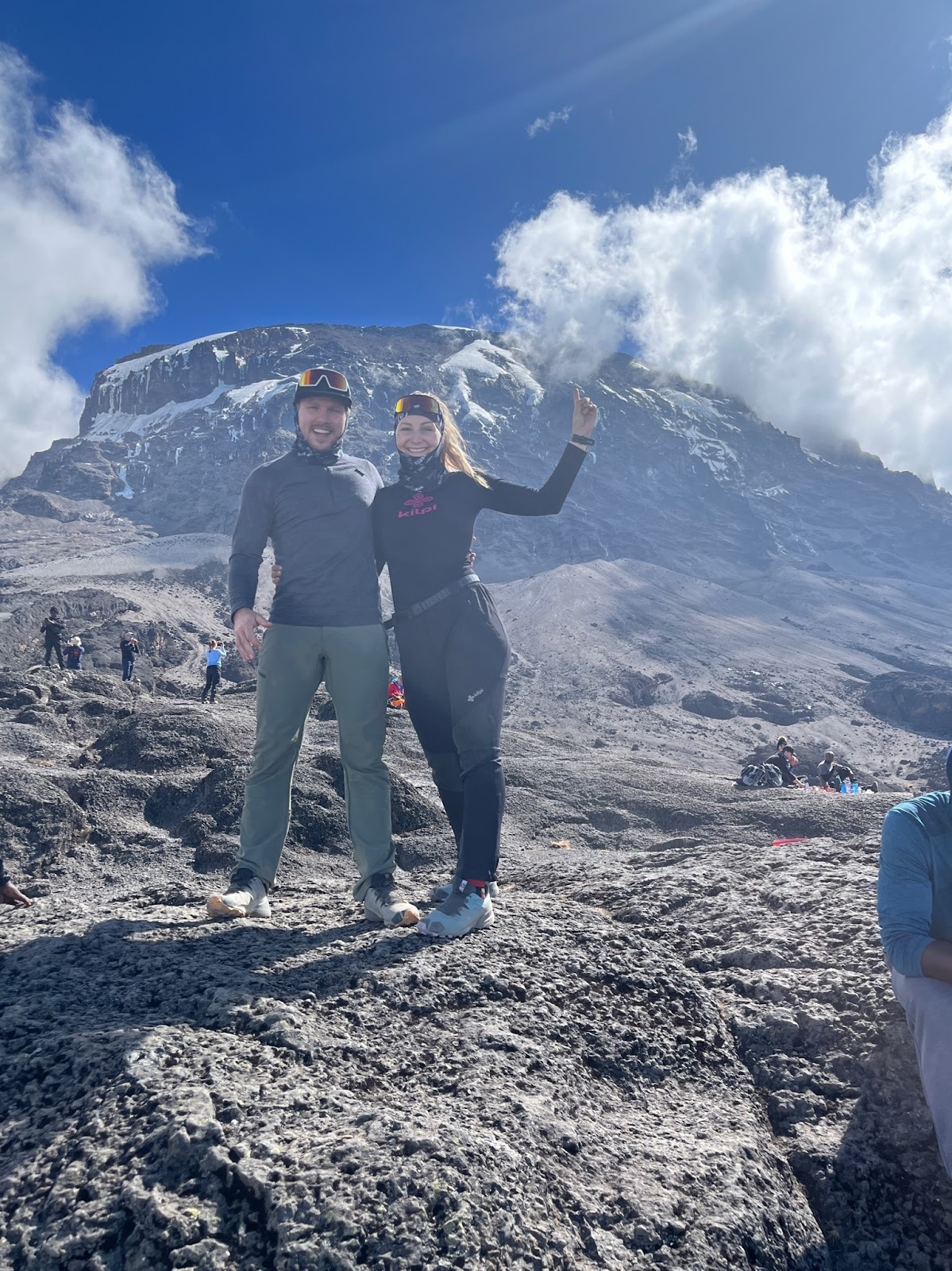
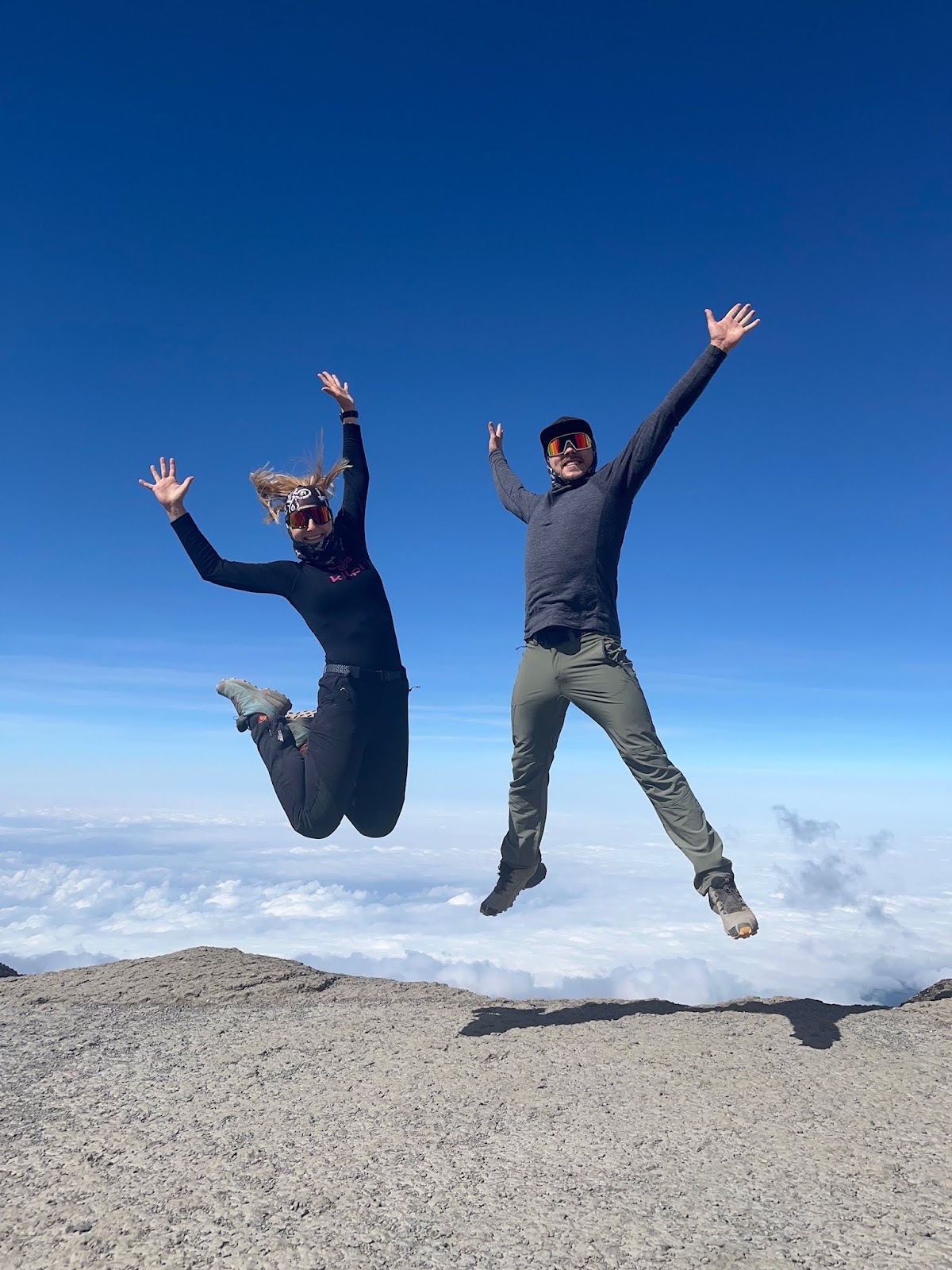
Today will be a challenging day for us, because compared to other groups, we will skip the overnight stay at Karanga Camp (3,995m) and we will climb to the summit at night. It is therefore important to distribute our energy wisely so that we feel good and can enjoy it all without any complications. The journey to the Karanga campsite is very busy and often you are walking behind people who are setting your pace and unfortunately you cannot overtake them as the path is narrow in some places and you have to wait until there is a better place to overtake. At times it seemed to me that we were walking in such a huge crowd and so slowly as if you were queuing at the supermarket.
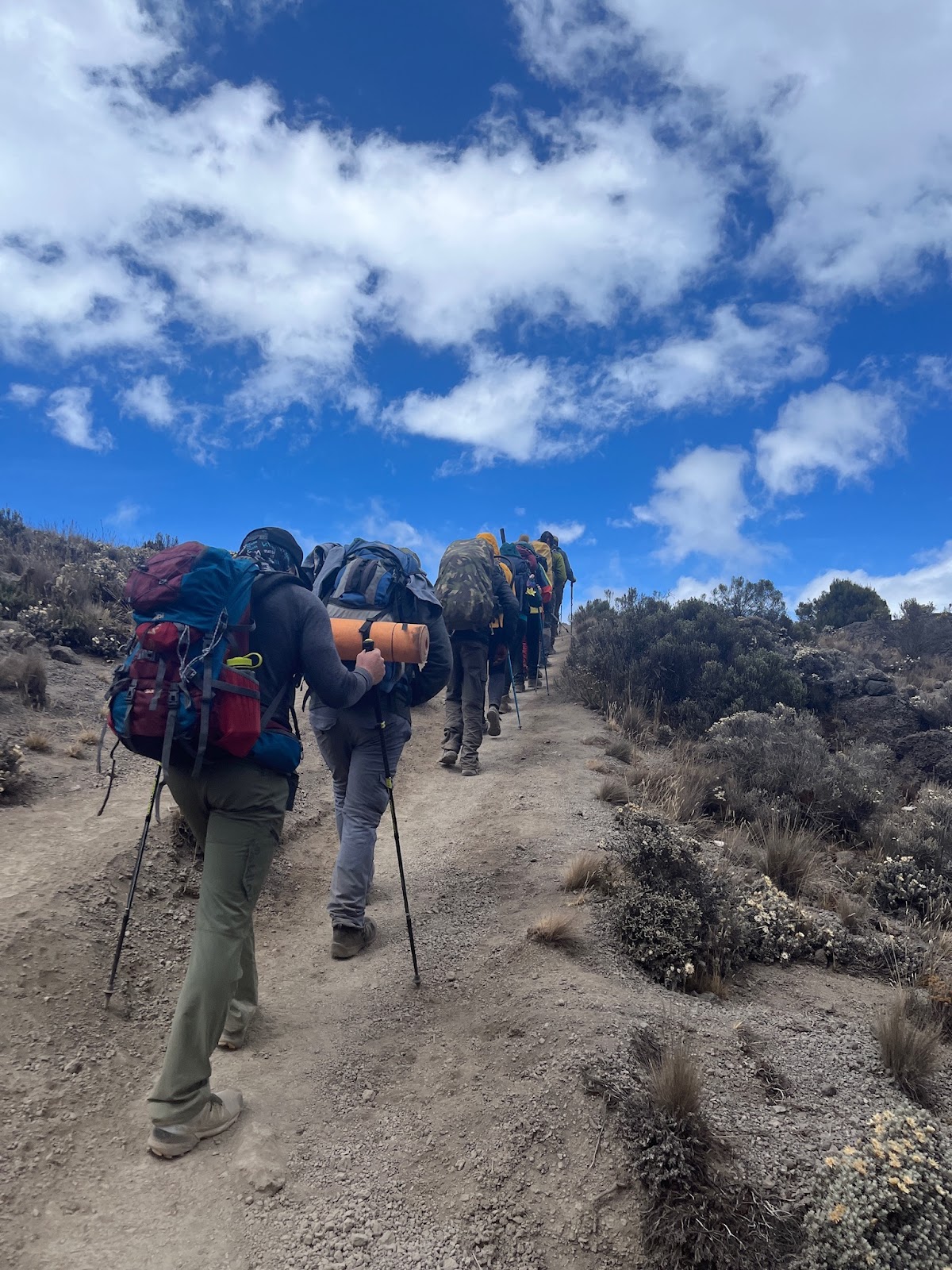
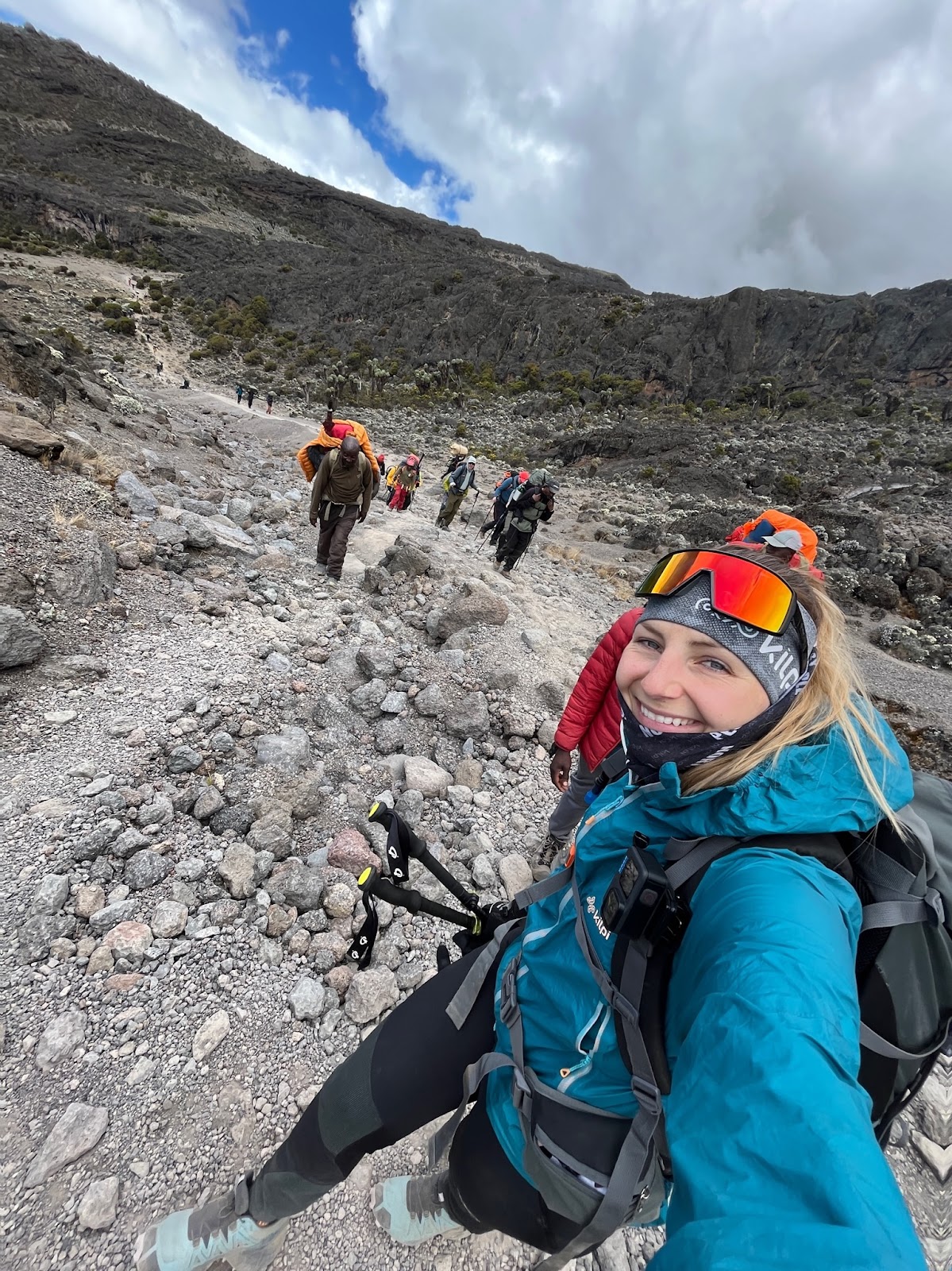
What is different here compared to other hikes that Lukas and I are used to, is the fact that you know that the next day will be more difficult than the previous one, but you don't really know what to expect and how you will react, so it is hard to strategically distribute your energy for the next day. However, experienced guides help you with this, because they give you tips and try to set the pace so that you are able to reach the top. Another problem is distance, a five kilometre hike doesn't seem difficult, but in combination with the high altitude, difficult terrain and short acclimatisation, even a five kilometre hike takes several hours. Here on Kilimanjaro the body experiences more demanding conditions for recovery and, in combination with poor sleep, you already feel fatigue even after such a short distance and you still don't know what to expect. Just before the Karanga camp there is a valley you have to descend into to climb up again. When we arrived at the Karanga campsite, where a lunch of home-made fries and vegetable quiche awaited us, the weather began to change and we saw thick clouds moving in from what had been a beautiful sunny day. Since we still had a four hour journey ahead of us up to 4,673m we knew we had to leave as soon as possible because the journey would be challenging. The other groups stayed in the Karanga camp and we were the only ones who continued that day to the base camp.
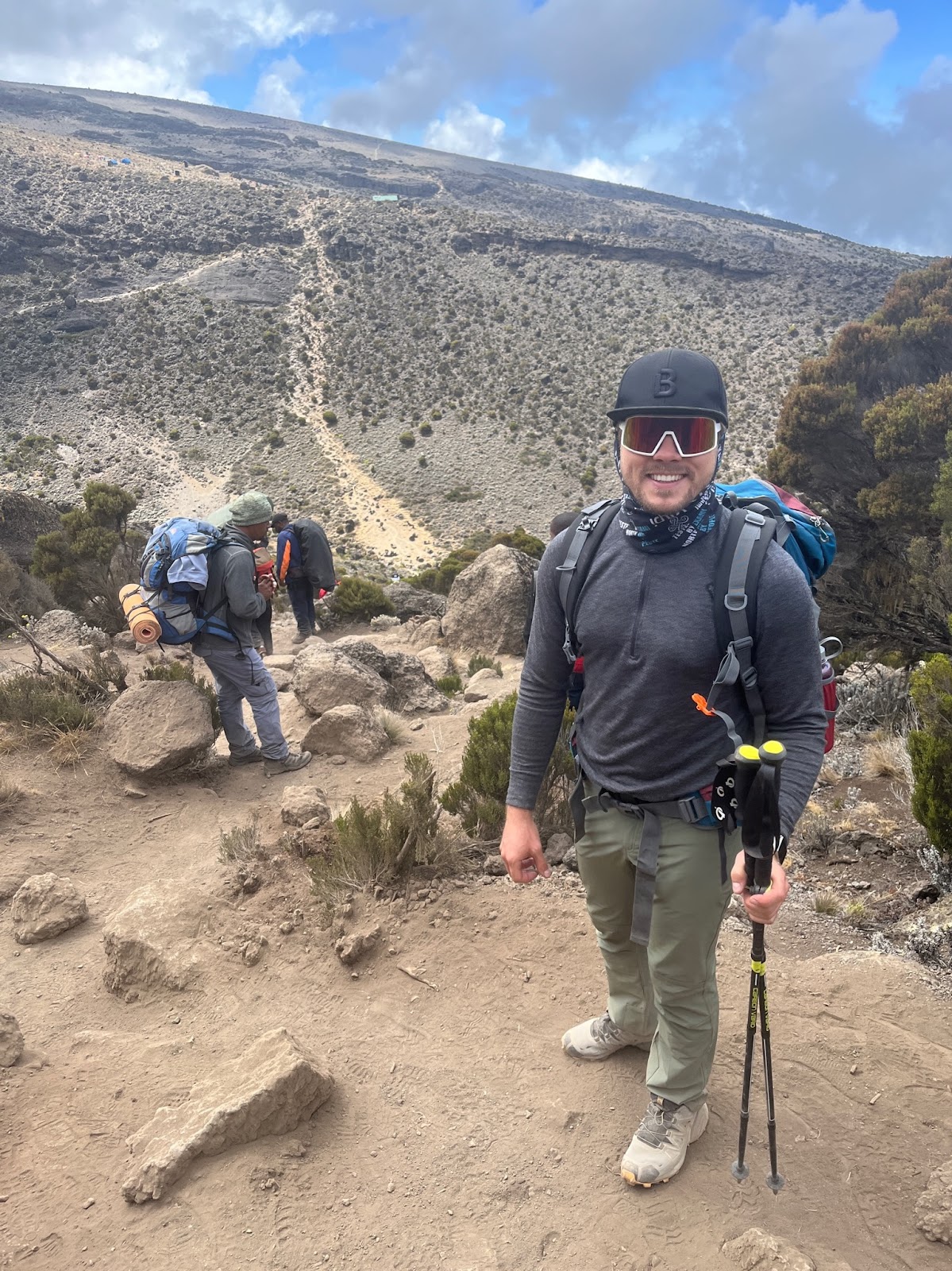
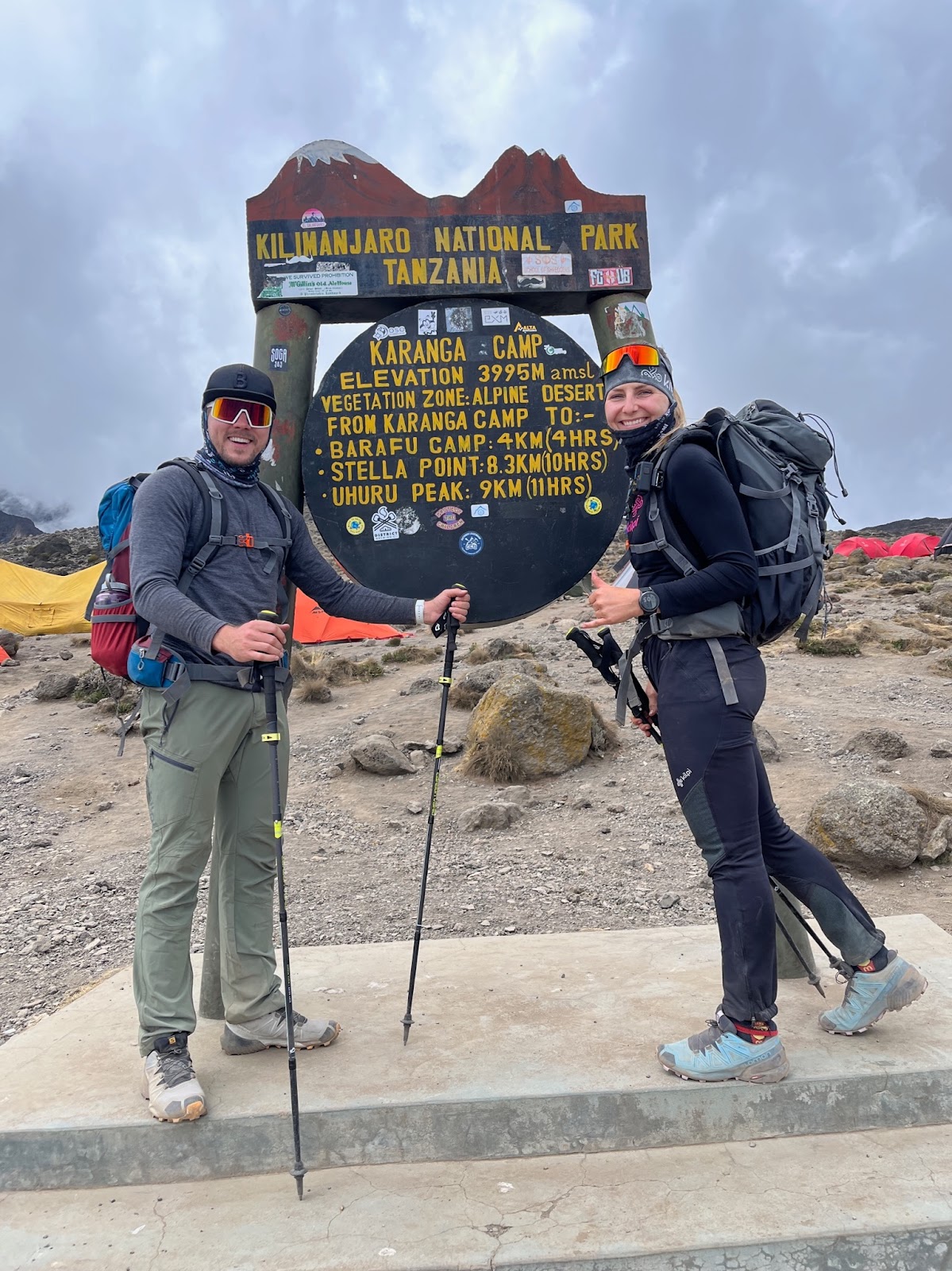
The journey from the Karanga camp to the Barafu base camp was a long one, we walked in thick fog the whole time, so we were not able to see much and we didn't know how much more was ahead of us. For a better mood, we put on music to make the journey a little faster. When we reached the altitude of 4,500m, Lukas slowly started to develop a headache and slight nausea, which is normal, but even so, the guides kept asking him how he was feeling, and if the altitude sickness became more pronounced, we would have to evaluate whether to cut short the climb and descend back to the Karanga camp and give his body a chance to acclimatise and try again some time later. Altitude sickness is common and can be managed without medication if the course is mild, but if you feel really bad, dizzy and have severe headaches, it is better not to continue climbing. Guides are trained to decide whether a person is able to continue or not.
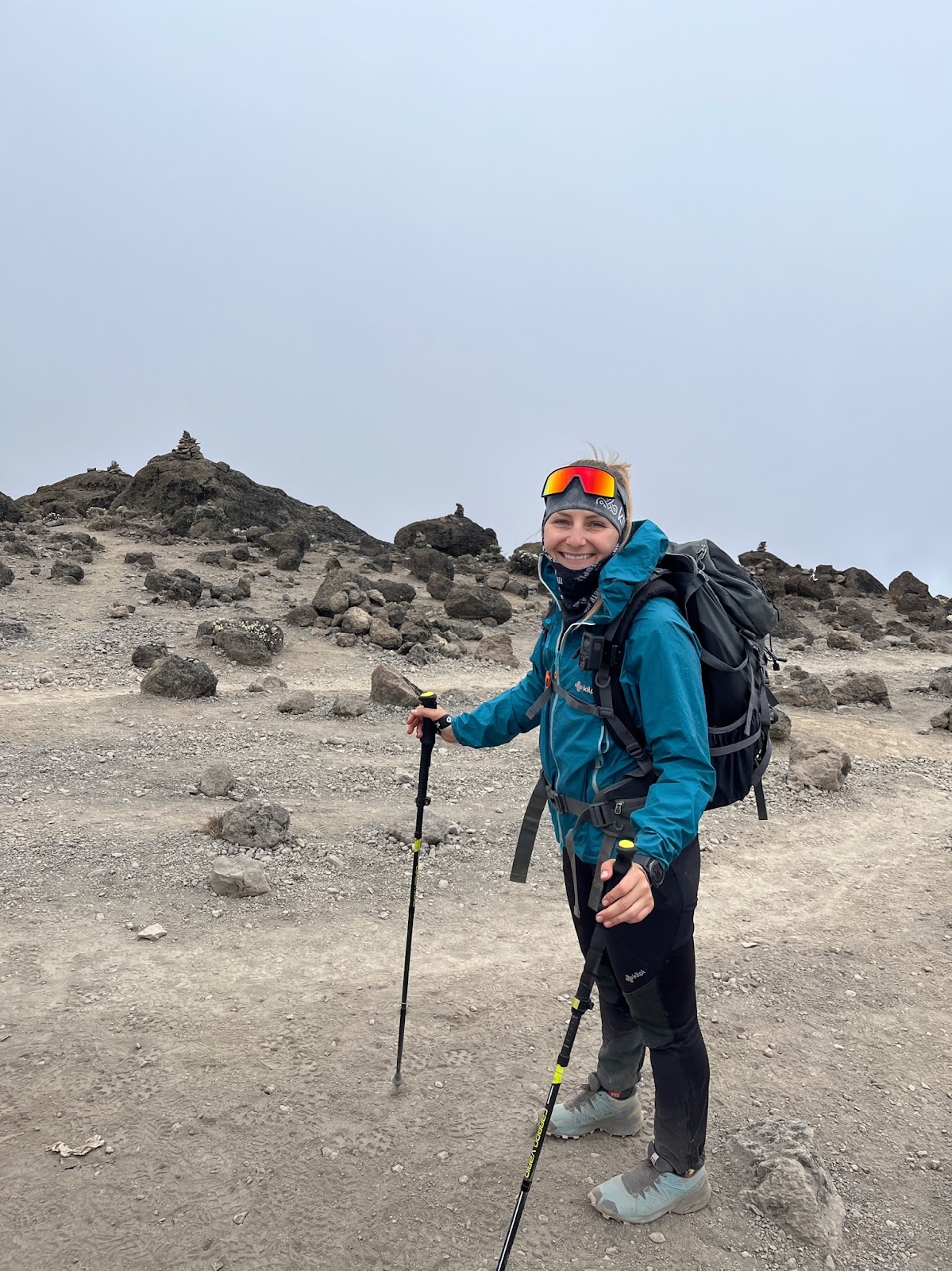
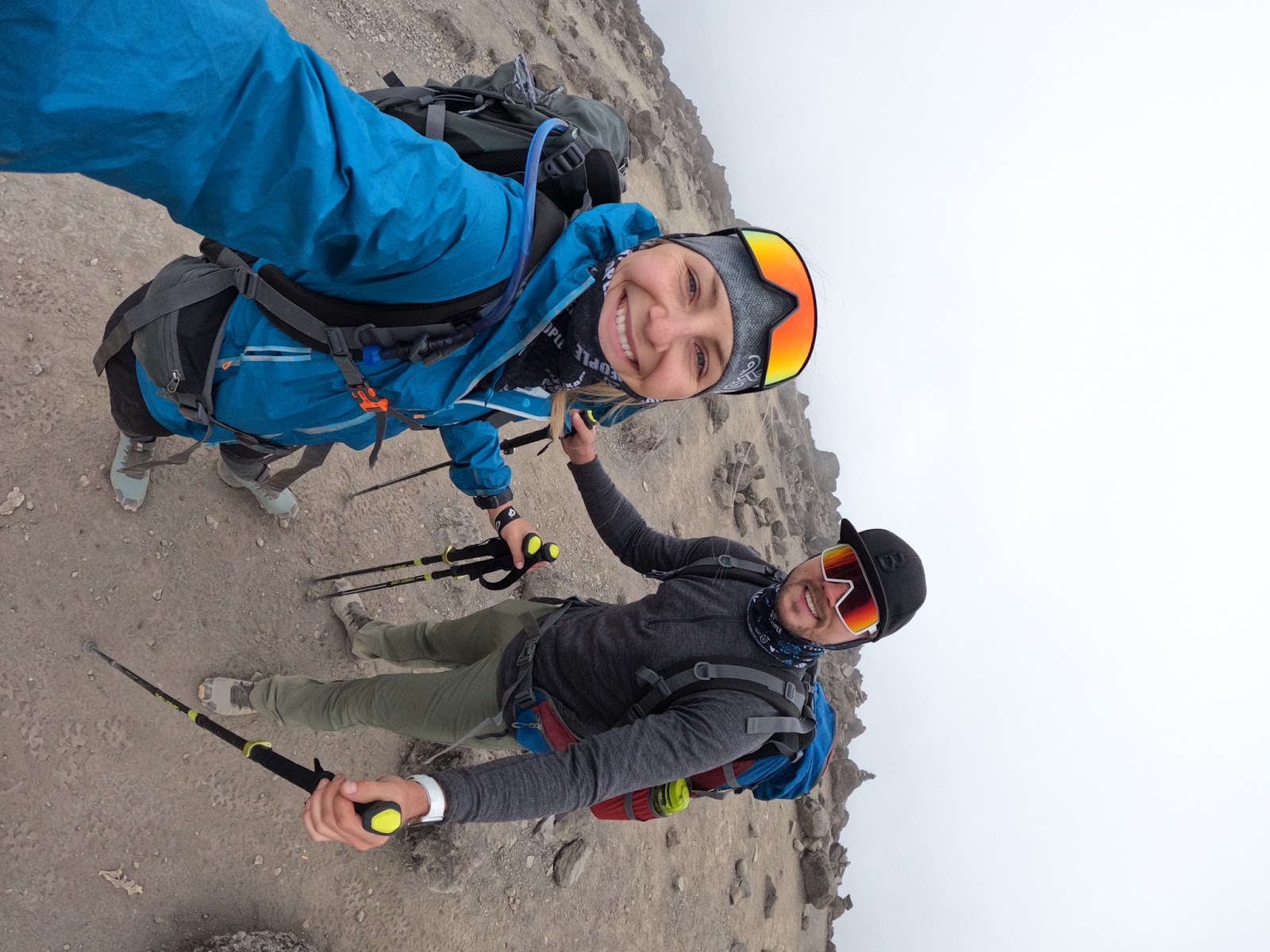
I still remain without any problems; I just feel slight fatigue and at the same time nervousness before the final ascent. When we arrived at the Barafu base camp (4,673m above sea level) we found out that our team was not yet there in full, as one of the load carriers was injured (fortunately nothing serious) and therefore it took them much longer to get there. Our load carrier Ringo, however, was carrying part of our tent and we had to wait for him to arrive. We sat outside on the stones and waited for Ringo to arrive so that we could finish our tent and finally crawl into our sleeping bags for a little rest. Combined with fatigue, cold and stress before the climb, every minute felt like an eternity and we knew that in a couple of hours we were going to the summit and we didn't have much time to rest.
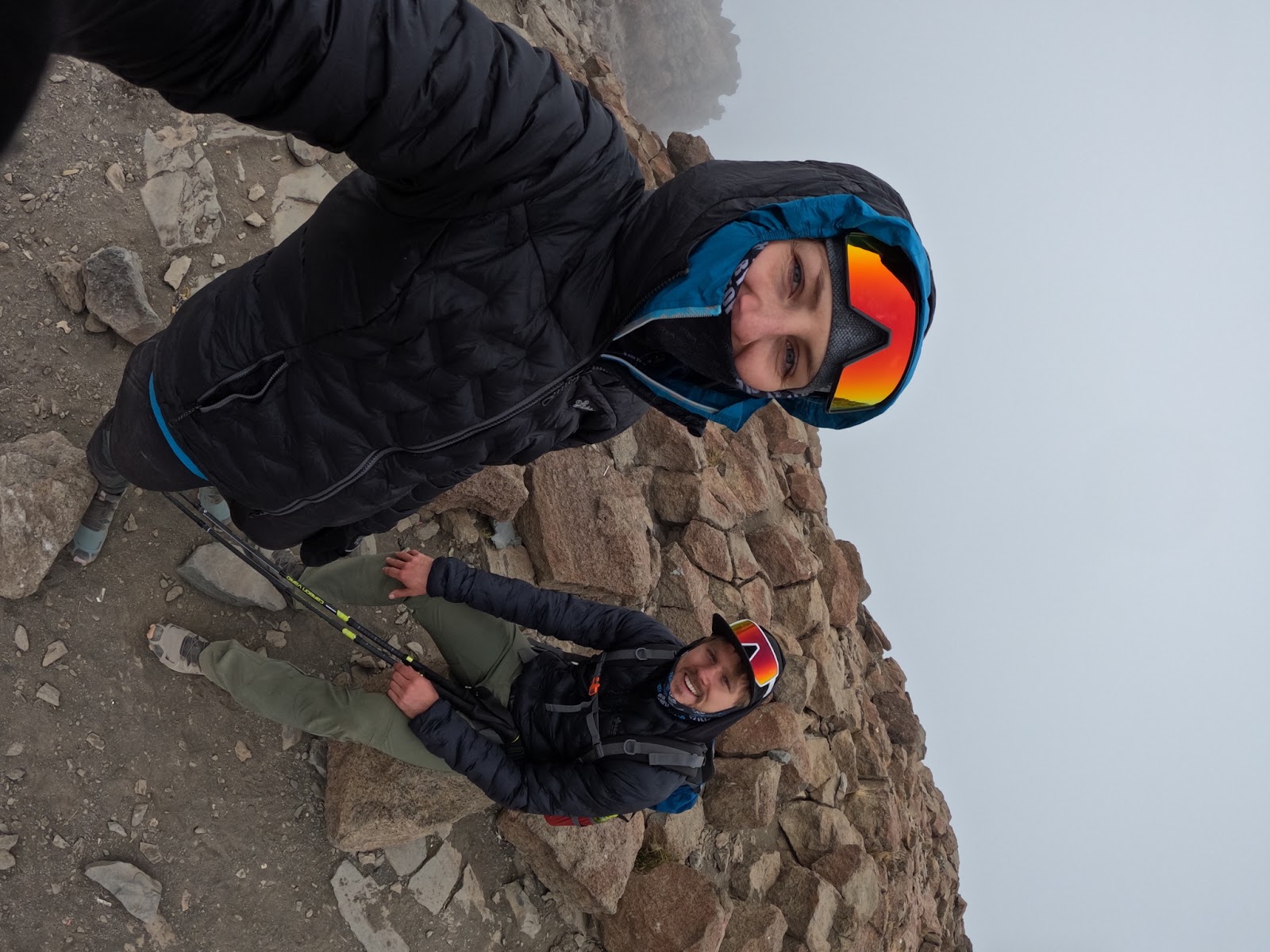
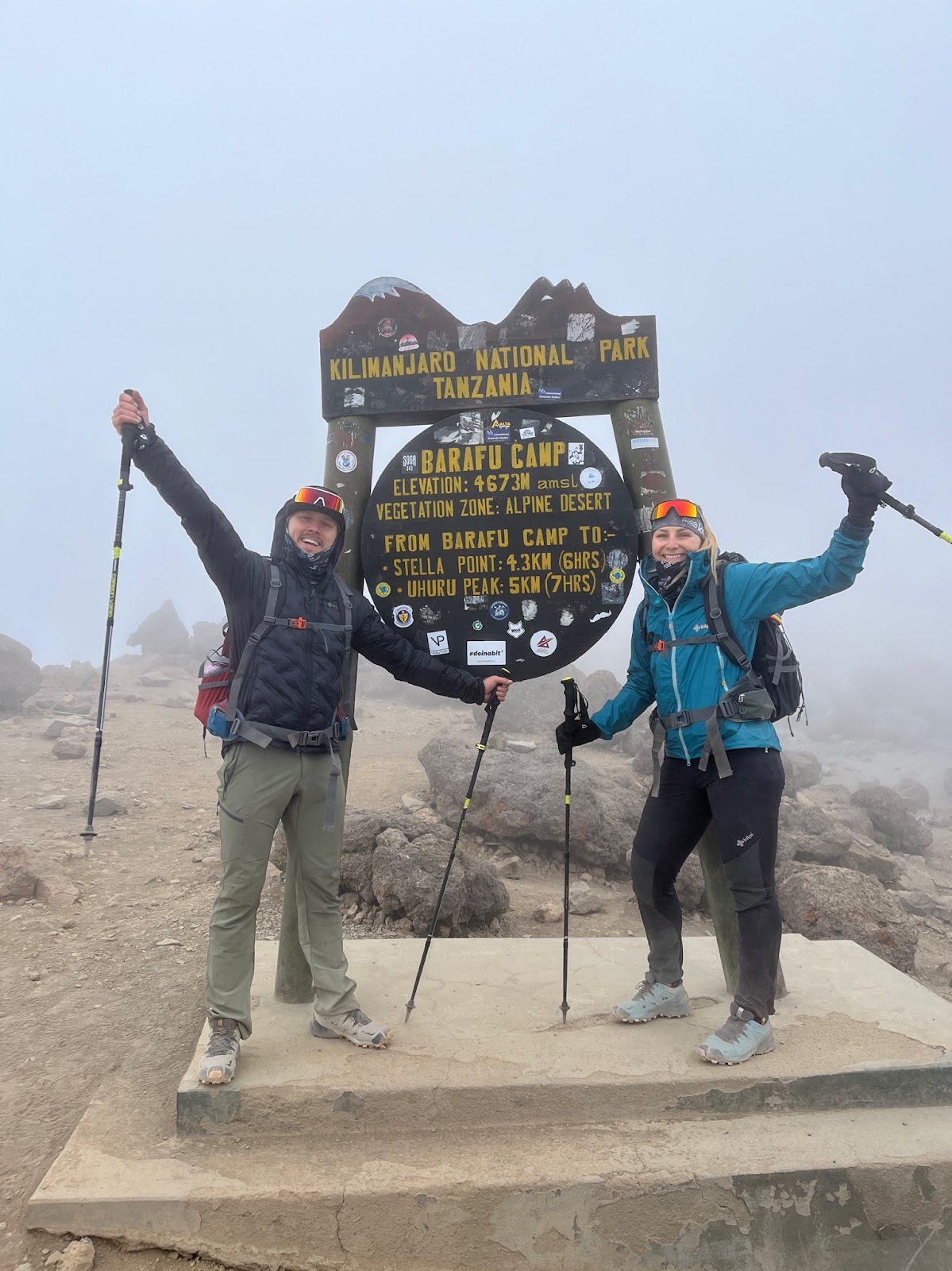
Hooray the tent is up, now we'll have dinner and try to get some sleep, because we have to start getting dressed at 23:00, have a small snack and some tea, and at midnight we'll head to the summit. The whole group is not going to the summit with us anymore, only the guides James and Mambo, and the rest of the team will be waiting in the base camp when we return from the summit. The guides told us to expect it to be very cold at night (around -10°C or lower) and to wear as many layers of clothing as possible. We are both used to much colder temperatures, so we were not afraid of the cold and it seemed excessive to wear three layers of pants or two pairs of gloves.
Kilimanjaro Day 5.
BARAFU CAMP (BASE CAMP) -> UHURU PEAK -> BARAFU CAMP (BASE CAMP) -> MWEKA CAMP
Finally it's midnight and we start heading to the summit, it's dark all around, only the lights of the other groups above us, who started at 23:00. At the very front is our guide James, then Lukas, me and behind me our other guide Mambo. James sets the pace and rhythm of the walk and we follow him. The night hike to the summit usually takes around six to eight hours and the guides plan it so that people get to the summit shortly after sunrise. I am used to the cold, but I must say that here after a long time, I had trouble with my fingertips. The main issue is that the pace of walking is extremely slow, plus there is a strong cold wind blowing and you don't have a chance to stay warm, and since it is dark and it is already the fifth day of the hike, the fatigue is quite evident. After two hours of walking we start to have a slump and we basically doze off as we go, I've never experienced anything like it. I was unable to keep my eyes open and my head was often falling onto Lukas's backpack, which displaced my headtorch and I couldn't see the trail, so it woke me up and I was only conscious for a few minutes before I started fighting the fatigue all over again. We didn't know how far it was yet or how much longer and it felt like an eternity. 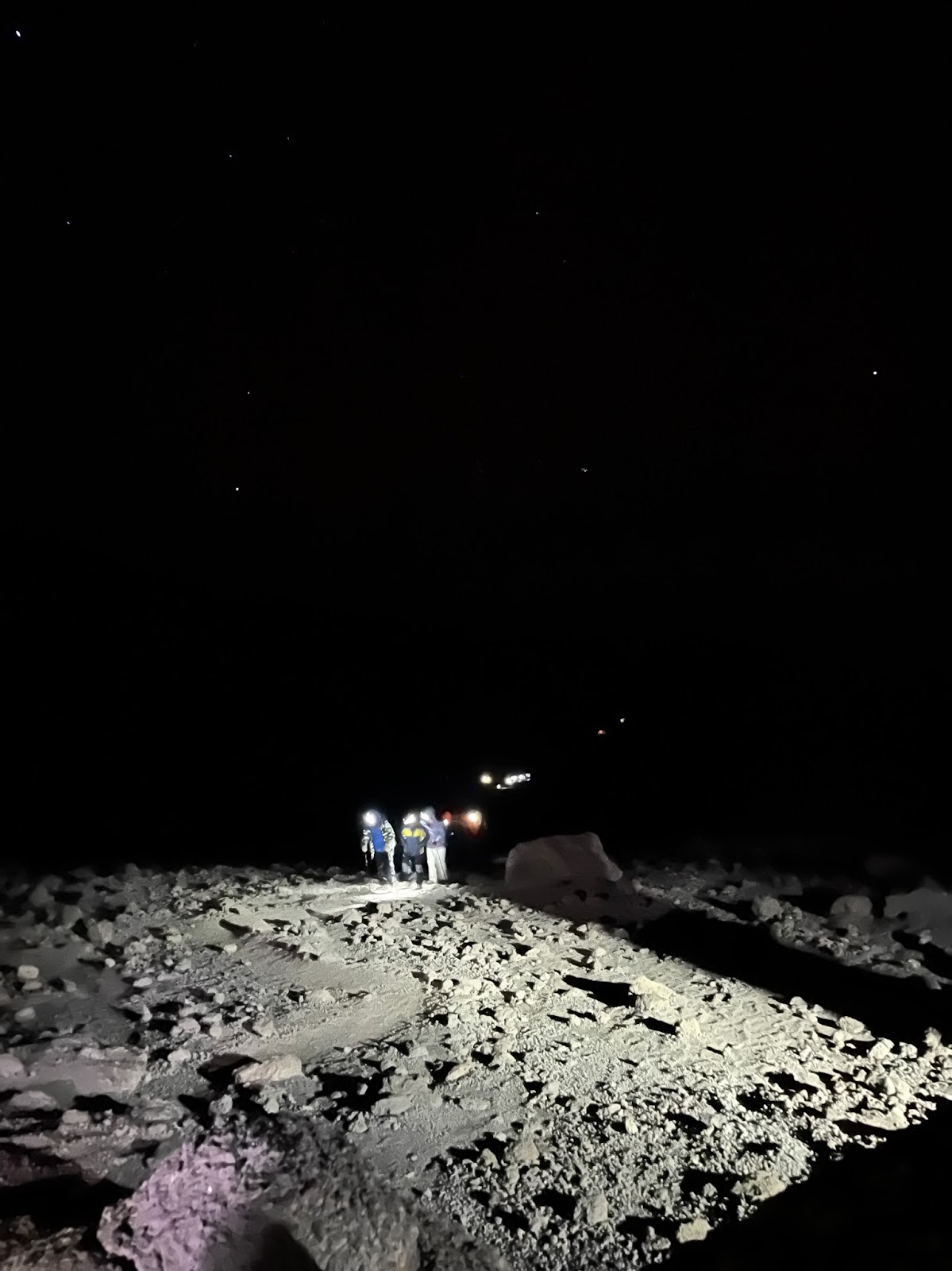
Finally, the sun started to rise and we reached Stella Point (5,756m above sea level), which is already on the edge of the mountain and now we will walk for approximately forty-five minutes to the highest point of Mount Kilimanjaro - Uhuru peak (5,895m above sea level). As soon as the sun started to rise, I suddenly woke up, I no longer wanted to sleep and I could begin to enjoy the beautiful sunrise from the highest mountain in Africa. In fact, I was expecting more snow and ice on the summit, but all I could see in the distance were the remnants of a glacier. I was enjoying the last steps to the summit tremendously, even now I had no problems with breathing or with the altitude and so I enjoyed every step until we reached our destination.
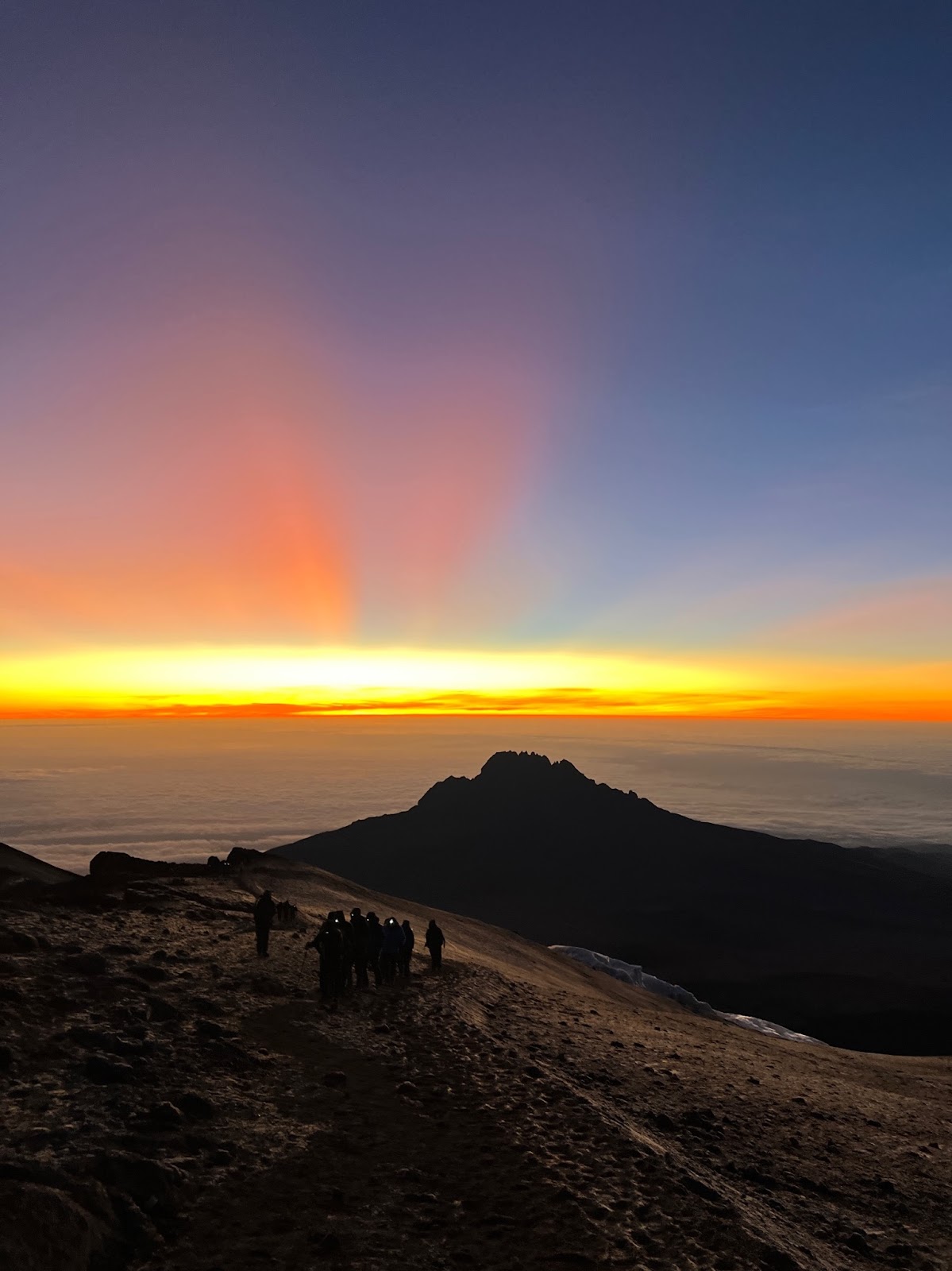
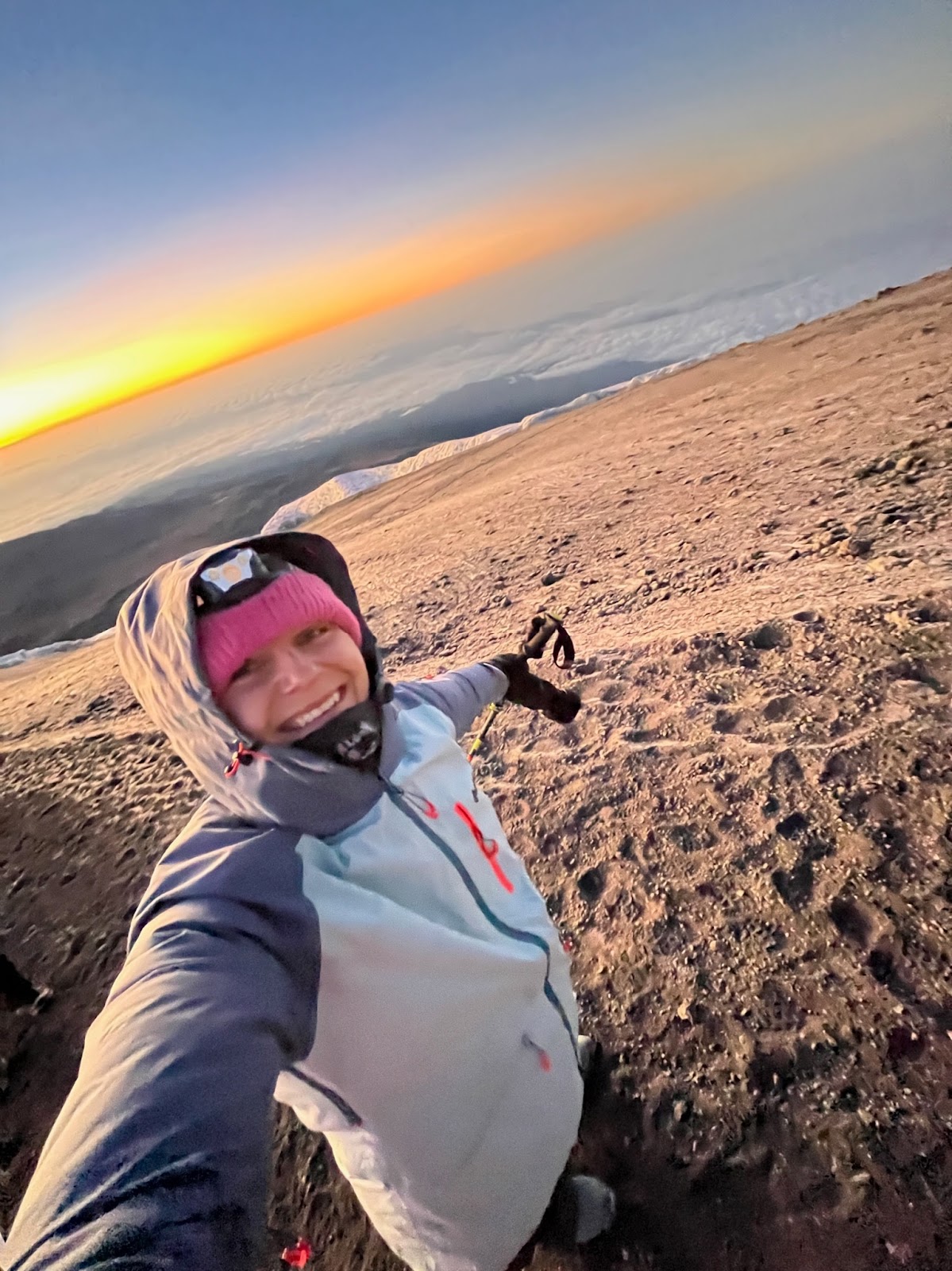
After six long hours I am finally at the top of Mount Kilimanjaro - Uhuru peak at 5,895m - woohoo we made it :)
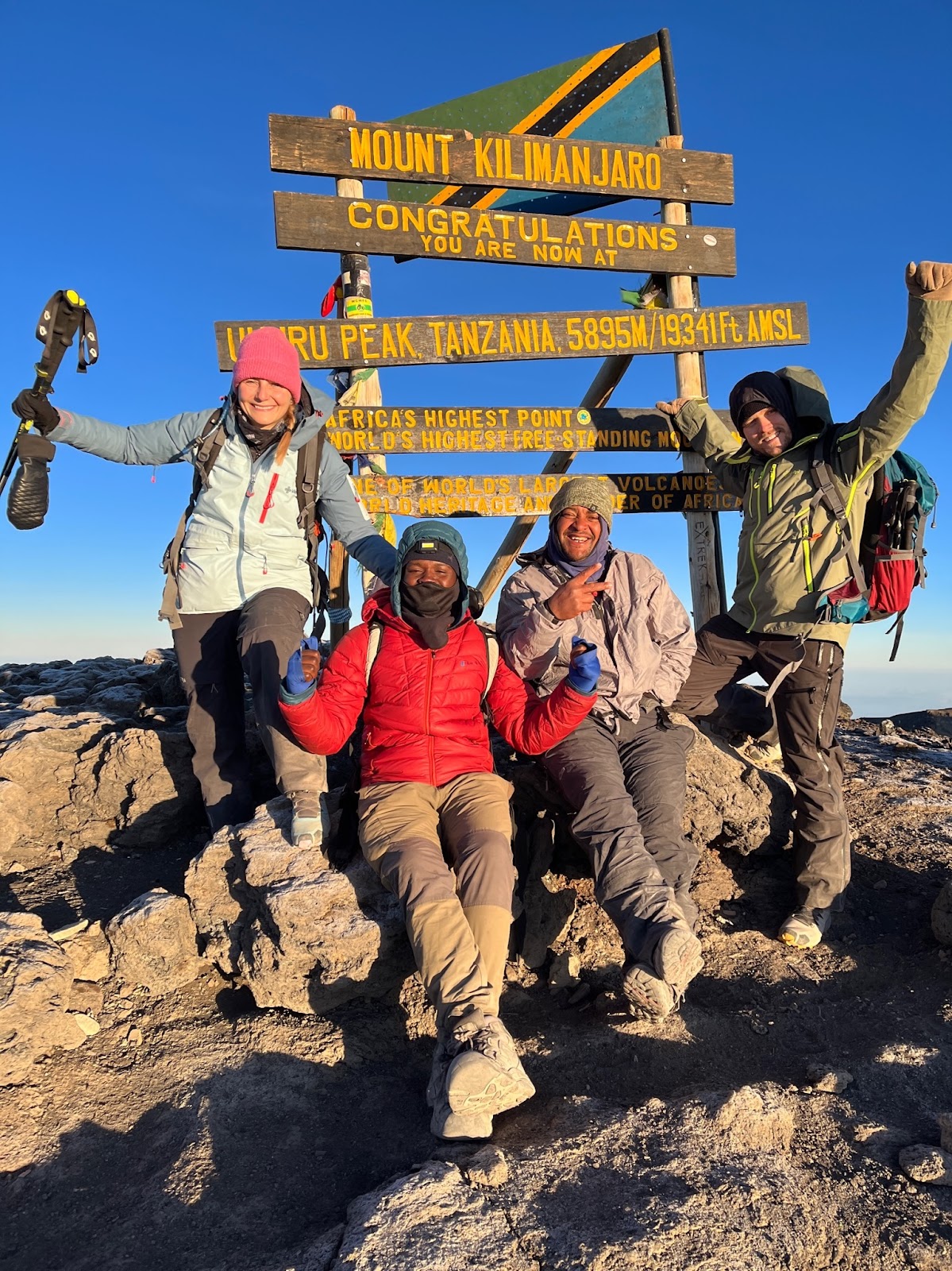
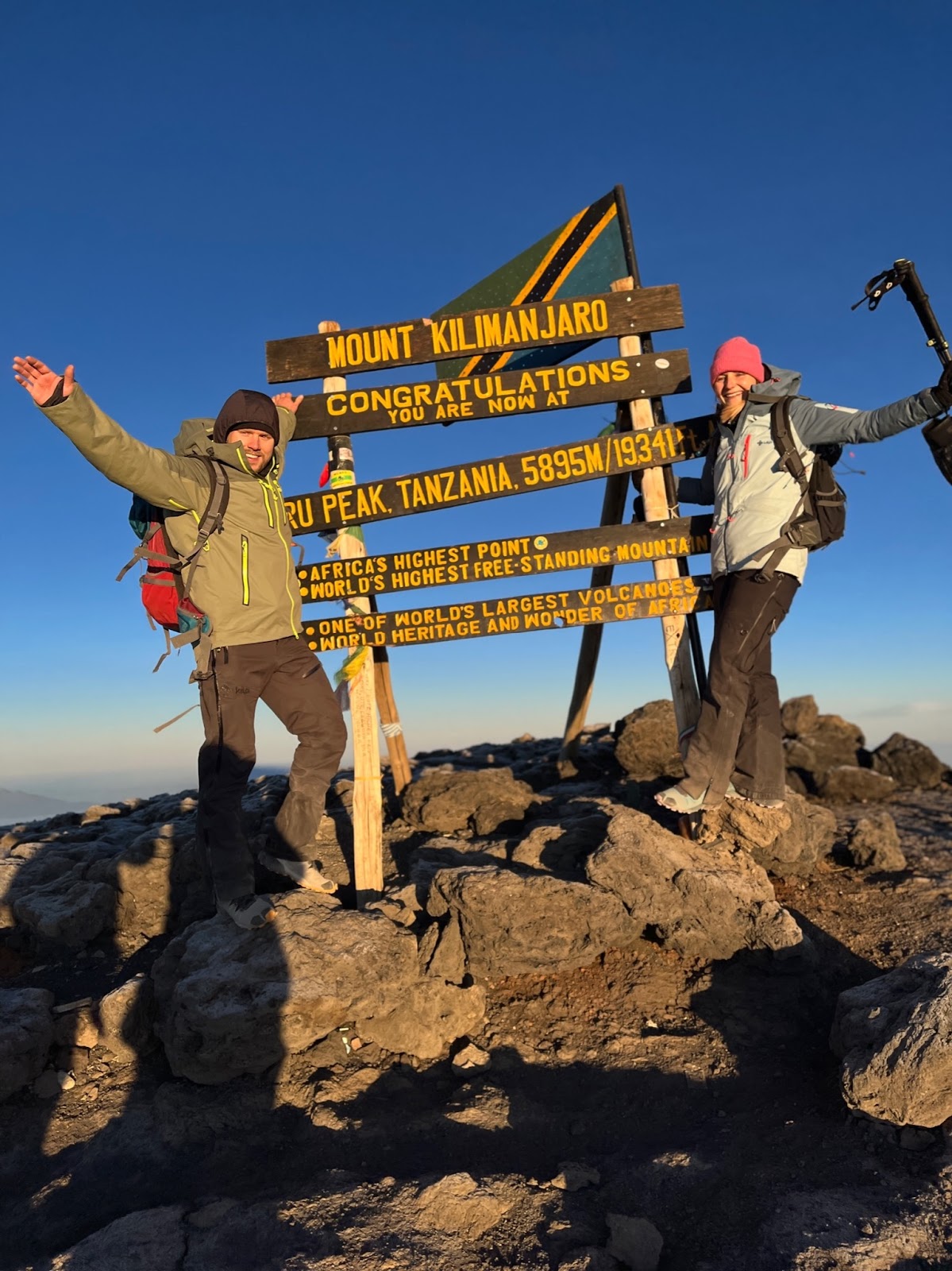
Usually, you spend between five and ten minutes on the summit, take a few photos and then go back down again, as we still have a three-hour trek back down to base camp. I couldn't stop grinning, I still somehow couldn't grasp that we had actually made it :) When we got to the edge of Stella Point and saw all the way back to camp, we couldn't believe we had walked all those hours. Since Kilimanjaro is an extinct volcano, there is volcanic dust everywhere, which had frozen at night, so it was not slippery and there was no dust. However, on our way down, the volcanic dust had thawed and we were basically skiing down the mountain, yeehaw. After two and a half hours of sliding, climbing a massive elevation, and the incredibly strong sun, I was running out of energy and was looking forward to lying down and sleeping until the following morning. Except how wrong we were, when we arrived at base camp the guides told us we had two hours to rest and then continue our descent to the next camp which was fifteen kilometres away and would take us seven hours to get there, and I thought to myself this was a sick joke. Physical and mental exhaustion was evident and I tried to fall asleep quickly at least for a while to regain some energy.
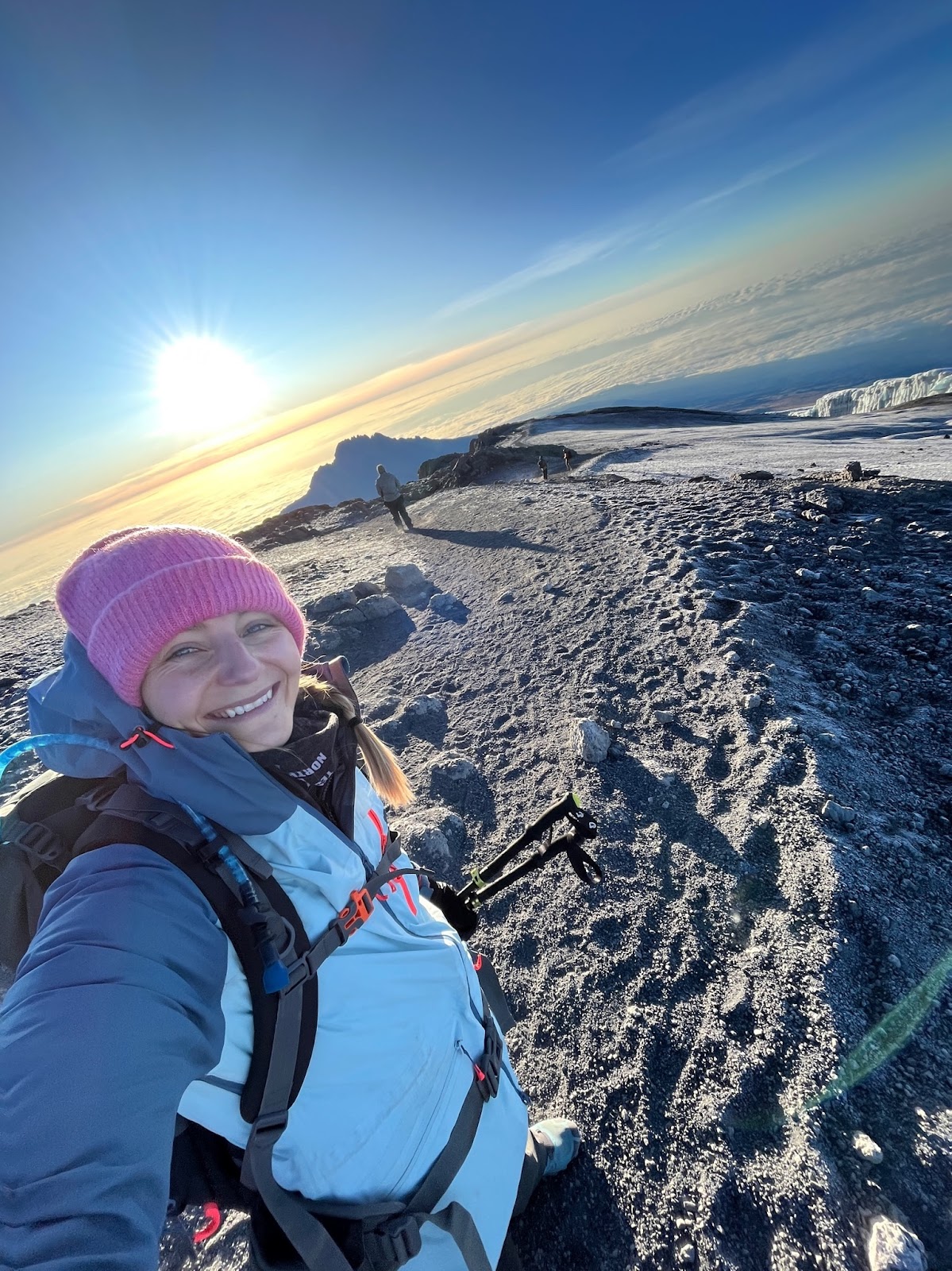
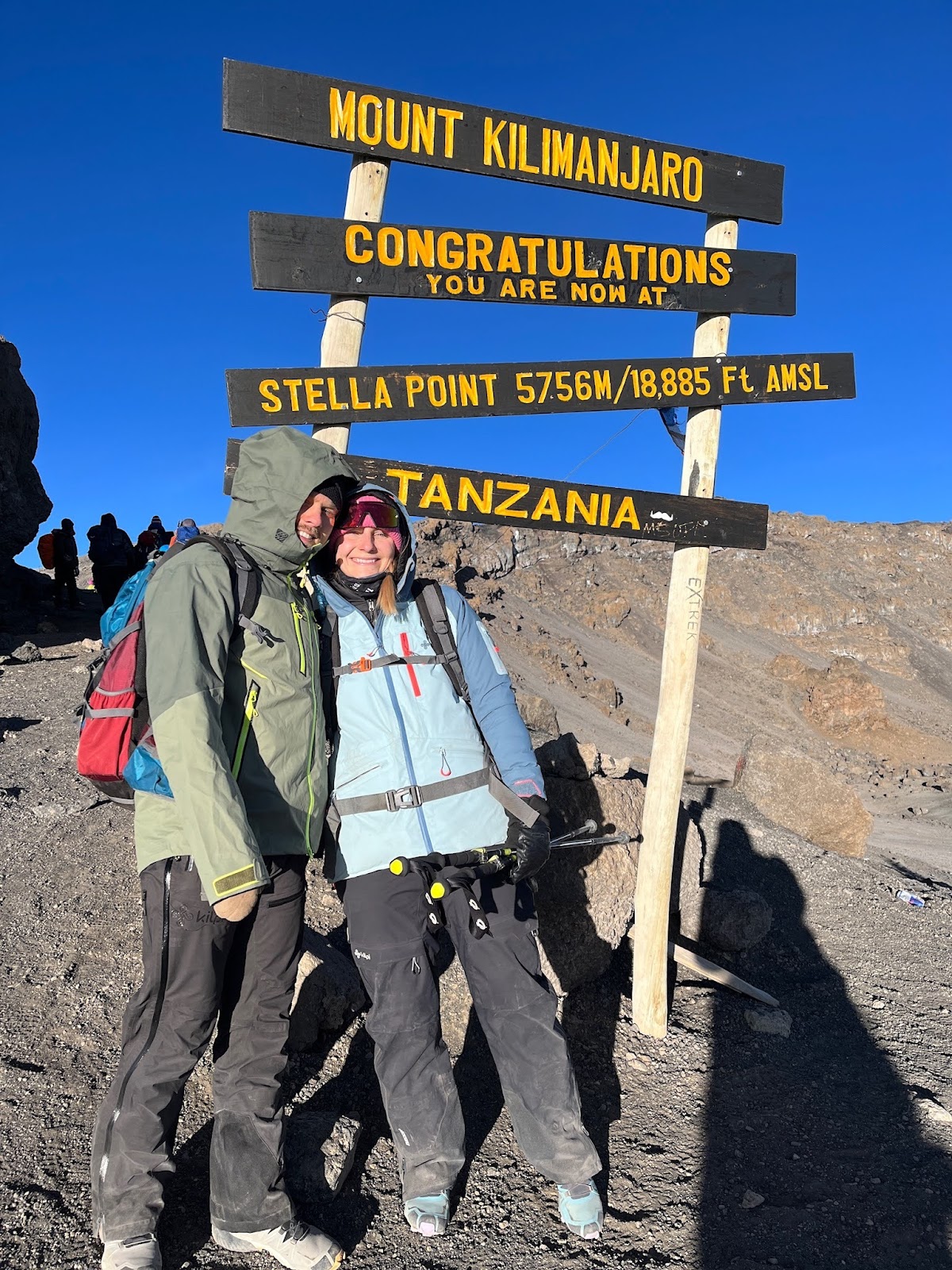
I wouldn't call it a sound sleep, but even so, this "power nap" helped me and when I realised that we had climbed Kilimanjaro a few hours ago, it gave me a mega boost and I was ready for more hours of walking again, now thankfully just downhill.
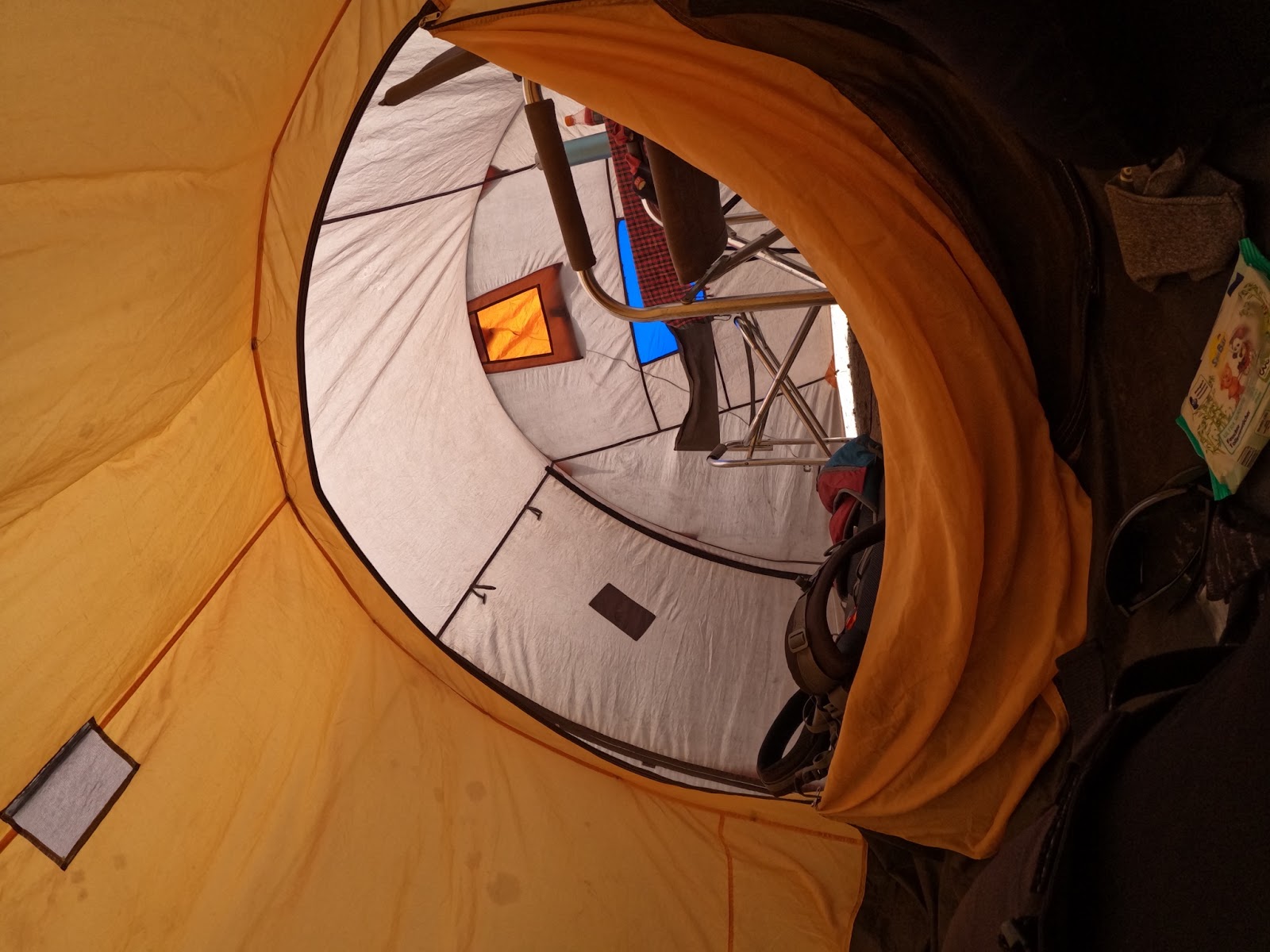
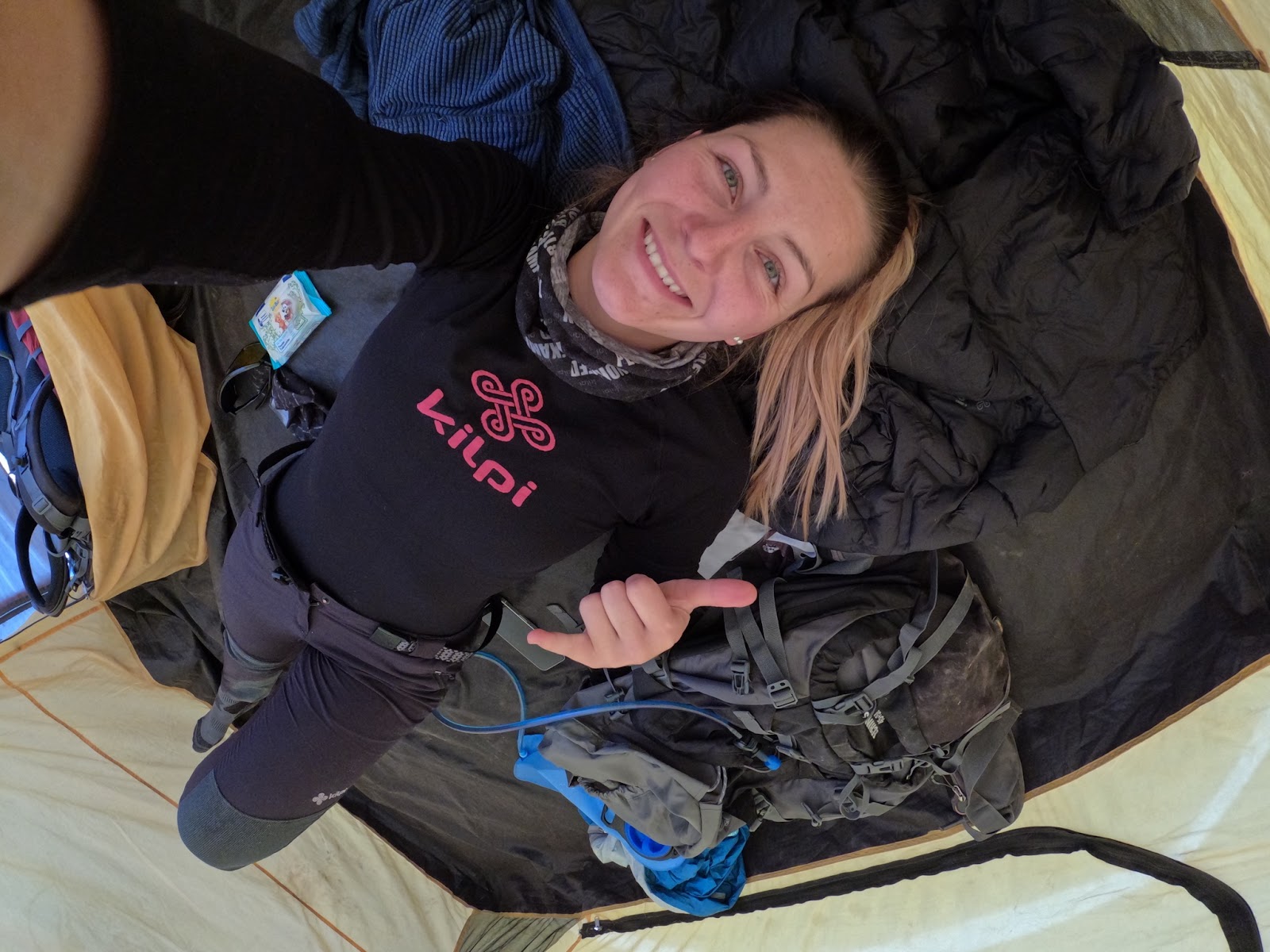
Our tempo was finally back to normal and with every step we felt that we were moving better and better. Even the landscape around us began to change as the Alpine desert slowly became a heath full of a variety of shrubs and strange flowers.
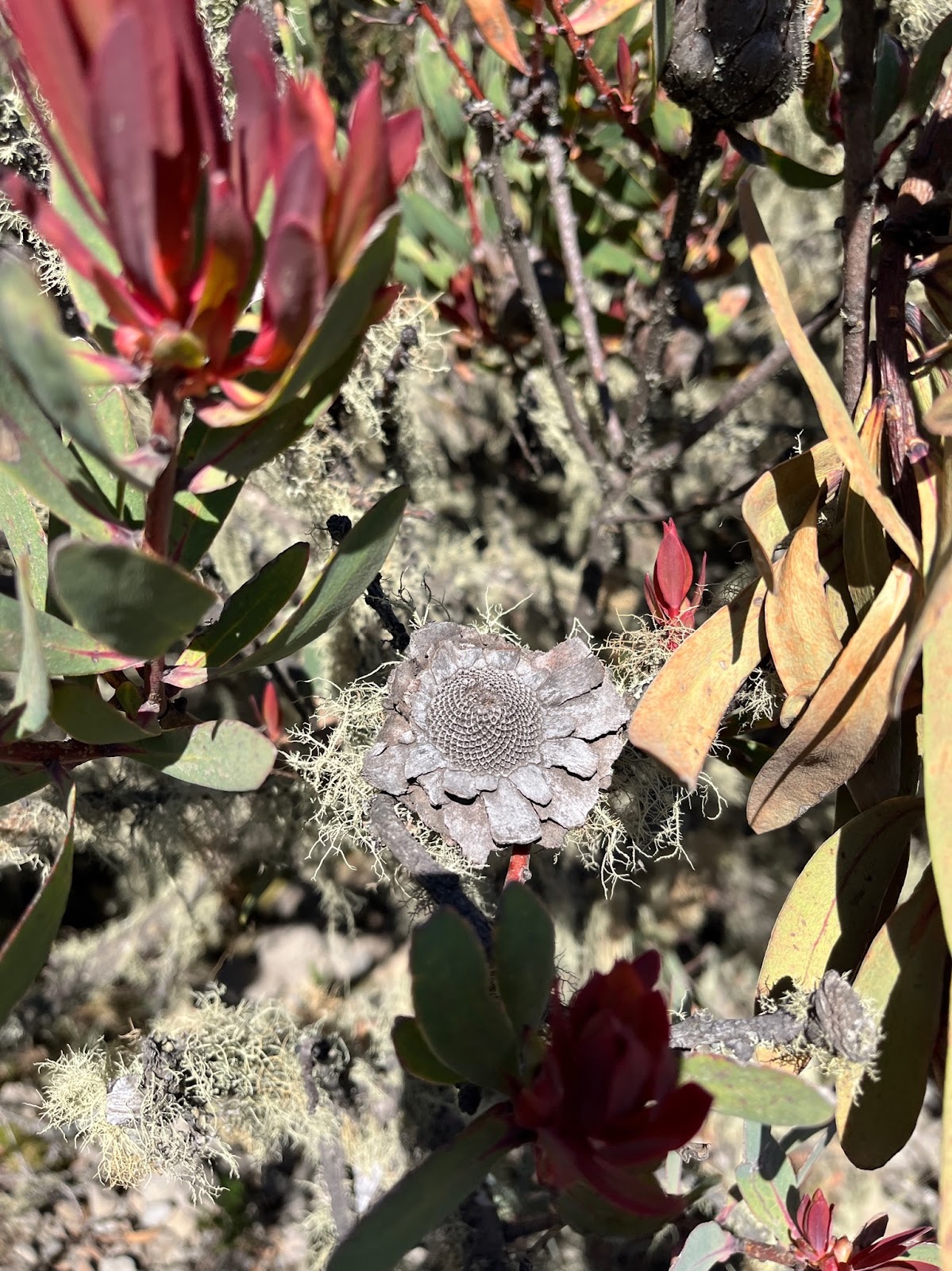
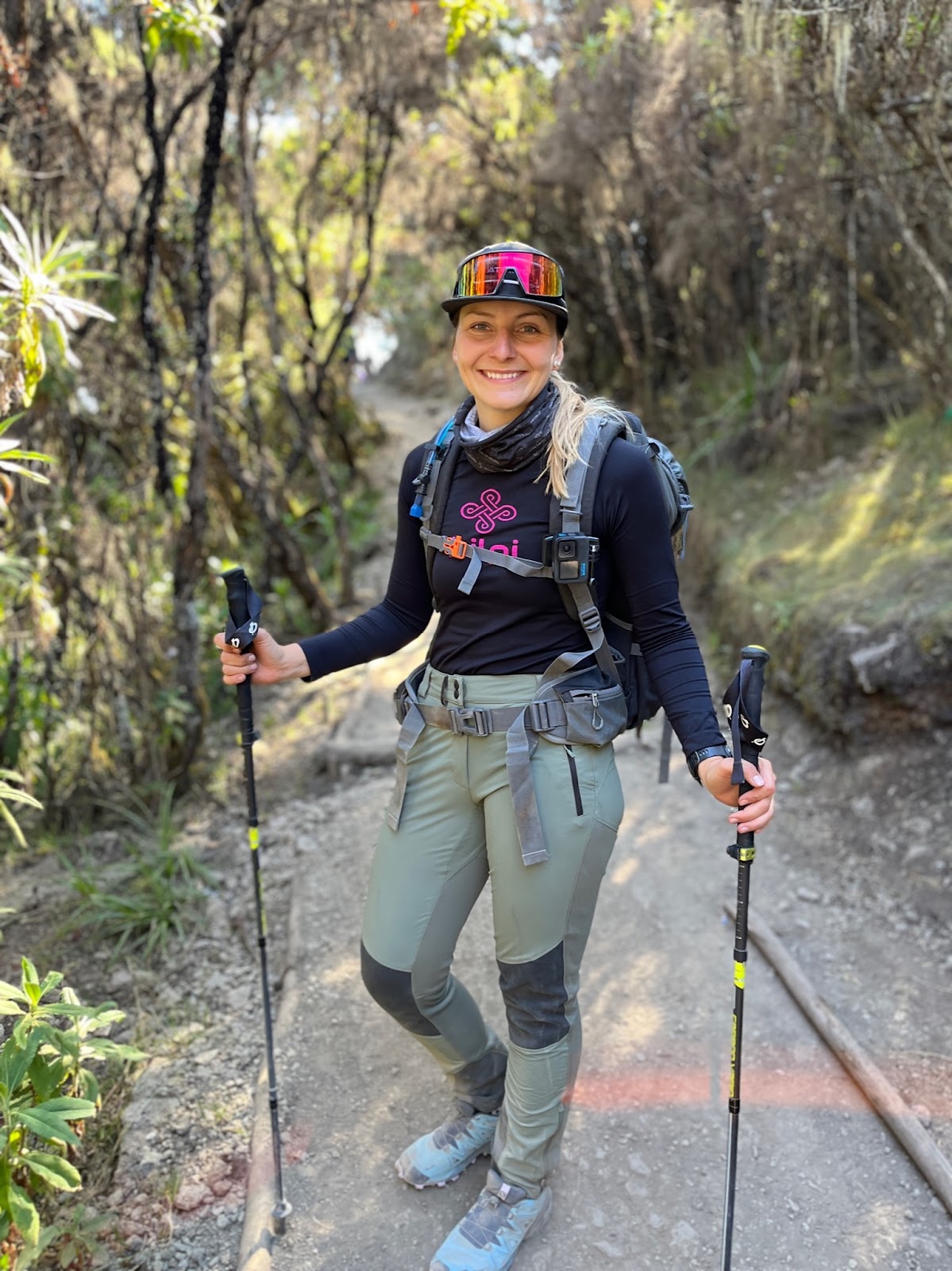
When we arrived at the Mweka campsite, we had to go through a registration process and report how long it took us to climb to the summit. After that a "wash" in a basin was awaiting us and my favourite popcorn as a snack. Unbelievable that just a few hours ago we were on the summit in -10 degrees and now we were sitting in shorts and a short sleeve T-shirt in the sun.
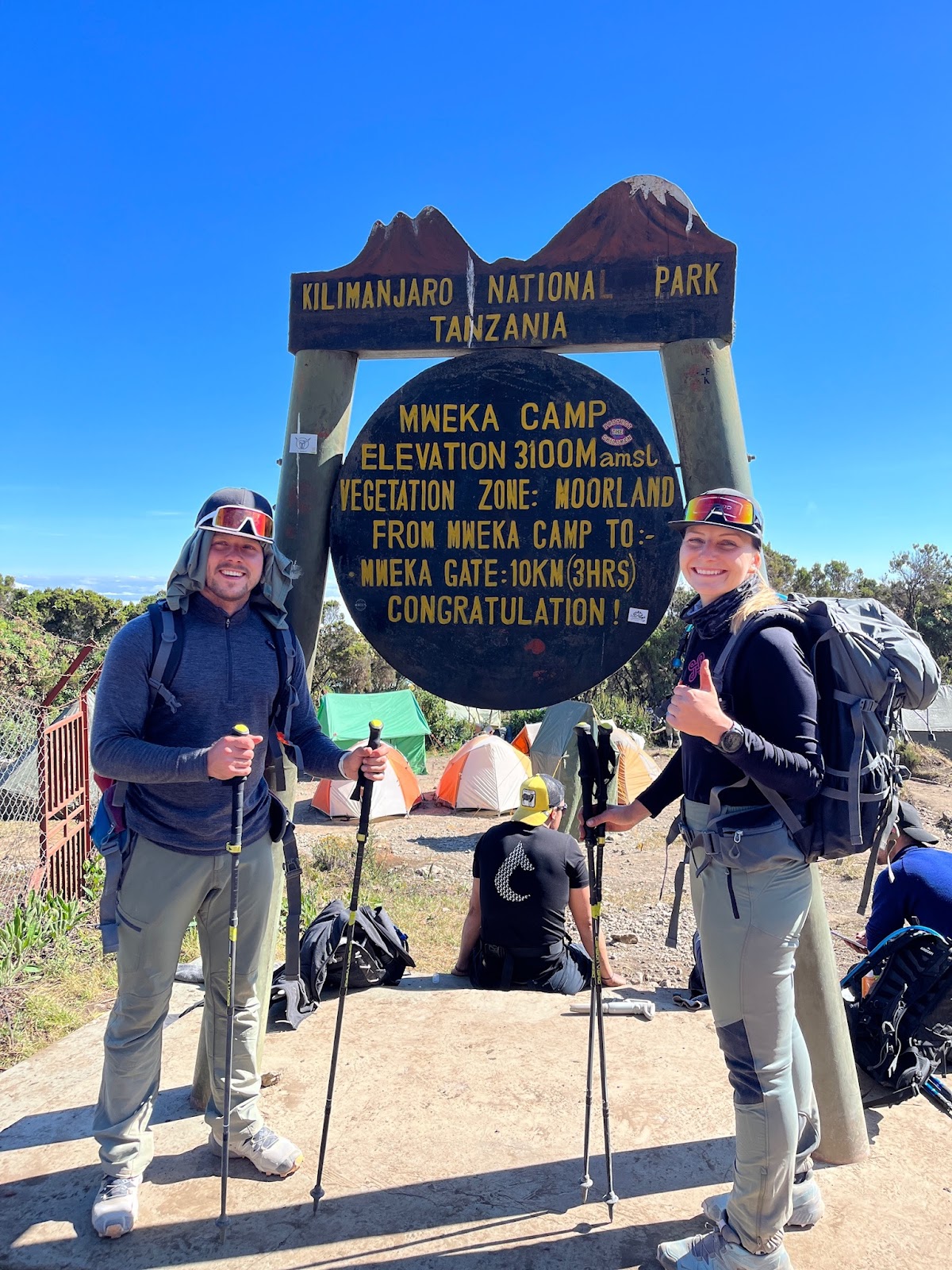
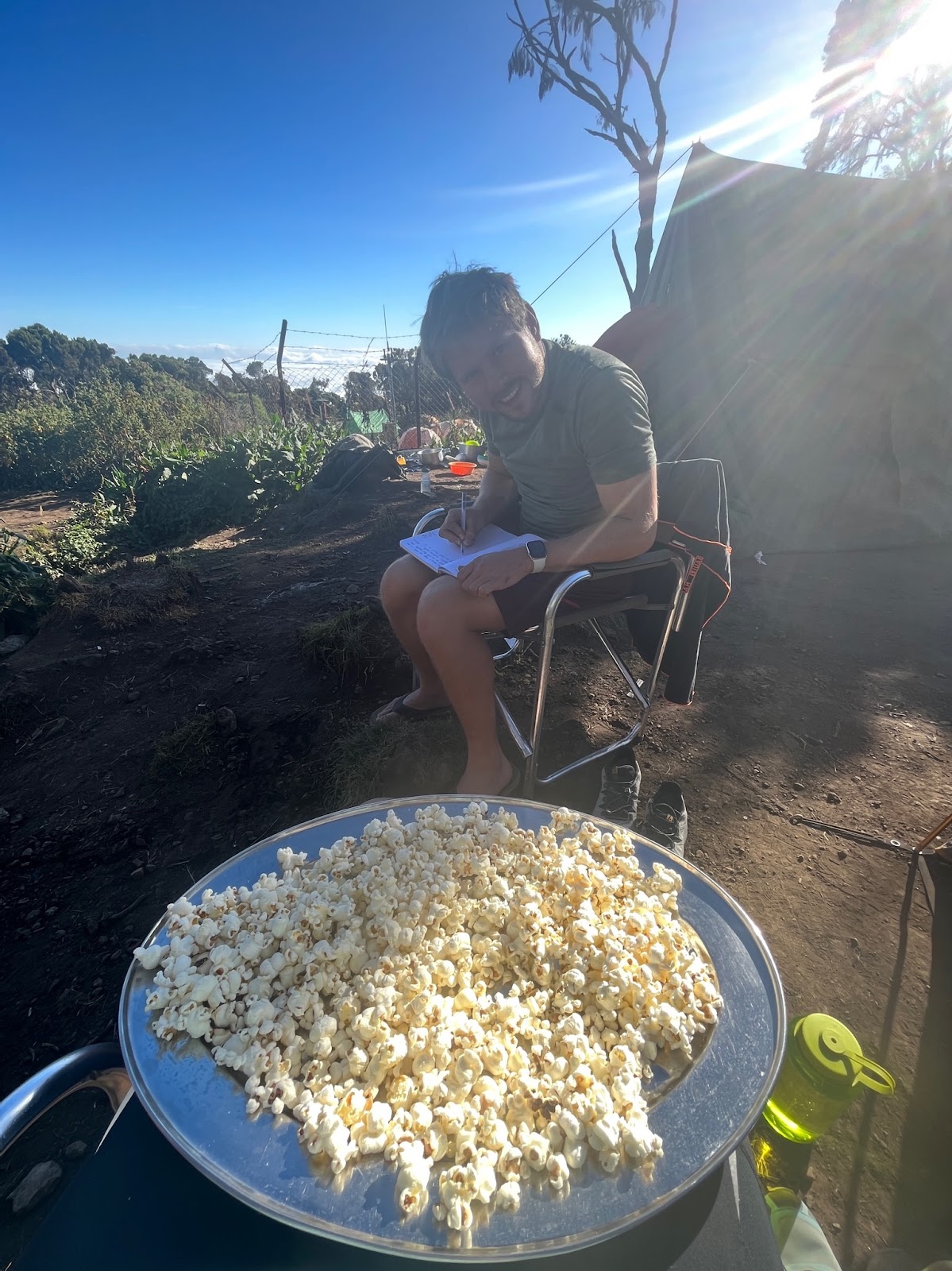
Kilimanjaro Day 6.
MWEKA CAMP -> MWEKA GATE
The sixth and last day was very relaxed and we had only the last three hours of walking (10km) through Kilimanjaro National Park left and Mount Kilimanjaro in the distance behind us. On the way we met other groups of people who had been on Kilimanjaro the day before and it was great to share our emotion and experiences with other people. We walked through the rainforest and observed several species of monkeys and parrots enjoying the view of Kilimanjaro and slowly approached the Mweka gate where our journey comes to an end. It was fantastic :)
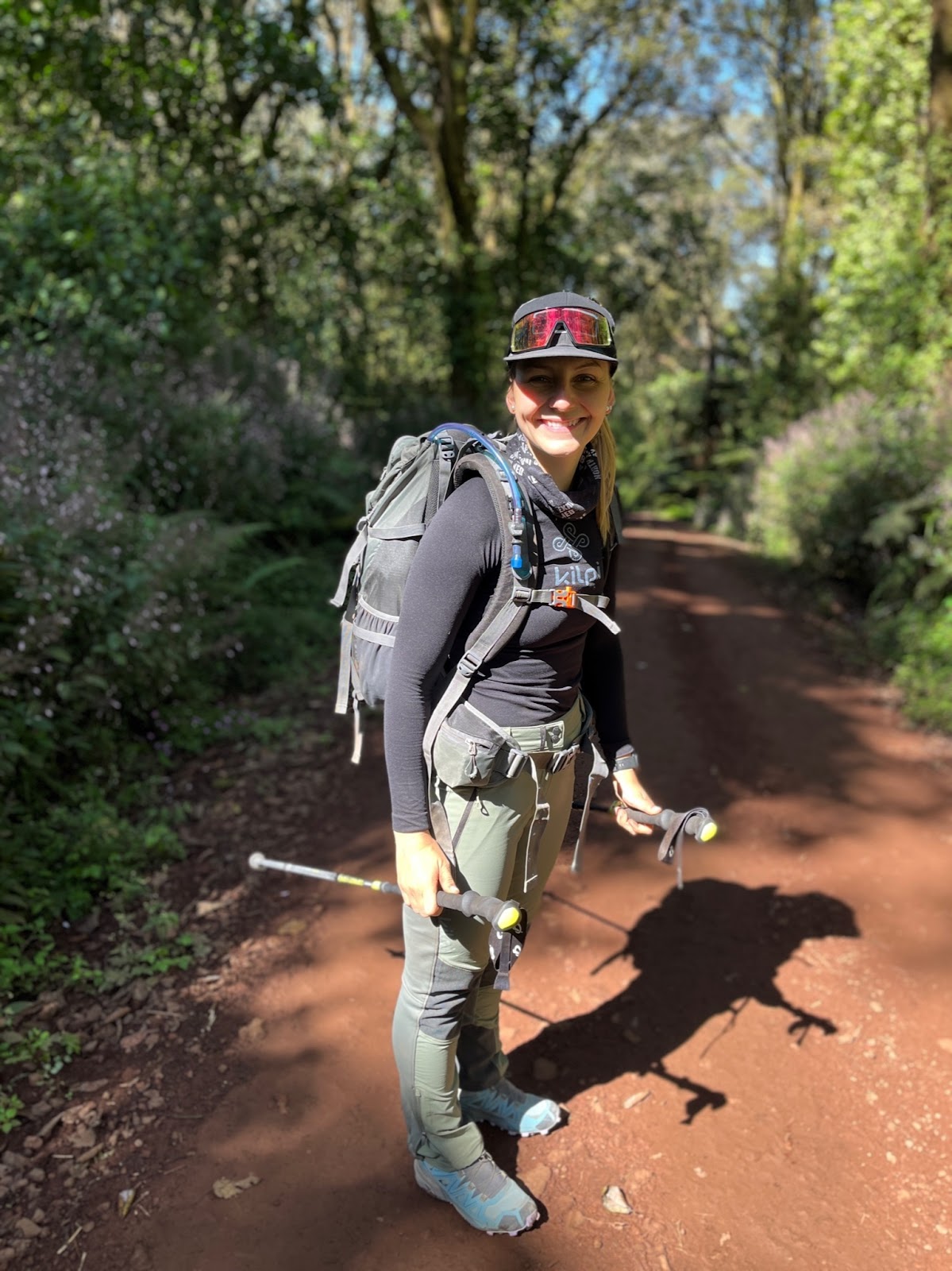
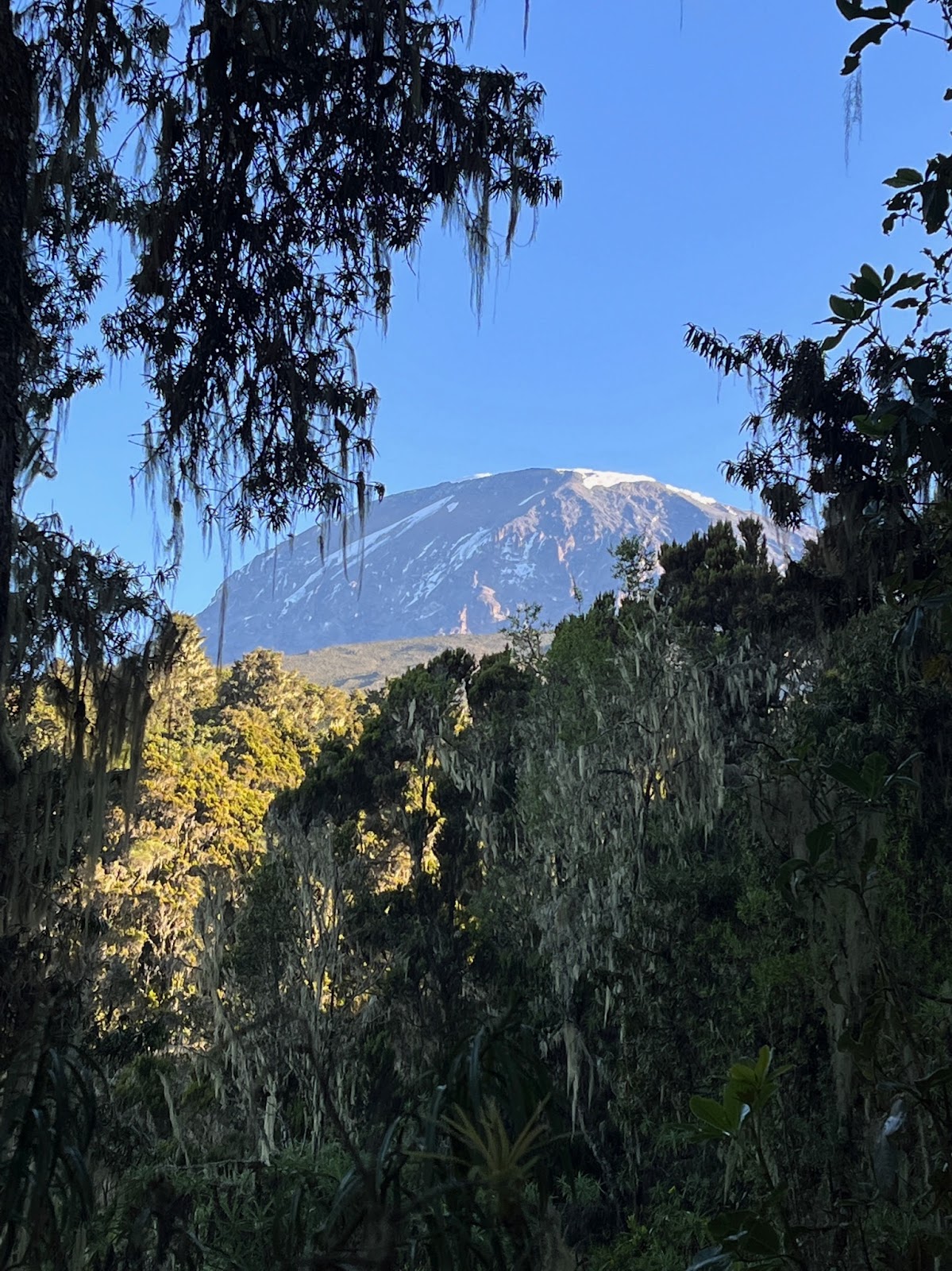

 277 279 914
(Mo–Fr: 9:00–15:00)
277 279 914
(Mo–Fr: 9:00–15:00)

